

Lighter Weight, More Travel - Trek Supercaliber Gen 2 First Ride 7
Increased travel, lighter slr frame options and a new rockshox sidluxe isostrut make the new trek supercaliber gen 2 a podium contender for any cross country racer..
T rek has been in the sub-100mm full-suspension XC bike category for several years, and in 2019, they released their first strut-designed Supercaliber featuring 60mm of rear travel and 100mm up front. Vital spent some time on the Gen 1 and praised its weight and sporty feel, but only 60mm of travel and steep (dare we say old) geometry left us wanting more. Enter 2023 and if imitation is actually flattering, the XC community confirmed as much on social media when Specialized released the 2023 Specialized Epic WC. Looking an awful lot like a Trek Supercaliber, the Instagram comments on the Specialized account giving Trek the nod were pretty entertaining. Specialized, however, wasn't using a strut design, but they had upped the ante with more travel (75mm rear) and slacker geometry; something we'd wanted in the original Supercaliber. Fast-forward five months and the new Gen 2 Supercaliber wins the travel battle (80mm rear), updates to modern XC geometry and slaps in a new, user-friendly RockShox SIDLuxe IsoStrut that is more serviceable than the FOX found on the Gen 1.

Big company drama aside, Vital had two test riders on the new Gen 2 Trek Supercaliber. Over the last few weeks, they've clocked some long local rides and even raced on the top-of-the-line, SLR 9.9 XX AXS model that we were sent. Our test bike is a World Cup XC-ready machine with a retail price of $11,699. Claimed weight for a size medium complete is 20.84 pounds. The base model Supercaliber Gen 2 starts at $4,199 and is a gallon of water heavier than our baller test bike. Trek offers 5 other XC weapons in the Supercaliber lineup, so let's get into what makes this Gen 2 Supercaliber different as well as our initial ride impressions.

Trek Supercaliber Gen 2 Highlights
- Increased travel: From 60mm to 80mm rear, 100mm to 110mm front
- Two levels of carbon frame: SLR and SL
- Improved IsoStrut suspension
- Updated geometry
- Floating brake mount
- S, M, ML, L, XL Sizes
- Weight as tested: 22.6lbs / 10.25kg - Size L with 2.4 Bontrager Sainte RSL XR front tire, Shimano XTR pedals, 2 bottle cages
- Prices from $4,199 to $11,699 (tested)

SLR SL or SL Models
Engineering Notes:
There are no differences in frame shapes between SLR and SL. Carbon laminate and cable routing features in the front triangle are the difference as the SLR and SL share the same swingarm.
The primary difference in the material is fiber aerial weight (FAW), modulus, and amount of material. The SLR has lower FAW material, additional higher modulus material, and overall less material (i.e. fewer plies).
IsoStrut Design

Trek Supercaliber Gen 2 Models, Prices and Claimed Weights

Trek Supercaliber Gen 2 Key Spec Features
- 9.9 SLR XX AXS - 20.84lb lightest build possible (size medium). Kovee RSL carbon wheels, XX SL AXS transmission, SID SL Ultimate fork, Fox Transfer SL dropper, Level Ultimate 4-piston brakes
- 9.9 SLR XTR - Kovee RSL carbon wheels, XTR drivetrain, Fox Factory 34 SC fork, Fox Transfer SL dropper, XTR 2-piston brakes, RSL bar/stem
- 9.9 SLR X0 AXS - Kovee Pro carbon wheels, XO AXS transmission, SID Ultimate fork, Reverb AXS dropper, Level Silver 4-piston brakes, RSL bar/stem
- 9.8 SLR GX AXS - SLR Frame, Kovee Elite 30 carbon wheels, GX AXS transmission, SID 110mm fork, Line dropper, Level Bronze 4 piston brakes, RSL Bar/Stem
- 9.8 SLR XT - SLR Frame, Kovee Elite 30 carbon wheels, XT drivetrain, Fox Perf. 34SC 110mm fork, Line dropper, XT 2 piston brakes, RSL Bar/Stem
- 9.7 SL - SL Frame, Kovee Comp 25 Wheels, GX AXS transmission, Reba RL 110mm fork, Line dropper, SRAM Level Bronze 2 piston brakes
- 9.6 SL - SL Frame, SLX/Deore drivetrain, Recon Gold RL 110mm fork, JD dropper, Shimano MT500 2 piston brakes

The Supercaliber uses a floating rear brake mount to isolate braking forces from the flex stays.

On the Trail and Race Course
Trek's focus on the Supercaliber is weight and going light may often mean trade-offs. Our test bike (SLR 9.9 XX AXS) is the only model in the new Supercaliber line with 2.2-inch Bontrager Sainte-Anne RSL XR tires front and rear. All the other models have 2.4 Sainte-Annes on both ends. Trek said this was to make the bike as light as possible. They also said that the SID SL Ultimate is technically only approved for tires up to 2.35 due to legal requirements around clearance. Many XC racers may not mind the stock 2.2-inch tires and SID SL Ultimate fork with 32mm stanchions as they chase seconds on the track, but it didn't take long for us to out-ride the waify configuration. For our riding style and terrain, the 2.2-inch front tire felt too sketchy, so we went outlaw and switched to a 2.4 Sainte-Anne (the same Bontrager model as our stock 2.2). We had no problems with clearance on the fork (it's literally 1.27mm wider than allowed), but perhaps muddy conditions could prove problematic. We left the stock 2.2-inch Sainte-Anne on the rear.

The SID SL Ultimate fork felt a bit flimsy in rough conditions for our 175 lb testers. It has a 32mm chassis and weighs 1352 grams. The next bike down in the Supercaliber line, the SLR 9.9 X0 AXS, comes with a much stiffer SID Ultimate (35mm chassis, 1476 grams). Whether the weight savings is worth it will depend on your terrain and priorities.

The two-position fork and shock lockout on the SID and SIDLuxe IsoStrut worked well. Some riders may instinctively want a middle setting, but we found the two positions to be ideal. In the open setting, the pedaling efficiency was stellar without the bike feeling harsh like a hardtail. GripShift suspension lockout control was easy to use and left room for a full-size dropper lever. Compared to other XC bikes, the lockouts on the Supercaliber are barely necessary because of the bike's efficiency, but more of a "nice to have" for out-of-the-saddle sprints or long, smooth stretches.

By the numbers, the Supercaliber's 80mm of rear travel puts the bike in between a standard 100mm/110mm XC bike and a hardtail. In reality, this speedster is closer to being the best of both worlds - great pedaling efficiency combined with reasonable comfort and descending capability.

Riding position on the Supercalber is aggressive, but not uncomfortable and both of our testers (5'10" and 6') felt very comfortable on our size large. The one-piece Bontrager bar/stem combo geometry is locked in, save trimming width or adjusting stem height on the steer tube, so finicky riders with specific cockpit tastes should be advised. Head tube angle has slackened by 1.5 degrees, reach has grown 10mm across sizes and chainstay lengths have grown making for a stable, planted ride. While the seat tube angle steepens by half a degree, the standover height drops with a lower intersection between the seat tube and top tube.

Even with their quest for weight savings, thankfully Trek spec'd a dropper post on all models. Neither of our testers ride fixed seatposts. Our test bike was decked out with all the best SRAM and RockShox components but had a FOX Transfer SL instead of the RockShox Reverb AXS (found on the 9.9 SLR X0 AXS model) because of the weight difference.

What's the Bottom Line?
Both Vital testers, who regularly race XC and often take on longer endurance rides and events, said they would buy this World Cup-winning bike. If you're not a cross-country racer, in its stock trim, our Supercaliber SLR 9.9 XX AXS probably isn't for you with svelte 2.2-inch tires and a 32mm SID SL fork. Our Supercaliber 9.9 SLR test bike has shaved every gram and is bred for the race track, ready to tackle most XC race courses. For those wanting a little more diversity out of the bike, Trek offers Supercaliber models in both SLR and SL frame constructions with 2.4-inch tires and RockShox SID forks using 35mm stanchions. These weapons should handle any cross-country terrain and will even let you dabble in some legit backcountry epics.
Hit up www.trekbikes.com to shop the new Supercaliber Gen 2.
View key specs, compare bikes, and rate the new Trek Supercaliber in the Vital MTB Product Guide.

Supercaliber Gen 2 FAQ Supplied by Trek
What is different about the frame compared to the previous generation of Supercaliber?
The frame is completely new to make it a more capable bike without sacrificing any of the speed. The travel has been increased from 60mm to 80mm rear travel and the front suspension has increased from 100mm to 110mm. The geometry has been updated with a slightly longer reach and slacker headtube angle. There are now two unique Supercaliber frames. There is a lightweight SL frame and a super lightweight SLR Supercaliber frame. The frames look identical, however, the SLR frame has a lighter carbon layup and does not have the internal cable routing guides on the mainframe. There is also a new RockShox SIDLuxe IsoStrut on all models.
What is the rear brake mount? What is the max rotor size?
160mm direct post mount. Minimum and maximum rear rotor is 160mm.
How much dropper post insertion does the frame have?
SM – 215mm MD – 225mm M/L – 250mm LG – 270mm XL – 330mm
What is the hub spacing?
The frame uses 148mm hub spacing and has a Universal Derailleur Hanger (UDH) for SRAM Eagle Transmission compatibility.
Which frame will be available as a frameset?
The lighter-weight SLR frame will be offered as a frameset.
What is the maximum fork axle-to-crown and/or travel?
The bike is designed for a 110mm travel fork, but it is compatible with 100 and 120mm forks. This allows the rider to choose the fork and travel that best suits their preference for geometry, weight, and performance. The maximum axle-to-race is 525mm.
Is there any downtube protection?
Yes. There is a clear 3M adhesive film placed on the underside of the downtube to protect the frame and paint from downtube strikes.
Is it compatible with SRAM T-Type transmissions?
Yes. It has a universal derailleur hanger that can be removed and a hangerless T-Type transmission used in its place.
What is the seat tube dimension?
Wheels & tires
What size tire is spec’d on the bikes?
All models get 29 x 2.4” tires except for the Supercaliber SLR 9.9 XX SL T-Type which has 29 x 2.2” tires on it to help save weight and because the new RockShox SID SL fork on that model has a max clearance for 29 x 2.35” tires.
Is it compatible with other wheel/tire sizes?
No. The bike is designed around fast-rolling 29” wheels on all sizes.
What is the maximum tire size?
Frame: 2.40" Fork: See manufacturer
Are these bikes tubeless compatible? What additional parts are required?
Yes. All models are tubeless out of the box. They include TLR strips, valves and sealant.
Can tubeless inserts be used with Supercaliber?
Yes, tire inserts can be installed if desired.
What type of bottom bracket does it use?
Like the previous generation, it uses a press-fit 92 bottom bracket.
Is it compatible with cranks with 30mm spindles?
Yes, but you'll need to supply your own 30mm bottom bracket and compatible crank.
What is the maximum chainring size? Minimum chainring size?
55mm chainline only. Min chainring is 30T, max chainring is 38T
Is the new frame compatible with the previous FOX IsoStrut?
No, the frame is only compatible with the new RockShox SIDLuxe IsoStrut due to several dimensional changes (eye-to-eye, stroke, diameter).
What is the recommended sag for the new RockShox IsoStrut?
New Supercaliber was designed around 25% IsoStrut sag for a balanced level of rider efficiency and suspension response. Riders can also adjust setup pressure throughout the 15-35% sag range, as marked on the new RockShox IsoStrut, to fine-tune their setup based on preference and riding conditions. Higher pressure/less sag = higher ride height and firmer and a more efficient pedaling bike, while lower pressure/more sag provides lower ride height and softer and more compliance through rough terrain.
Is there any special suspension setup knowledge needed for the RockShox IsoStrut?
There are sag gradients marked on the strut to help you easily set up and tune your preferred sag.
Also, the IsoStrut rebound has numeric labeling: 10 is slow rebound and 1 is fast rebound. Ya know, just like the podium, you're racing for. #1 is fastest and higher numbers are slower. (Hope that helps you remember.)
Are there IsoStrut air volume spacers?
Yes. However, installing the RockShox air volume spacers is different than FOX. A walk-thru is available on Trek U.
Can all sizes fit 2 water bottles?
Yes, all sizes can fit 2 water bottles – 1 on the seat tube and 1 on the downtube.
Are there any unique tools required for this frame?
There is a unique bushing tool needed for service. See the Supercaliber service manual for details.
What is the warranty?
Standard Trek warranty. Lifetime for the main frame of the original owner. More details here
View replies to: Lighter Weight, More Travel - Trek Supercaliber Gen 2 First Ride

Most Popular
USA CYCLING ANNOUNCES TEAM COMPETING AT 2024 PAN AMERICAN MOUNTAIN BIKE CHAMPIONSHIPS
VIDEO: ‘NICE AND EASY’ WITH CALEB HOLONKO
FANTIC XEF 1.9 FACTORY ELECTRIC MOUNTAIN BIKE REVIEW
USA TAKES A DOMINANT ROLE IN THE WORLD CUP POINTS BATTLES FOR 2024
- VIDEO: ‘DOG DAZE’ EP 1 WITH RYAN “R-DOG” HOWARD – FREERIDE NEW ZEALAND
- DON’T JUDGE A TRAIL BY ITS RATING
EVIL LOOPHOLE WHEEL REVIEW – A CRACKING GOOD SET OF CARBON WHEELS
ASK MBA: WHAT’S THE BEST WAY TO FLY WITH MY BIKE?
- FIRST RIDE IMPRESSIONS: CANYON NEURON:ONFLY LIGHTWEIGHT ELECTRIC MOUNTAIN BIKE
VIDEO: ‘OFFSEASON’ PART 2 WITH EMMY LAN IN VANCOUVER ISLAND

TREK SUPERCALIBER GEN 2 FIRST RIDE REVIEW – THE FASTEST XC RACE BIKE WE’VE EVER RIDDEN?
Trek's new cross country race bike has the speed racers dream of..
TREK SUPERCALIBER GEN 2 FIRST RIDE REVIEW
When Trek released the Supercaliber in 2019 with its integrated IsoStrut shock the wrecking crew was impressed by its light weight and strong acceleration calling it a full-speed-ahead cross-country race bike. It is truly a racers mountain bike and this was proven multiple times at the highest levels. Not one to rest on its laurels, Trek has introduced a second generation of the Supercaliber with a completely new frame with more travel and evolved features to take on the highest levels of racing.

Although it may look similar, this second-generation Supercaliber frame is entirely new. Geometry is revised with a 10mm longer reach, 1.5-degree slacker head angle, half a degree steeper seat tube angle, and 7mm taller bottom bracket height in the size large. The chainstay length also grows by 5mm. All of these updates combine for a 17mm longer wheelbase.

There are also now two versions of the frame: SLR and SL. The SLR is the lightest coming in at a claimed 200-250 grams lighter than the current 2,030-gram version while the SL is about the same weight. Both frames share the same new lightweight swingarm with an all-new floating brake mount that Trek says isolates braking forces from flexing rear stays for improved braking performance
The lighter SLR frame does not feature internal cable tunnels to save weight and is found on Supercaliber 9.8 SLR and 9.9 SLR models that come speced with a wireless drivetrain spec, carbon 1-piece bar/stem and carbon wheels. Supercaliber 9.6SL and 9.7 SL models feature frames with internal tunnels for easier cable routing along with alloy wheels and cockpit components. Two water bottles can fit on the frame – one on the seat tube and one on the downtube. We noticed that the new version has a standard headset and not the Nock Block style of the previous version too – we assume to save weight.

Trek’s IsoStrut suspension design is improved on the new Supercaliber increasing in travel and receiving an all-new RockShox SidLuxe IsoStrut. Rear wheel travel gets a bump from 60mm to 80mm while the front jumps 10mm from 100mm to 110mm. It is also compatible with 100mm and 120mm forks. The strut’s stroke increases by 7.5mm to 40mm to gain the travel – a move that Trek says does not sacrifice fitment or weight.

A higher linear leverage rate is also new and ideal for XC performance according to Trek. Sag can be set at the standard 25% for a good all-around feel, as low as 15% for more pedaling efficiency, or as high as 30% for added compliance. Anti-squat is also increased on the new model for better resistance to suspension compression while pedaling. The new IsoStrut is also easier to service requiring no special tools or clocking like the old one.
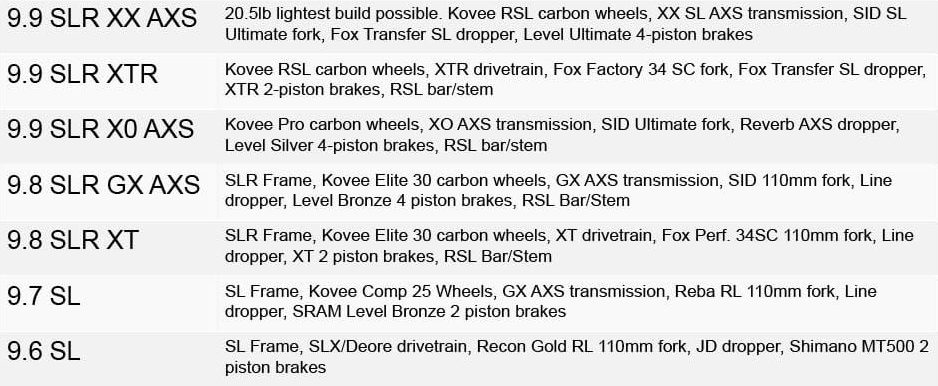
RIDE IMPRESSIONS
Trek will offer seven models of the Supercaliber starting at $4,200 and topping out at $11,700 for their highest-end build and our test model – the 9.9 SLR XX AXS . The size large hit our scales at 21.8 pounds. We passed the bike around to a few test riders each getting a couple of days on the new bike. After their first ride, one was already calling it the fastest bike he had ridden – that’s saying something given the recent crop of test bikes that have passed through our offices lately.
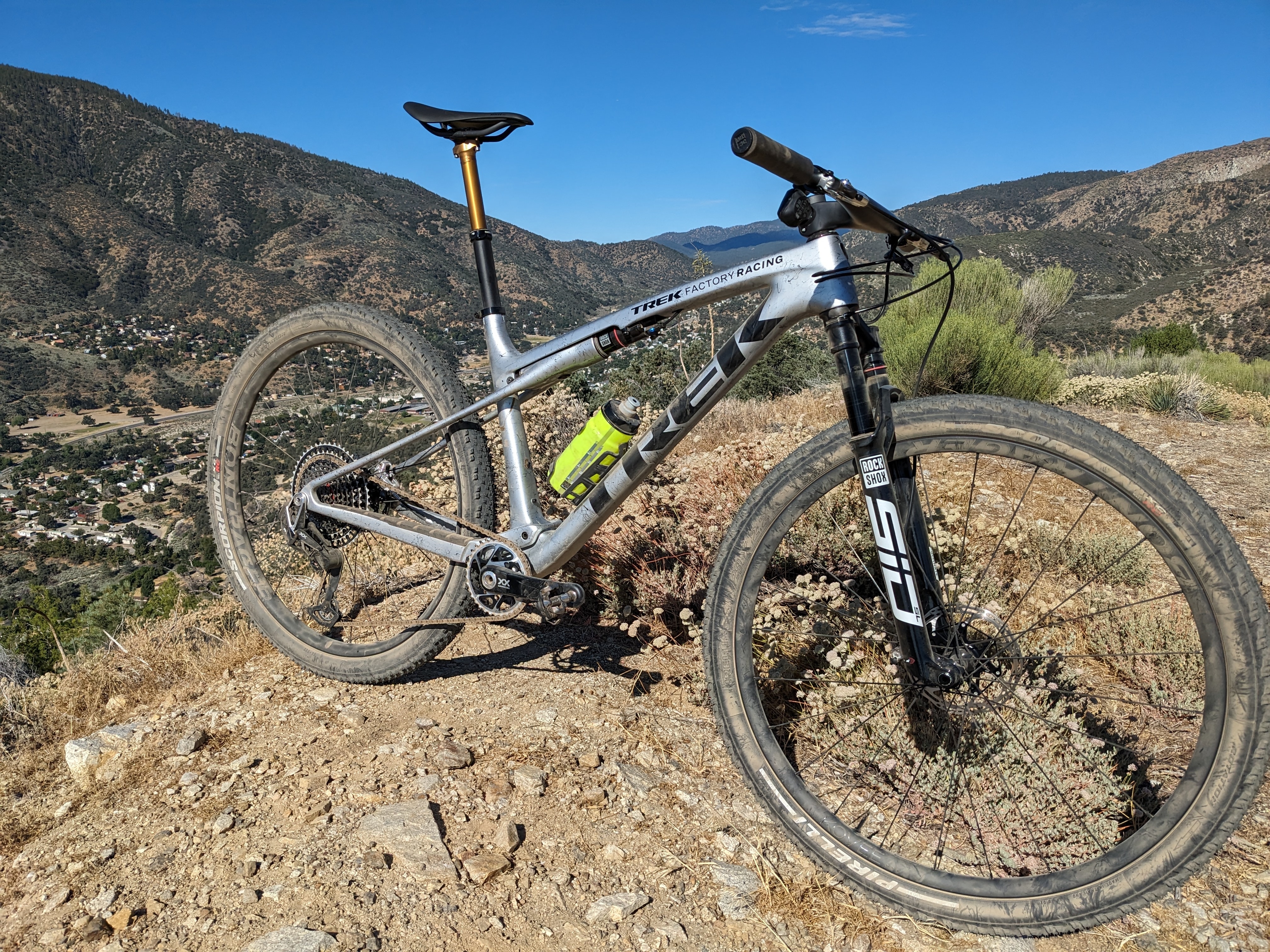
It’s extremely quick on acceleration both in and out of the saddle and with the suspension open. Some even joked that it felt somewhat similar to a lightweight eMTB. They are joking but the sensation isn’t far off. Seated pedaling is also incredibly efficient. The suspension is quiet but moves just enough over bumps and roots to keep you planted in the saddle and driving forward. The frame is solid under power without feeling overbuilt or too rigid too. It has a lively energy to it.

Descending is equally as impressive as the climbing performance. With the longer wheelbase, slacker head angle and increase in travel, we were able to get pretty aggressive on the Supercaliber. It’s still an XC race bike and reminds you of this when it runs out of travel but you can get away with a lot up until that point. This is no wannabe trail bike in XC clothing – it’s a full-on racer and a very capable one at that.

Cornering on flat turns takes a touch more careful front wheel weighting compared to steeper, shorter bikes but we adapted quickly. Our test bike came with 2.25” tires because the max tire size for the SID SL fork is 2.35”. We will be trying some higher volume tires soon that should greatly help with grip on our bone-dry So Cal terrain. Initally we set the suspension up the bike with 25% sag but also plan on trying the range as we test. With only a few rides under our belts, everybody who has ridden the new Supercaliber has come away seriously impressed and wants more time on it. Stay tuned to the pages of Mountain Bike Action for a full long-term review.
VIDEO: CORY WALLACE EXPLORES GUATEMALA IN “THE NOMAD”
UCI WORLD CHAMPIONSHIP: SHORT TRACK XCC RESULTS

mountainbikeaction
- Since 1986 - Covering All Aspects of ⛰🚲 #MBAmagazine

We and our {{count}} partners use cookies and other tracking technologies to improve your experience on our website. We may store and/or access information on a device and process personal data, such as your IP address and browsing data, for personalised advertising and content, advertising and content measurement, audience research and services development. Additionally, we may utilize precise geolocation data and identification through device scanning.
Please note that your consent will be valid across all our subdomains. You can change or withdraw your consent at any time by clicking the “Consent Preferences” button at the bottom of your screen. We respect your choices and are committed to providing you with a transparent and secure browsing experience.
Privacy Overview
- Most purposes explained in this notice rely on the storage or accessing of information from your device when you use an app or visit a website. For example, a vendor or publisher might need to store a cookie on your device during your first visit on a website, to be able to recognise your device during your next visits (by accessing this cookie each time).
- A car manufacturer wants to promote its electric vehicles to environmentally conscious users living in the city after office hours. The advertising is presented on a page with related content (such as an article on climate change actions) after 6:30 p.m. to users whose non-precise location suggests that they are in an urban zone.
- A large producer of watercolour paints wants to carry out an online advertising campaign for its latest watercolour range, diversifying its audience to reach as many amateur and professional artists as possible and avoiding showing the ad next to mismatched content (for instance, articles about how to paint your house). The number of times that the ad has been presented to you is detected and limited, to avoid presenting it too often.
- If you read several articles about the best bike accessories to buy, this information could be used to create a profile about your interest in bike accessories. Such a profile may be used or improved later on, on the same or a different website or app to present you with advertising for a particular bike accessory brand. If you also look at a configurator for a vehicle on a luxury car manufacturer website, this information could be combined with your interest in bikes to refine your profile and make an assumption that you are interested in luxury cycling gear.
- An apparel company wishes to promote its new line of high-end baby clothes. It gets in touch with an agency that has a network of clients with high income customers (such as high-end supermarkets) and asks the agency to create profiles of young parents or couples who can be assumed to be wealthy and to have a new child, so that these can later be used to present advertising within partner apps based on those profiles.
- An online retailer wants to advertise a limited sale on running shoes. It wants to target advertising to users who previously looked at running shoes on its mobile app. Tracking technologies might be used to recognise that you have previously used the mobile app to consult running shoes, in order to present you with the corresponding advertisement on the app.
- A profile created for personalised advertising in relation to a person having searched for bike accessories on a website can be used to present the relevant advertisement for bike accessories on a mobile app of another organisation.
- You read several articles on how to build a treehouse on a social media platform. This information might be added to a profile to mark your interest in content related to outdoors as well as do-it-yourself guides (with the objective of allowing the personalisation of content, so that for example you are presented with more blog posts and articles on treehouses and wood cabins in the future).
- You have viewed three videos on space exploration across different TV apps. An unrelated news platform with which you have had no contact builds a profile based on that viewing behaviour, marking space exploration as a topic of possible interest for other videos.
- You read articles on vegetarian food on a social media platform and then use the cooking app of an unrelated company. The profile built about you on the social media platform will be used to present you vegetarian recipes on the welcome screen of the cooking app.
- You have viewed three videos about rowing across different websites. An unrelated video sharing platform will recommend five other videos on rowing that may be of interest to you when you use your TV app, based on a profile built about you when you visited those different websites to watch online videos.
- You have clicked on an advertisement about a “black Friday” discount by an online shop on the website of a publisher and purchased a product. Your click will be linked to this purchase. Your interaction and that of other users will be measured to know how many clicks on the ad led to a purchase.
- You are one of very few to have clicked on an advertisement about an “international appreciation day” discount by an online gift shop within the app of a publisher. The publisher wants to have reports to understand how often a specific ad placement within the app, and notably the “international appreciation day” ad, has been viewed or clicked by you and other users, in order to help the publisher and its partners (such as agencies) optimise ad placements.
- You have read a blog post about hiking on a mobile app of a publisher and followed a link to a recommended and related post. Your interactions will be recorded as showing that the initial hiking post was useful to you and that it was successful in interesting you in the related post. This will be measured to know whether to produce more posts on hiking in the future and where to place them on the home screen of the mobile app.
- You were presented a video on fashion trends, but you and several other users stopped watching after 30 seconds. This information is then used to evaluate the right length of future videos on fashion trends.
- The owner of an online bookstore wants commercial reporting showing the proportion of visitors who consulted and left its site without buying, or consulted and bought the last celebrity autobiography of the month, as well as the average age and the male/female distribution of each category. Data relating to your navigation on its site and to your personal characteristics is then used and combined with other such data to produce these statistics.
- An advertiser wants to better understand the type of audience interacting with its adverts. It calls upon a research institute to compare the characteristics of users who interacted with the ad with typical attributes of users of similar platforms, across different devices. This comparison reveals to the advertiser that its ad audience is mainly accessing the adverts through mobile devices and is likely in the 45-60 age range.
- A technology platform working with a social media provider notices a growth in mobile app users, and sees based on their profiles that many of them are connecting through mobile connections. It uses a new technology to deliver ads that are formatted for mobile devices and that are low-bandwidth, to improve their performance.
- An advertiser is looking for a way to display ads on a new type of consumer device. It collects information regarding the way users interact with this new kind of device to determine whether it can build a new mechanism for displaying advertising on this type of device.
- A travel magazine has published an article on its website about the new online courses proposed by a language school, to improve travelling experiences abroad. The school’s blog posts are inserted directly at the bottom of the page, and selected on the basis of your non-precise location (for instance, blog posts explaining the course curriculum for different languages than the language of the country you are situated in).
- A sports news mobile app has started a new section of articles covering the most recent football games. Each article includes videos hosted by a separate streaming platform showcasing the highlights of each match. If you fast-forward a video, this information may be used to select a shorter video to play next.
- An advertising intermediary delivers ads from various advertisers to its network of partnering websites. It notices a large increase in clicks on ads relating to one advertiser, and uses data regarding the source of the clicks to determine that 80% of the clicks come from bots rather than humans.
- Clicking on a link in an article might normally send you to another page or part of the article. To achieve this, 1°) your browser sends a request to a server linked to the website, 2°) the server answers back (“here is the article you asked for”), using technical information automatically included in the request sent by your device, to properly display the information / images that are part of the article you asked for. Technically, such exchange of information is necessary to deliver the content that appears on your screen.
- Bike Builds
- Cross Country Bikes
- Downhill Bikes
- Enduro Bikes
- Hardtail Bikes
- Trail Bikes
RAPHA TRAIL GORE-TEX INFINIUM JACKET REVIEW – A HIGH QUALITY RAIN JACKET WITH…
MAXXIS DISSECTOR TIRE REVIEW – THE DUST GRIPPER
ROCKSHOX HITS BOULDER CITY–APRIL 14
VIDEO: ‘DOG DAZE’ EP 1 WITH RYAN “R-DOG” HOWARD –…
ELITE WOMEN’S XCO HIGHLIGHTS FROM ARAXÁ, BRAZIL
ASK MBA: WHY DO MY BIKE’S DISC BRAKE PADS KEEP RUBBING?
ASK MBA: WHY AM I HAVING TROUBLE ALIGNING SHIMANO MICROSPLINE COGS?
ASK MBA: HOW DO I PICK THE RIGHT LENGTH DROPPER SEATPOST?
THE INS AND OUTS OF FRAME PROTECTION – THE BEST WAYS TO KEEP YOUR FRAME LOOKING…
HOW TO SERVICE A PRESS-FIT BOTTOM BRACKET
ASK MBA: SHOULD YOU REPLACE THE ROTOR ALONG WITH YOUR BRAKE PADS?
ASK MBA: HOW DO I DIAL IN MY FOX 34 FORK?
MATHIEU VAN DER POEL TELLS US ABOUT HIMSELF AND HIS MOUNTAIN BIKE, MBA SEPTEMBER 202O
BIKE CHECK: LARS FORSTER’S THÖMUS LIGHTRIDER WORLDCUP
The Greatest Riders in Mountain Bike History (Updated)
BIKE CHECK: ISABELLA NAUGHTON’S LIV ENDURO RACE MACHINE
- Mountain Bike Action
- Digital Mountain Bike Action
- Back Issues
- NICA Team of the Month
- B’s Buzz
DESTINATION: SPIDER MOUNTAIN TEXAS – COME FOR THE BBQ, STAY FOR THE RIDING!
DESTINATION SLOVENIA – RIDING BENEATH THE EARTH
CANADA’S UNTAMED PARADISE – RIDING IN THE SOUTH CHILCOTIN MOUNTAINS
PHOTO GALLERY: THE BEST OF SEA OTTER CLASSIC 2024
CAPE EPIC STAGE 4 RESULTS AND FULL STAGE VIDEO
CAPE EPIC STAGE 3 RESULTS AND FULL STAGE VIDEO
DURANGO DERBY ANNOUNCES $10k PRO CASH PURSE
READER SENDS: THIS MONTH’S BEST READER-SUBMITTED PHOTOS
READER SENDS – THIS MONTH’S BEST READER SUBMITTED PHOTOS
READER SENDS – THIS MONTH’S BEST READER SUBMITTED PHOTOS
- Anneke’s Blog
- Down The Trail
2024 Trek Supercaliber Review | A striking & deadly efficient short travel XC race bike
The not-so-minor details, 2024 trek supercaliber slr 9.8 gx axs.
https://www.trekbikes.com
From $8,999 AUD ($11,999 AUD as tested)
- Beautifully sleek & distinctive frame design - Ruthless pedal efficiency - Hardtail-like handling response - Great small-bump sensitivity & grip - Dropper post standard on all models - Unrivalled mud clearance
- IsoStrut lacked lubrication oil from factory - Insanely tight tyre & rim interface - Expensive for the spec - Cockpit ergonomics aren't great - Messy cables
Wil reviews the 2024 Trek Supercaliber
The Trek Supercaliber debuted in 2019 as a short travel XC bike built around the distinctive IsoStrut suspension design. Bred for racing at the very highest level of the sport, the Supercaliber has earned plenty of success including multiple World Cup, World Championship and Olympic victories. Four years is a long time in the XC world however, and the platform was no doubt due for a makeover.
To bring things up to date Trek recently unveiled the second generation Supercaliber. Although it appears to be a spitting image of its predecessor, a closer look reveals two new carbon frames, key geometry updates, an increase in travel and a redesigned IsoStrut shock made by RockShox.
So how do all those changes play out on the trail? How different is it to the original model? And how does it compare to the best XC bikes on the market? We got our hands on the 2024 Trek Supercaliber to find out!
Watch our video review of the Trek Supercaliber here:

Despite the improved suspension performance, it’s clear that the new Supercaliber has lost none of its ruthless efficiency.

An overview of the 2024 Trek Supercaliber
The 2024 Trek Supercaliber remains as the US brand’s flagship full suspension race bike that’s designed to compete with fellow XC speedsters like the Scott Spark RC , Specialized Epic World Cup , and Giant Anthem .
It still features the distinctive IsoStrut suspension platform, though rear travel has increased from 60mm to 80mm. Fork travel has also bumped up to 110mm. However, the frame will handle a 100-120mm travel fork for those looking to tune the geometry and handling.

The OCLV carbon frame is all-new, and it’s now produced in two tiers; SL and SLR. They share an identical swingarm, but feature different front triangles. The SLR version incorporates higher modulus fibres, and it also uses conventional internal cable routing with foam insulation tubes to prevent rattling. In comparison, the SL frame features moulded-in guide tubes to make cable routing easier, at the expense of some added weight.
On that note, we’re glad to see Trek bucking the trend for routing the cables through the headset. Keeping things simple, the Knock Block steering limiter is also gone.
The Supercaliber does retain its 92mm wide PF92 bottom bracket shell, though an update to the new-school 55mm chainline has allowed the engineers to build in more tyre clearance. And aside from the top-end model, each Supercaliber now comes standard with 2.4in wide tyres. There’s also a new floating rear brake mount that’s designed specifically for 160mm rotors.

There’s a new IsoStrut
While the IsoStrut suspension design carries over to the new Trek Supercaliber, the shock itself is all-new. It’s now manufactured in partnership with RockShox, and it’s based on the latest SIDLuxe shock .
The available adjustments remain the same with an external rebound dial, air valve and a two-position remote lockout. However, the stroke has increased from 32.5mm to 40mm to help deliver the extra rear travel. Trek says the leverage rate is higher and flatter, with the goal of improving small-bump sensitivity and grip. Furthermore, the shock damper incorporates a bigger piston to improve oil flow and reduce choking on high-speed impacts.
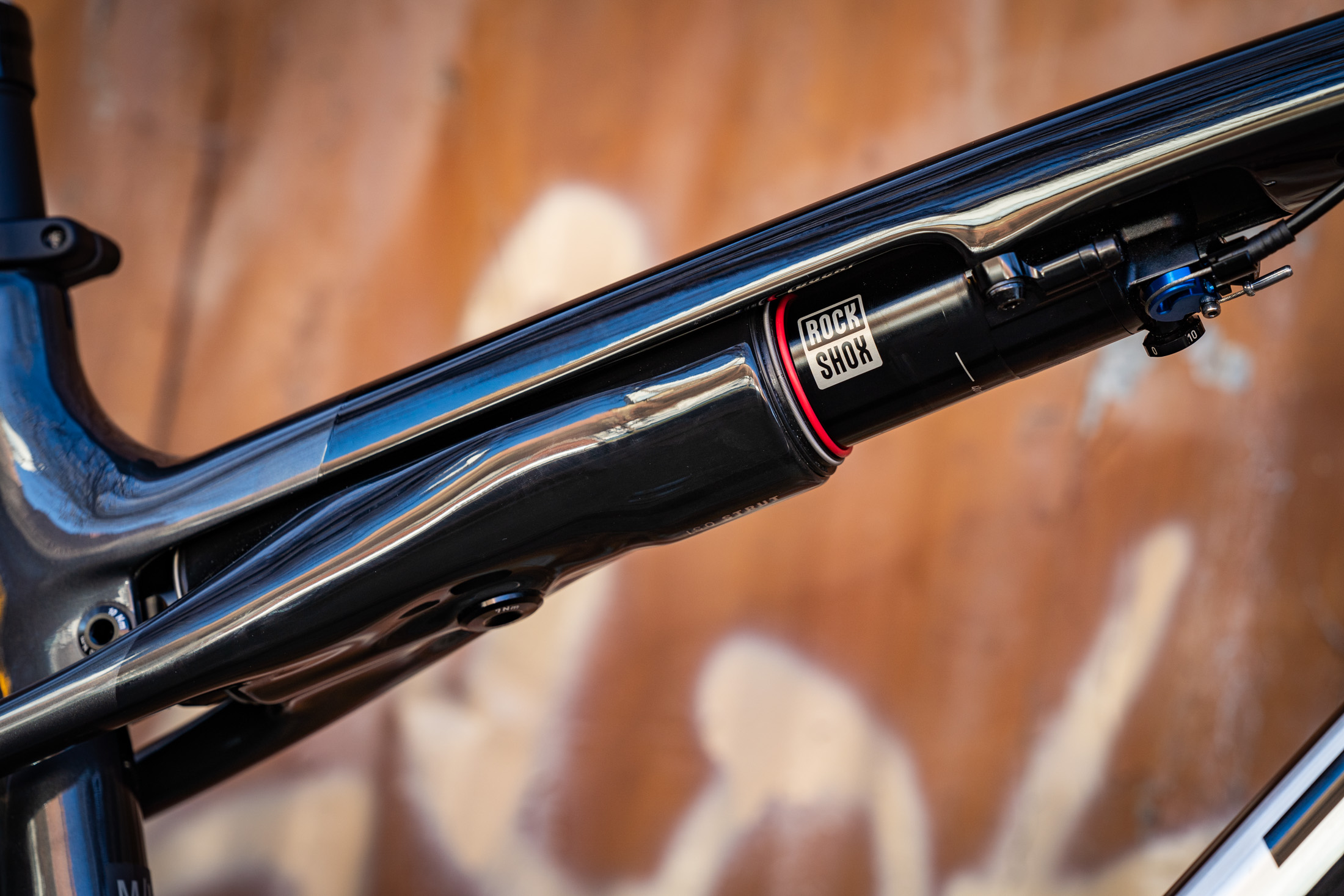
The IsoStrut stanchion has also grown in diameter to 38mm, which is said to improve rear wheel tracking and elevate the frame’s overall torsional stiffness. It now gets anodised sag gradients to make setup easier, and the head of the shock only needs a 4mm hex key to open it up for servicing, compared to the Race Face BB tool that was required for the old bike.
Even with the extra travel there’s still a keen focus on efficiency. Trek has moved the main pivot 10mm upwards to increase anti-squat and better resist suspension bob under pedalling inputs. It also means you can fit a larger chainring (up to a 38T) without sacrificing the Supercaliber’s snappy pedalling performance.

Trek Supercaliber frame weight
As mentioned earlier, the 2024 Trek Supercaliber frame is offered in both SL and SLR variants. The SLR frame is claimed to weigh 1,950g including the shock, while the SL frame comes in at 2,100g.
Now although Trek says the new SLR frame is lighter than its predecessor, that isn’t entirely true. It’s worth noting that when the Supercaliber first launched in 2019 it actually boasted a claimed frame weight of 1,933g. Curiously that figure has grown over the years and is now listed as 2,150g.
We asked Trek about this increase, and the response was that it was due to a rolling change in 2021 that saw a heavier swingarm developed for UDH compatibility. It’s unclear how a UDH dropout could result in a 217g weight increase, so perhaps there were other reasons behind the swingarm getting heavier.

Comparisons to the old bike aside, here’s how the new Supercaliber SLR frame compares to the claimed weights of some of its competitors;
- Specialized S-Works Epic EVO – 1,659g
- Specialized S-Works Epic World Cup – 1,712g
- Giant Anthem Advanced Pro – 1,735g
- Orbea Oiz OMX – 1,798g
- Scott Spark HMX SL – 1,870g
- Canyon Lux World Cup CFR – 1,894g
- Cannondale Scalpel Hi-Mod – 1,910g
- Santa Cruz Blur 4 – 1,933g
- Trek Supercaliber SLR – 1,950g
- Merida Ninety-Six RC – 2,064g
- Trek Supercaliber SL – 2,100g

Geometry updates
There have also been some noteworthy updates to the geometry on the 2024 Trek Supercaliber.
The 67.5° head angle is quite a bit slacker than the old bike, and the reach has grown by 10-15mm across the five frame sizes. Along with a 5mm increase in chainstay length, the overall wheelbase is considerably longer.
Trek has also steepened the seat angle by half a degree and lifted the BB height by 7mm. The aim was to improve the Supercaliber’s technical climbing performance, while also factoring in the change in dynamic ride height due to the increased suspension travel.
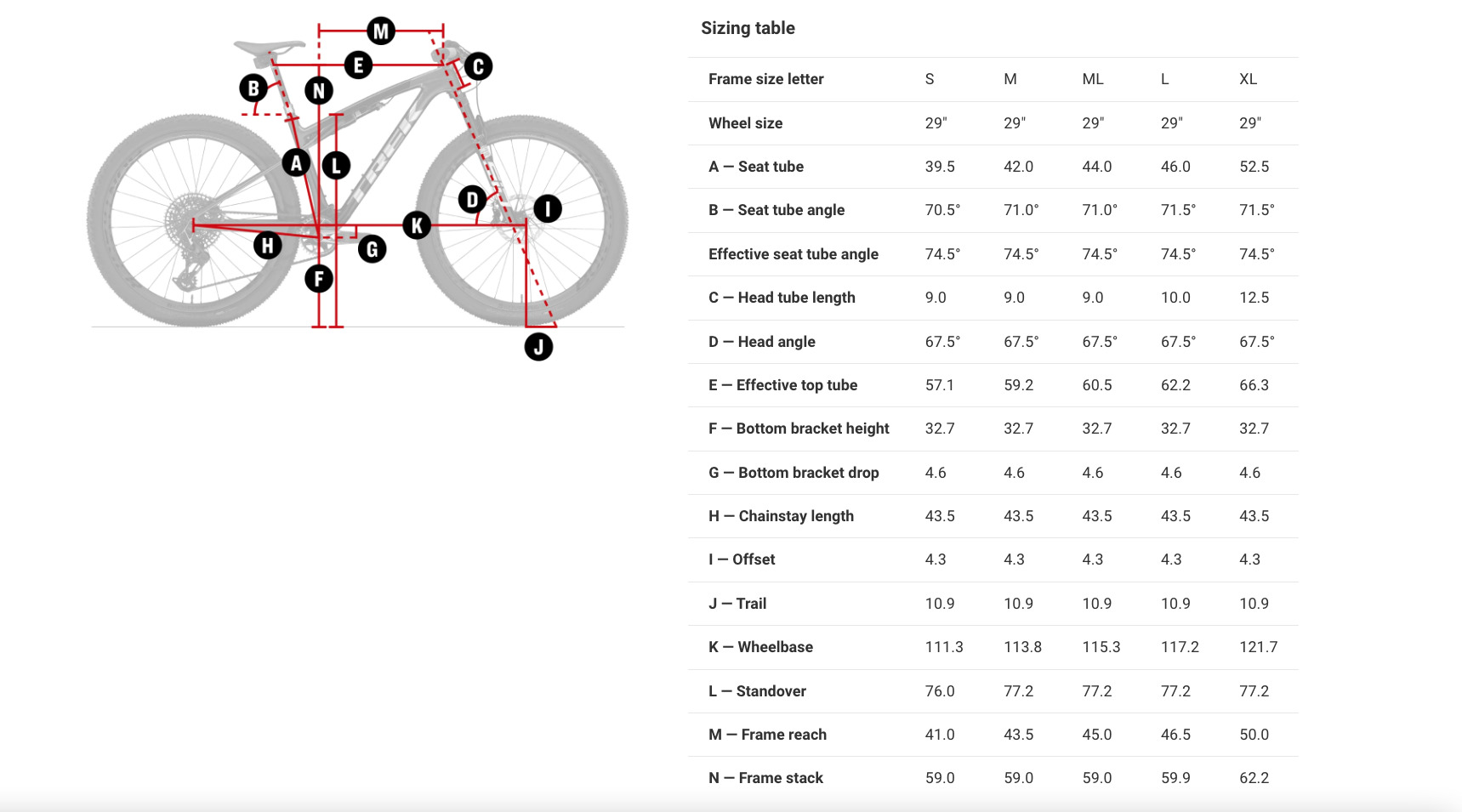
Trek Supercaliber price & specs
There will be six Trek Supercaliber models available in Australia, with prices starting from $8,999 AUD for the Supercaliber SL 9.7 AXS.
Most of the higher-end models will only be available through the Project One custom bike builder, which allows you to choose from a range of paint jobs and specification options. You can see the detailed specs and prices of the full range at the bottom of this review.
Our test bike sits in the middle of the lineup, and we expect it’ll be one of the most popular options; it’s the Trek Supercaliber SLR 9.8 GX AXS, and the current price on this is $11,999 AUD.

- Frame | SLR OCLV Mountain Carbon, IsoStrut Suspension Design, 80mm Travel
- Fork | RockShox SID, Rush RL Damper w/Lockout, 44mm Offset, 110mm Travel
- Shock | RockShox SIDLuxe IsoStrut w/Lockout, 240x40mm
- Wheels | Bontrager Kovee Elite, Carbon Rims, 29mm Inner Width
- Tyres | Bontrager Sainte-Anne RSL XR, 2.4in Front & Rear
- Drivetrain | SRAM GX Eagle AXS Transmission 1×12 w/34T Crankset & 10-52T Cassette
- Brakes | SRAM Level Bronze 4-Piston w/180mm Front & 160mm Rear Rotors
- Cockpit | Bontrager RSL Integrated Bar & Stem, OCLV Carbon, 750mm Width
- Seatpost | Bontrager Line Dropper, 31.6mm Diameter, Travel: 100mm (S), 125mm (M-ML), 150mm (L-XL)
- Saddle | Bonrager Verse Elite, Austentite Rails
- Confirmed Weight | 11.62kg
- RRP | $11,999 AUD

The increased travel and flatter leverage rate offers noticeably improved sensitivity over its predecessor, and indeed the back end is smoother than you’d expect for an XC bike with just 80mm of travel.

Trek Supercaliber sizing & fit
At 175cm tall I have the option of riding either the M or ML size in the Trek Supercaliber. The stack is identical between the two, with the key difference being the reach (435mm vs 450mm). Most of the XC bikes I’ve been testing lately have been in the 440-450mm zone, so I elected for the ML size.
The riding position is stretched-out, aggressive and racy. Your weight is pushed low and forward thanks to the short head tube and negative rise 70mm stem. You feel very much in-the-bike, with the Supercaliber hovering close to the ground.
While the fit is good, I can’t say I’m totally gelling with the cockpit ergonomics. There’s a limited range of adjustment for the lever reach on the SRAM Level Bronze brakes, and even with the dial wound all the way in they’re still not quite as close to the grips as I’d like.
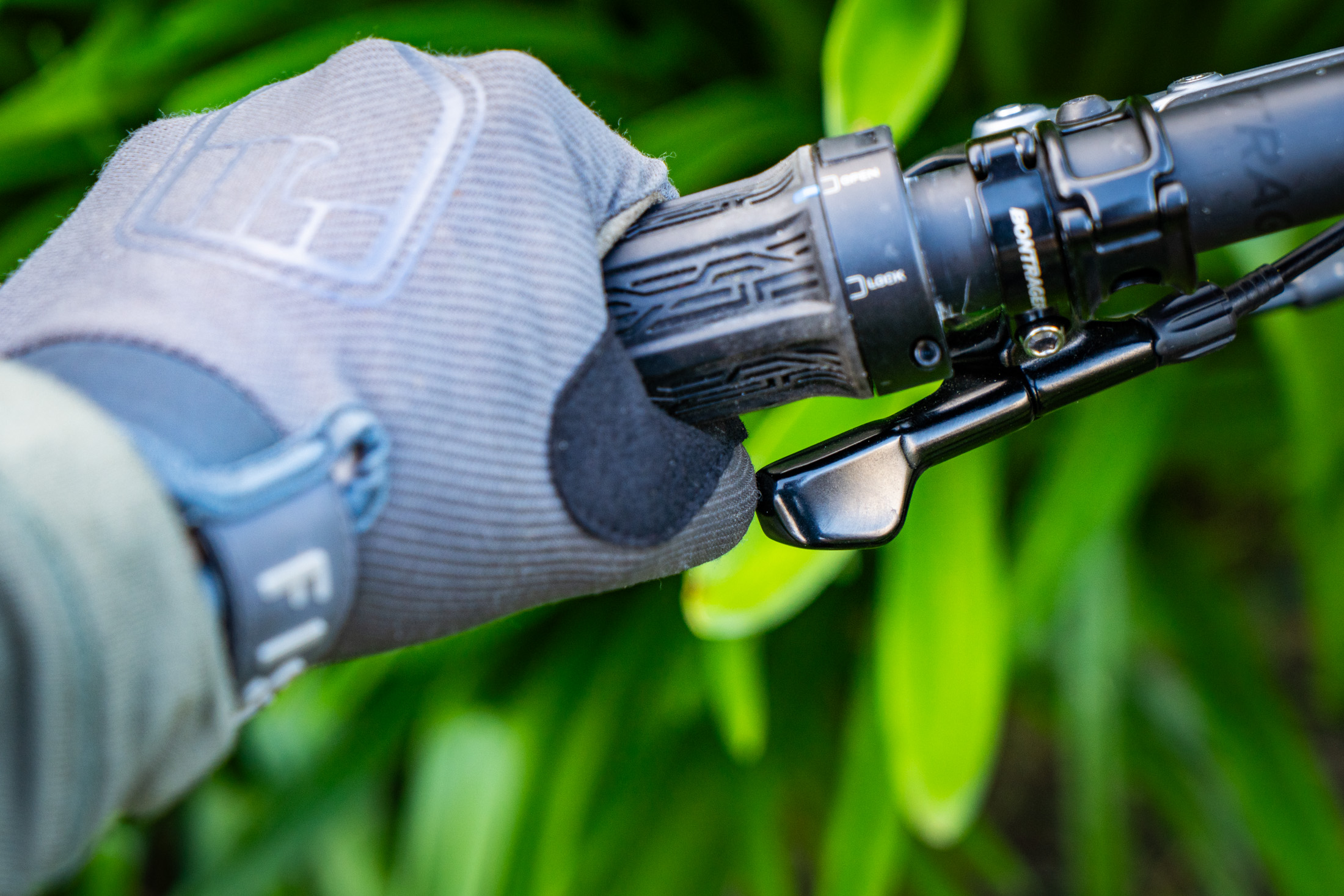
Our test bike comes standard with the cheap version of Bontrager’s dropper remote that features a standalone bar clamp. It really only fits in between the TwistLoc remote and the brake lever clamp, and that means the paddle sits quite far outboard. Not only does it push into the knuckle of my thumb, it also makes it difficult to grab a hold of the TwistLoc remote to actuate.
High-end Supercaliber models get a dropper remote that mounts directly to the brake lever, which would help to alleviate this clearance issue.
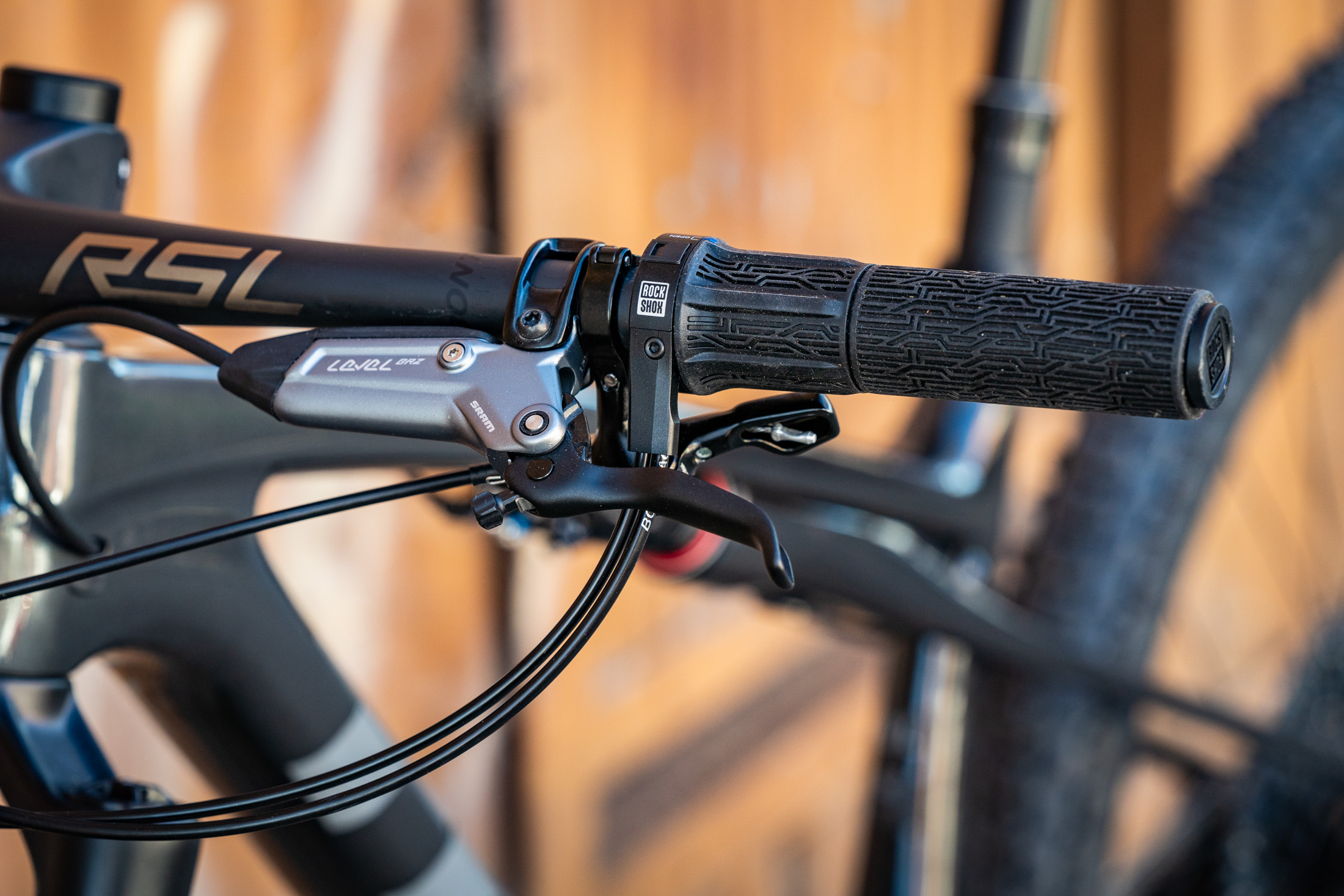
As we’ve experienced with the 2024 RockShox SID , the new TwistLoc Ultimate remote works well. However, for some reason our test bike came with the straight cable guide that spits the cables out perpendicular to the handlebar, which makes for an unsightly mess of cables. The angled cable guide would certainly make more sense here.
Suspension setup
Setting up the suspension on the new Trek Supercaliber has been made significantly easier thanks to the anodised sag gradients on the IsoStrut stanchion. Trek says you run the shock with 20-30% sag depending on the feel you’re after. I ended up at 25% sag, with 116psi to support my 67kg riding weight. I’ve set rebound damping on the quicker side at just three clicks off the fastest setting (7/10 clicks).

It’s also possible to tune the shock’s progression with volume spacers, and two are included in the box with the bike. It’s not a straightforward process however, as you’ll need to remove the IsoStrut assembly from the frame in order to open up the shock and access the air spring.
Up front is the new 2024 RockShox SID . It’s the base model with the Rush RL damper, though it features the same chassis and DebonAir+ spring as the top-end Ultimate model that I’ve been testing recently. As with the Ultimate model, I’ve found the suggested pressures via the RockShox Trailhead app to be too low. Instead of the recommended 69psi I’m running 82psi, and I have the rebound damping set nine clicks out from the slowest setting (9/22 clicks).
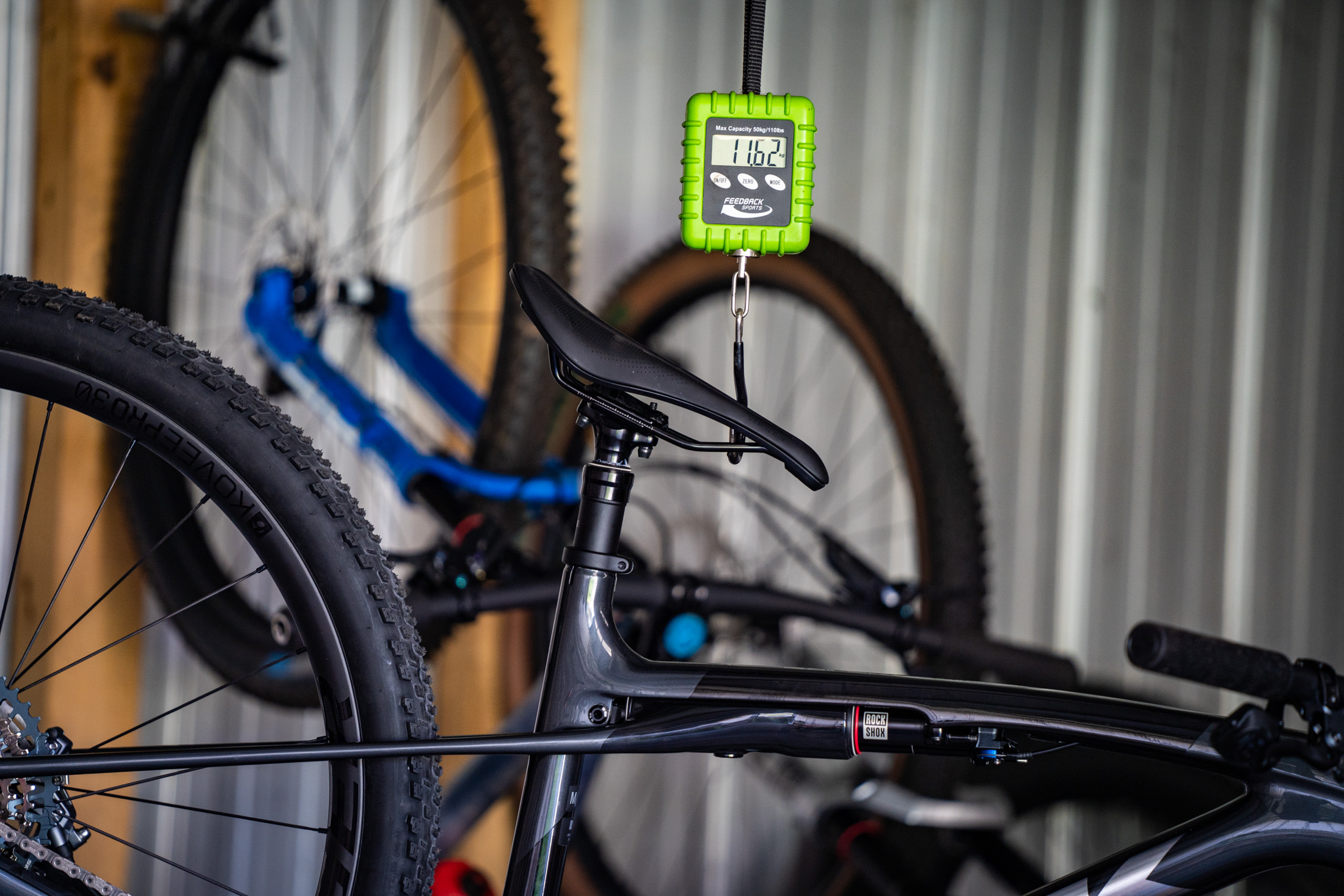
Trek Supercaliber weight
With the tyres set up tubeless our Trek Supercaliber SLR 9.8 GX AXS test bike came in at a confirmed weight of 11.62kg. That’s higher than the claimed weight of 11.28kg, and it’s also on the heavier side for a premium XC race bike with a $12K price tag.
As with all Supercaliber models, it does come fitted with a dropper post, which is fantastic to see. The Bontrager Line dropper is relatively heavy at 554g (confirmed), so you could drop 200g alone by upgrading to a Fox Transfer SL .
It’s worth noting that the Bontrager Kovee Pro wheelset is the older version with heavier rims and a deeper profile. These came in at a confirmed weight of 1,757g including the pre-fitted TLR rim strips and valves. That’s reasonable, though nowhere near the jaw-dropping 1,217g weight of the Kovee RSL wheelset we recently reviewed .
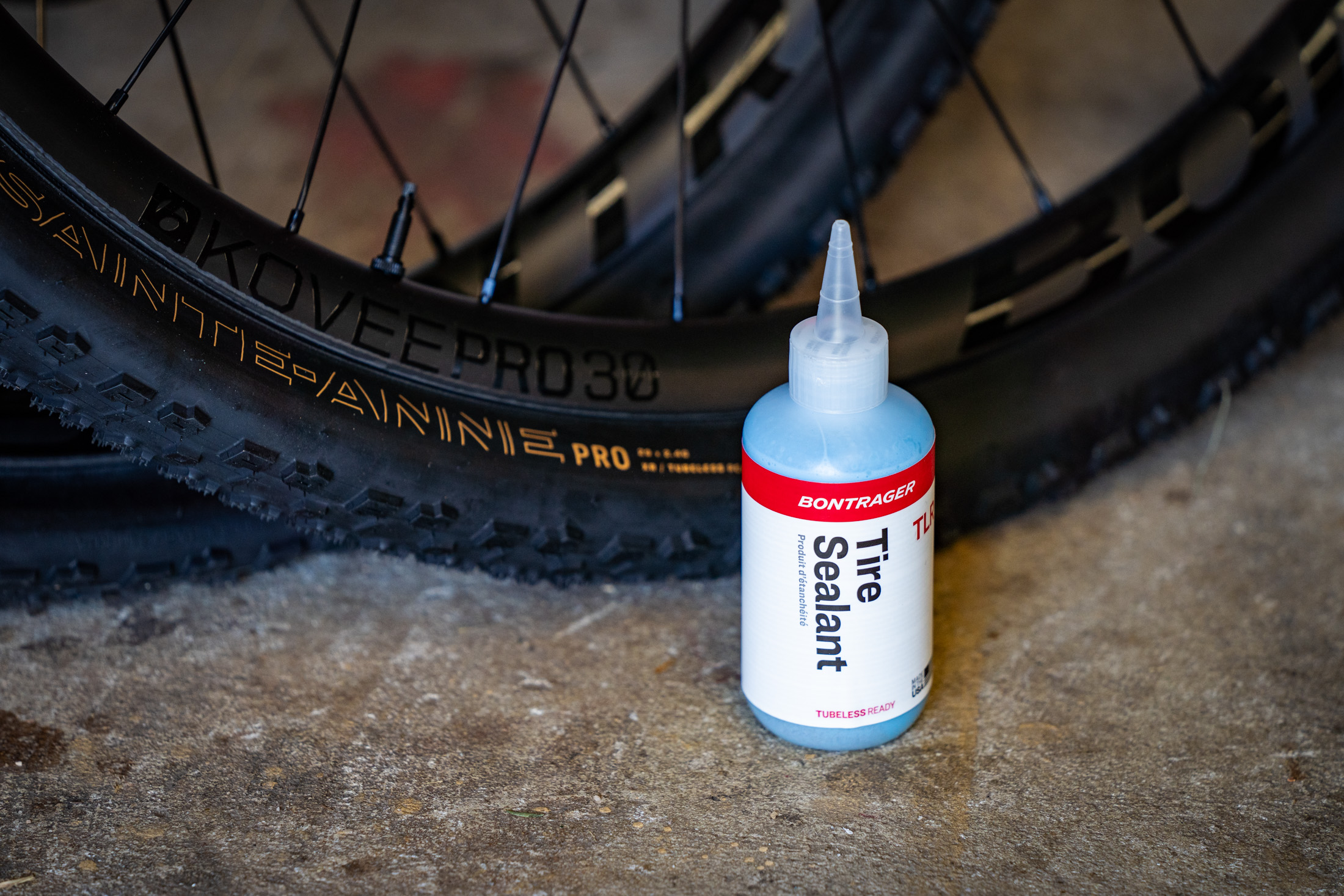
I suspect this obscenely tight fit is due to the combination the thick plastic TLR rim strips and the tyres themselves, but whatever the case, it’s not good.

Super-tight tyres
We’re glad to see Trek including a bottle of sealant with the bike, which makes it easy to set the tyres up tubeless.
Speaking of, these are the new Bontrager Sainte-Anne tyres that’ll be replacing the outgoing XR2. With a tread pattern that’s reminiscent of a Schwalbe Racing Ralph, they feature a finely-woven 220tpi casing, sidewall protection, dual compound rubber and a generous 2.4in width.
During the initial build I discovered that the tyres on our test bike appeared to be welded onto the rims, and found it impossible to physically pop the bead with my bare hands. With the help of a friend, a vice and some choice vocabulary, we eventually managed to peel the tyres off the rims. I suspect this obscenely tight fit is due to the combination the thick plastic TLR rim strips and the tyres themselves, but whatever the case, it’s not good.
Once I removed the tyres I was able to weigh them (798g confirmed) before fitting a tubeless insert into the rear wheel. I aired them up to 22psi up front and 24psi out back and rolled towards the trailhead, desperately praying I wouldn’t suffer any punctures.

Servicing the IsoStrut
Having spent a load of time on the previous generation Trek Supercaliber , I was very excited to see how the new bike would compare. However, I have to admit that I wasn’t totally loving it during the first few rides. The claims of improved sensitivity weren’t exactly playing out on the trail, with the back end feeling somewhat harsh.
This wasn’t a total surprise as the IsoStrut assembly does require some trail time to bed in, though out of curiosity I decided to pull it apart to get a closer look at the innards and see how different it was to the old bike.

Straight away the back end of the Supercaliber felt better, and it gradually became smoother and more sensitive over the course of the next few rides.

It’s worth noting here that the 38mm stanchion is essentially one half of a RockShox Zeb. In fact, the IsoStrut uses exactly the same bushings and wiper seals as the big-hitting single crown fork. That’s pretty cool, and it should make it easier to source replacements when needed.
For those wondering, the IsoStrut weighs in at 369g on the workshop scales, which is about 100g heavier than a conventional SIDLuxe shock. Bear in mind that it’s also a structural member of the frame, so it’s not exactly an apples-to-apples comparison.
With the IsoStrut cracked open I discovered that while it wasn’t totally bone-dry inside, there wasn’t a lot of lubrication fluid present. I gave it all a clean and pumped in 15cc of the requisite Maxima Plush suspension fluid and bolted everything back together.
Straight away the back end of the Supercaliber felt better, and it gradually became smoother and more sensitive over the course of the next few rides. Now with over 250km of testing logged, I’m confident to give a detailed appraisal of the bike.

What do we dig about the 2024 Trek Supercaliber?
With the IsoStrut dialled in, the Trek Supercaliber has been getting better the more I’ve ridden it.
The increased travel and flatter leverage rate offers noticeably improved sensitivity over its predecessor, and indeed the back end is smoother than you’d expect for an XC bike with just 80mm of travel. Seated comfort is excellent, and the rear suspension generates usable grip whether you’re in or out of the saddle.
Of course it’s not as plush as the longer travel Spark or Oiz . In direct comparison, the IsoStrut platform delivers a feel that’s closer to those two bikes when their suspension remotes are set to the middle setting (Traction Control or Medium).

However, for most XC racer types the Supercaliber will be sufficiently comfortable, and it’s obviously way more compliant than a hardtail. The high volume tyres also allow for lower pressures and more cushioning across sharp edges, and the 110mm travel SID keeps the front end tracking smoothly. The bigger chassis is a great match for the sturdy Supercaliber, offering a considerably more planted ride quality over the skinnier 32mm forks that came standard on the old bike.
Being able to drop the saddle down for the descents also makes a huge difference to descending confidence. Combined with the slacker head angle and longer wheelbase, the new Supercaliber is a far more stable bike at speed.

Stompable efficiency
Despite the improved suspension performance, it’s clear that the Supercaliber has lost none of its ruthless efficiency. Indeed the lockout is somewhat superfluous on this bike, which is good because I couldn’t really activate the TwistLoc remote anyway due to the poor placement of the dropper lever.
Really the only reason you’d reach for it in the first place would be to stabilise the fork during out-of-the-saddle sprinting. Otherwise you can comfortably leave the suspension open all the time with no concern for losing precious watts to pedal bob.

As for the source of the Supercaliber’s impressive efficiency, that comes down to a combination of the frame’s kinematics and the shock’s damper tune. We’re told that the compression damping in the Open setting is actually the same as the middle setting on a regular SIDLuxe 3-position shock, which makes sense as it’s very steady under pedalling inputs. Combined with the linear leverage rate and increased anti-squat, there’s zero hint of wallow through the rear end.
This makes the Supercaliber incredibly responsive under power, and it really encourages you to attack the trail at any opportunity. There’s minimal flex between the handlebar and the rear axle, which helps to translate explosive efforts when you’re yanking on the grips and stomping on the pedals. It lights up technical climbs, with the slightly taller BB height offering decent ground clearance over technical features.

Razor-sharp rigidity
Indeed it’s the overall chassis stiffness that represents one of the main drivers behind the IsoStrut platform. With the big 38mm stanchion braced by two widely-spaced bushings, Trek’s engineers have been able to minimise rear-end flex compared to a frame with a traditional swing link. This gives the Supercaliber a near-hardtail level of rigidity, with a sharp and agile feel when darting through the corners.
Trek has bolstered this with the stiff carbon wheels and RSL one-piece cockpit, so while the slacker head angle has calmed down the steering somewhat, the handling is still positively telepathic compared to most other XC bikes. Steering inputs are transmitted with minimal lag, and I found myself subconsciously taking the inside lines whenever possible.
There’s a real sense of what the terrain is doing beneath you thanks to the direct line of communication between your contact points and the tyre contact patches. This lack of vagueness is particularly beneficial across softer trail surfaces and through dusty berms, where you can modulate your weight distribution to maximise grip.

What has it struggled with?
While it is smoother and more stable than predecessor, the Trek Supercaliber doesn’t offer the same level of big-hit confidence on the descents as the Spark and Oiz. It’s surprisingly well controlled thanks to its sturdy chassis and nicely balanced geometry, but you can still run out of travel when pushing hard on rocky terrain.
There isn’t a tonne of support from the rear suspension, and that means it’s possible to bottom it out on bigger and harder landings. The sensation was initially quite harsh and metallic-y, though hitting full travel did become notably quieter and more damped after servicing the IsoStrut with fresh oil. It still makes a bit of noise when fully bottoming out, which seems to be amplified by the hollow stanchion.

With this in mind, I’d suggest heavier riders and anyone who’s wishing to run more than 25% sag will need to add a volume spacer to increase ramp-up. In my case, I found the stock setup worked fine as long as I exercised a little nuance and chose smoother lines as I would on a hardtail.
Even still, the Supercaliber exhibits noticeable feedback through the drivetrain across high-frequency chatter. This is the downside of the higher main pivot, which results in increased pedal kickback that is particularly noticeable on rocky tech climbs.
You could mellow out this sensation by fitting a larger chainring. This would reduce the amount of chain growth that occurs as the shock goes through its travel, potentially leading to a smoother ride quality.

Component highs & lows
It has to be said that for the $11,999 AUD asking price, our Trek Supercaliber SLR 9.8 GX AXS test bike doesn’t represent amazing value for money. It costs the same as the Cervelo ZFS-5 I’m currently testing, yet that bike comes with a SRAM X0 Transmission and a Reverb AXS dropper post. And the Orbea Oiz M10 I reviewed recently is $2,500 AUD cheaper despite having Factory Series Fox suspension and a nicer wheelset.
This would suggest that it’s the gorgeous SLR carbon frame and efficient IsoStrut suspension that you’re mostly paying for here. It’s also worth highlighting the trick Bontrager RSL one-piece cockpit, which sells for $640 AUD on its own and weighs just 239g.
While not overly blingy, the rest of the component package on our test bike has worked pretty well. The SRAM GX Transmission isn’t as light as its pricier X0 and XX siblings, but the gear range and shifting accuracy is superb. And although the Level brakes weren’t totally quiet, they otherwise offer excellent power and feel.

The Kovee Pro wheels have been solid, though as a lighter rider I didn’t find the stiff carbon rims to offer much compliance on rocky trails. I confirmed this by testing out the Supercaliber with the Kovee RSL wheelset , which made a noticeable difference to the overall ride quality. The stock wheels are very direct though, and the buzzy 108pt engagement offers rapid pickup at the pedals. The freehub is already starting to show some signs of contamination, so you’ll want to keep on top of maintenance to avoid premature bearing wear.
As for the overly tight-fitting tyres, I was mighty thankful not to have encountered any punctures throughout testing. If this were my bike, I’d be replacing the plastic TLR rim strips and fitting standard tubeless tape.

While not a big issue in terms of performance, the rear tyre has had a hefty wobble in the casing from new, which is a bit disappointing from a quality control perspective. I was otherwise happy to see the Sainte-Anne tyres measuring up exactly as claimed at 2.4in wide, and I found them to roll really well while offering predictable grip on dry and dusty hardpacked trails. The rubber compound lacks some grip on wet rocks and roots, which caused me a couple of pant-shitting moments when the wheels were spat out sideways.
Frame details
One positive I noticed during a particularly muddy test ride was the insane amount of clearance through the rear of the frame. Unlike most full suspension designs, the chainstay bridge on the Trek Supercaliber sits in front of the seat tube. This significantly reduces mud build-up, which is something you’ll be thankful for when the weather conditions turn south on race day.

As mentioned earlier, I’ve not been stoked on the cockpit ergonomics or cable management. Our test bike has exhibited some cable noise from inside the frame, and the bird’s nest in front of the handlebars spoils the otherwise clean lines of the IsoStrut platform.
It is nice to see the Supercaliber equipped with a conventional headset, though I do miss the Knock Block steering limiter. On our M/L size test bike, the dropper post lever and right-hand controller are able to contact the top tube when the bar spins around, which could cause some unfortunate damage in the event of a crash.

In terms of general maintenance, RockShox recommends servicing the IsoStrut air can every 100 hours of ride time, which is actually double the interval for a regular SIDLuxe shock. Given our experience however, I’d suggest checking the lubrication levels if you’re experiencing any harshness from new. Our test bike came out of Trek Australia’s production stock, so there’s a chance there could be consumer bikes out there in a similar condition.
Servicing is a relatively easy process to undertake, and I like how the IsoStrut combines existing components from the Zeb fork and SIDLuxe shock. I was also glad to see all of the bolts and mounting points lining up neatly, and there was no bending or preloading required to get the swingarm back into place. Of note is the new main pivot, which now uses a collet axle with a conical wedge to keep everything snug and secure.

Trek Supercaliber vs Specialized Epic World Cup
When it comes to comparisons to the Trek Supercaliber, none are more apt than the Specialized Epic World Cup .
Launched earlier this year, the Epic World Cup features a similar profile with its rear shock partially hidden within the frame’s top tube. Equipped with 75mm of rear travel, the Epic World Cup also utilises a custom shock that’s manufactured by RockShox. It’s called the SIDLuxe WCID and it uses a unique, tuneable air-spring to deliver an automated pedalling platform. Combined with the fork’s Brain damper, the Epic World Cup is defined by its lack of remote lockouts and excess cables. The result is a remarkably clean cockpit that is quite the juxtaposition to the Supercaliber.

As for pricing, the Specialized Epic World Cup Pro we tested sells for $13,900 AUD. It gets a considerably better spec with a RockShox SID SL Ultimate fork, a SRAM X0 Transmission, a powermeter, Level Silver brakes, and a Roval Control Carbon wheelset. Unfortunately it doesn’t come standard with a dropper post, but overall it feels like a more refined package out of the box.
It also comes in quite a bit lighter at 10.32kg. Even if you did add a Reverb AXS dropper, it’d still be close to a kilo lighter overall.
While we’re talking weight, the Epic World Cup’s FACT 12m carbon frame is claimed to be over 200g lighter than the Supercaliber SLR (1,712g vs 1,950g). There are some other differences, with the Epic World Cup featuring a threaded BB shell and internal routing through the headset.
Out on the trail, both bikes offer incredible pedalling performance. They share a similar ethos with no need to adjust levers or toggle remotes, encouraging you to hammer away on the pedals and focus on the trail ahead. It’s quite a different experience to the Scott Spark for example, which is very much reliant on its TwinLoc remote.
Thanks to the WCID shock and its tuneable negative air spring, there’s considerable scope for dialling in the rear suspension on the Epic World Cup. In the ‘Active’ setting the rear suspension isn’t as efficient but it is smoother than the Supercaliber. There’s greater support with a stronger ramp-up towards the end of the travel, while the lower anti-squat results in a more neutral feel through the pedals over chunky terrain.
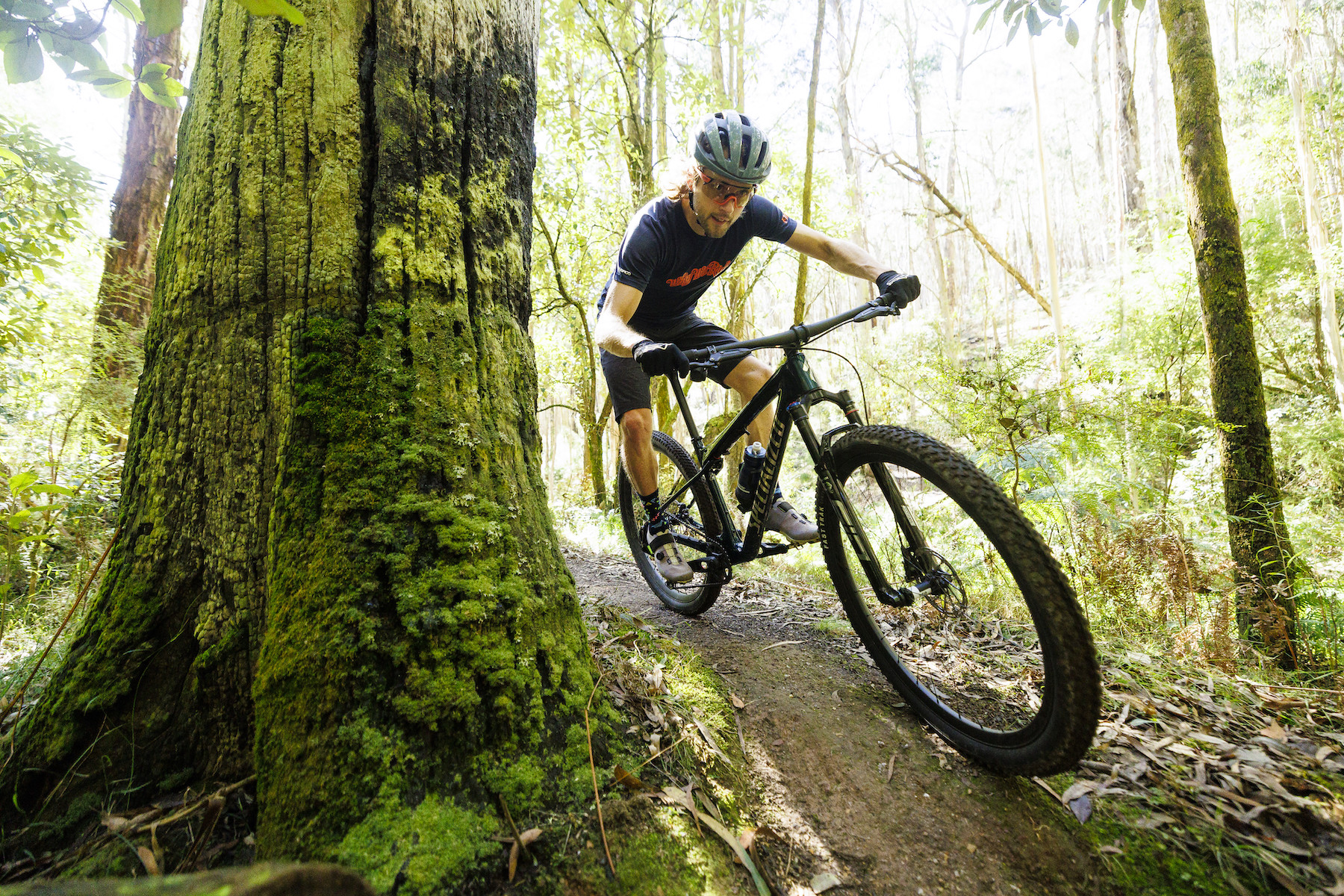
Furthermore, the Epic World Cup features a slacker head angle (66.5° vs 67.5°) and more BB drop (57mm vs 46mm), which results in improved stability and confidence on the descents. The Brain-equipped SID SL fork isn’t overly supple, and you need to be riding fast and assertively to get the most out of the inertia valve. The upside is that it doesn’t bob much at all when you’re sprinting, and it provides awesome stability on high-speed flow trails, staying high in its travel through berms and rollers.
For smoother race courses, setting up the WCID shock in the ‘Firm’ setting delivers an almost locked-out hardtail feel. In this setting the Epic World Cup is a touch more efficient than the Supercaliber, but it does lack some small-bump compliance.
Given the adjustability that’s on offer, the Epic World Cup requires a decent amount of trail time to experiment with the available settings in order to find your preferred setup. Of course there is no way to adjust the settings on-the-fly, and the lack of a remote lockout may be a turnoff for some racers. For others, the automated platform and clutter-free cockpit will be more than worth it.
In comparison, the Supercaliber is a simpler and more focused beast. Once you’ve dialled in your shock sag and rebound, there’s not much more to worry about. Pedalling performance is always ultra-snappy, and you’ve got access to a proper full lockout when needed. While the back end isn’t as supportive on bigger hits or as compliant on rockier terrain as the Epic World Cup, it does deliver excellent climbing grip and seated comfort. Along with the taut carbon frame, higher BB and steeper head angle, it’s more responsive through the turns and it’s arguably the better climber out of the two.

Flow’s Verdict
With its new frame, updated geometry and redesigned IsoStrut, the 2024 Trek Supercaliber is a welcome evolution of the original.
Some folks may be disappointed that it doesn’t look all that different, and for sure it isn’t a radical departure from its predecessor. It’s still sharp, efficient and highly responsive on tight singletrack, making it well suited to racing dirt crits and short track XC.
The suspension is notably improved however, offering better grip and small-bump sensitivity. Along with the bigger fork, dropper post and 2.4in tyres, the new Supercaliber exudes more confidence on the descents and greater stability at speed.
It isn’t exactly a flawless package though, and we’ve not been blown away by its weight or value for money. It’s also not as plush or as supportive as some of its longer travel contemporaries, and that makes it less versatile outside of the race tape, especially on rockier terrain.
If you’re serious about XC racing and you value efficiency above all else however, you’re unlikely to find a more focussed bike than the Supercaliber. It does a marvellous job of straddling the performance gap between a hardtail and a traditional full suspension bike, offering razor-sharp handling and crisp pedalling performance with just enough travel to get you out of trouble when needed.

2024 Trek Supercaliber SLR 9.9 XX AXS
- Fork | RockShox SID SL Ultimate, Charger Race Day Damper w/Lockout, 44mm Offset, 110mm Travel
- Wheels | Bontrager Kovee RSL, Carbon Rims, 29mm Inner Width
- Tyres | Bontrager Sainte-Anne RSL XR, 2.2in Front & Rear
- Drivetrain | SRAM XX SL Eagle AXS Transmission 1×12 w/34T Crankset & 10-52T Cassette
- Brakes | SRAM Level Ultimate 4-Piston w/160mm Rotors
- Seatpost | Fox Transfer SL, Factory Series, 31.6mm Diameter, 100mm Travel
- Saddle | Bontrager Aeolus RSL, Carbon Rails
- Claimed Weight | 9.45kg
- RRP | $18,999 AUD

2024 Trek Supercaliber SLR 9.9 XTR
- Fork | Fox 34 Step-Cast, Factory Series, FIT4 Damper w/Lockout, 44mm Offset, 110mm Travel
- Wheels | Bontrager Kovee Pro 30, Carbon Rims, 29mm Inner Width
- Drivetrain | Shimano XTR 1×12 w/34T e*13 TRS Race Carbon Crankset & 10-51T Cassette
- Brakes | Shimano XTR 2-Piston w/160mm Rotors
- Seatpost | Fox Transfer SL, Factory Series, 31.6mm Diameter, Travel: 100mm (S-M), 125mm (ML-L), 150mm (XL)
- Claimed Weight | 9.75kg
- RRP | $17,299 AUD
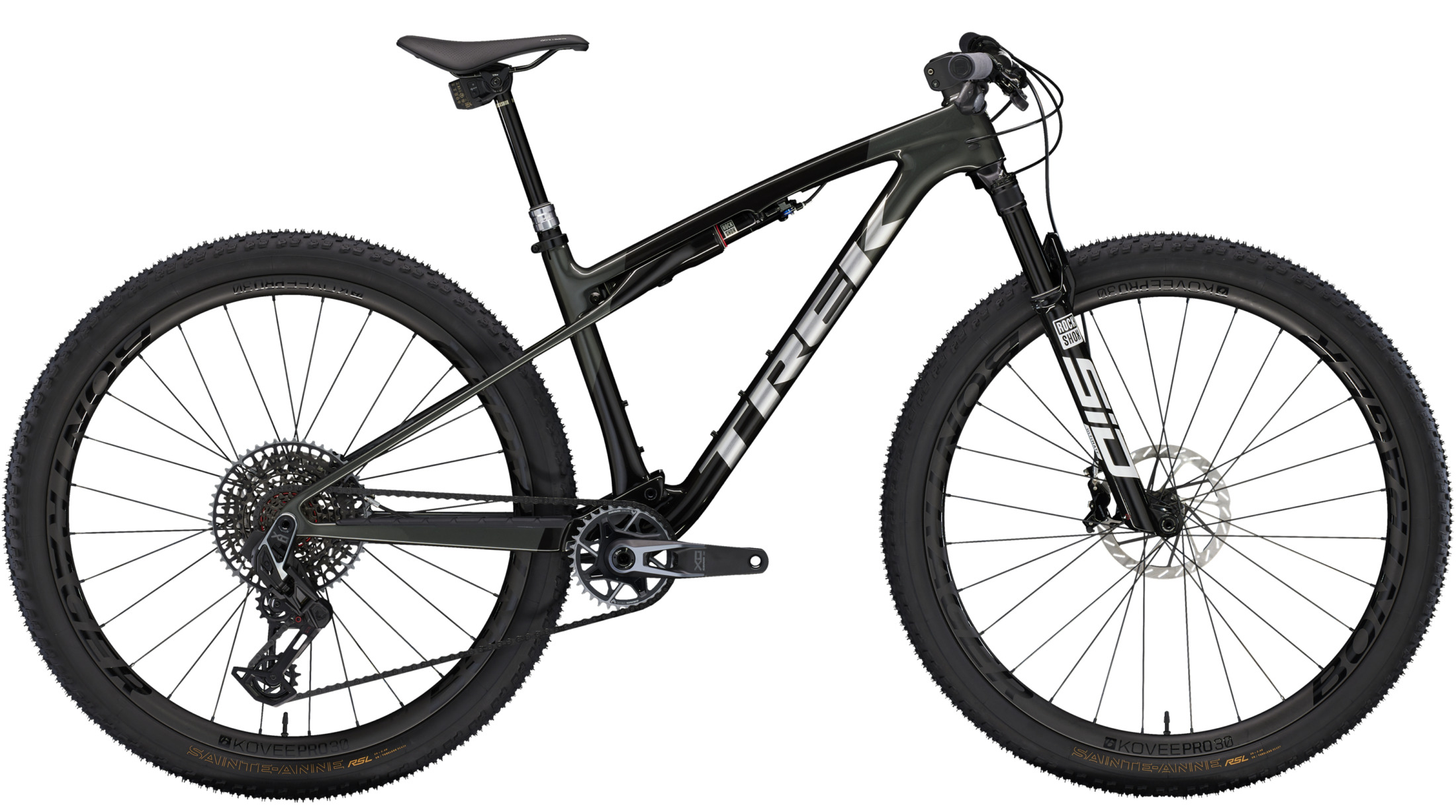
2024 Trek Supercaliber SLR 9.9 X0 AXS
- Fork | RockShox SID Ultimate, Charger Race Day Damper w/Lockout, 44mm Offset, 110mm Travel
- Wheels | Bontrager Kovee Pro, Carbon Rims, 29mm Inner Width
- Drivetrain | SRAM X0 Eagle AXS Transmission 1×12 w/34T Crankset & 10-52T Cassette
- Brakes | SRAM Level Silver 4-Piston w/180mm Front & 160mm Rear Rotors
- Seatpost | RockShox Reverb AXS, 31.6mm Diameter, Travel: 100mm (S), 150mm (M-XL)
- Saddle | Bonrager Aeolus Elite, Austentite Rails
- Claimed Weight | 11kg
- RRP | $16,499 AUD
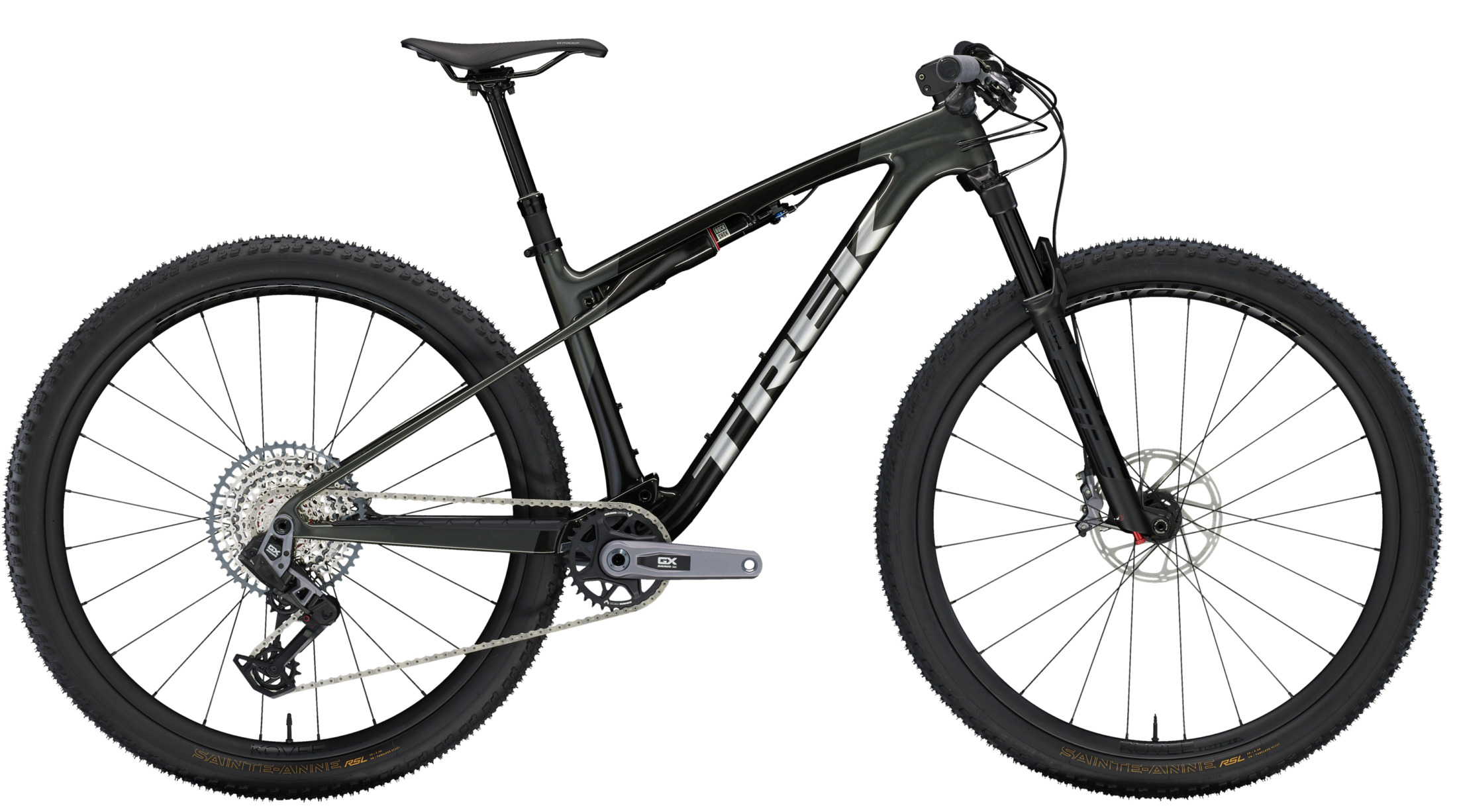
- Claimed Weight | 11.28kg
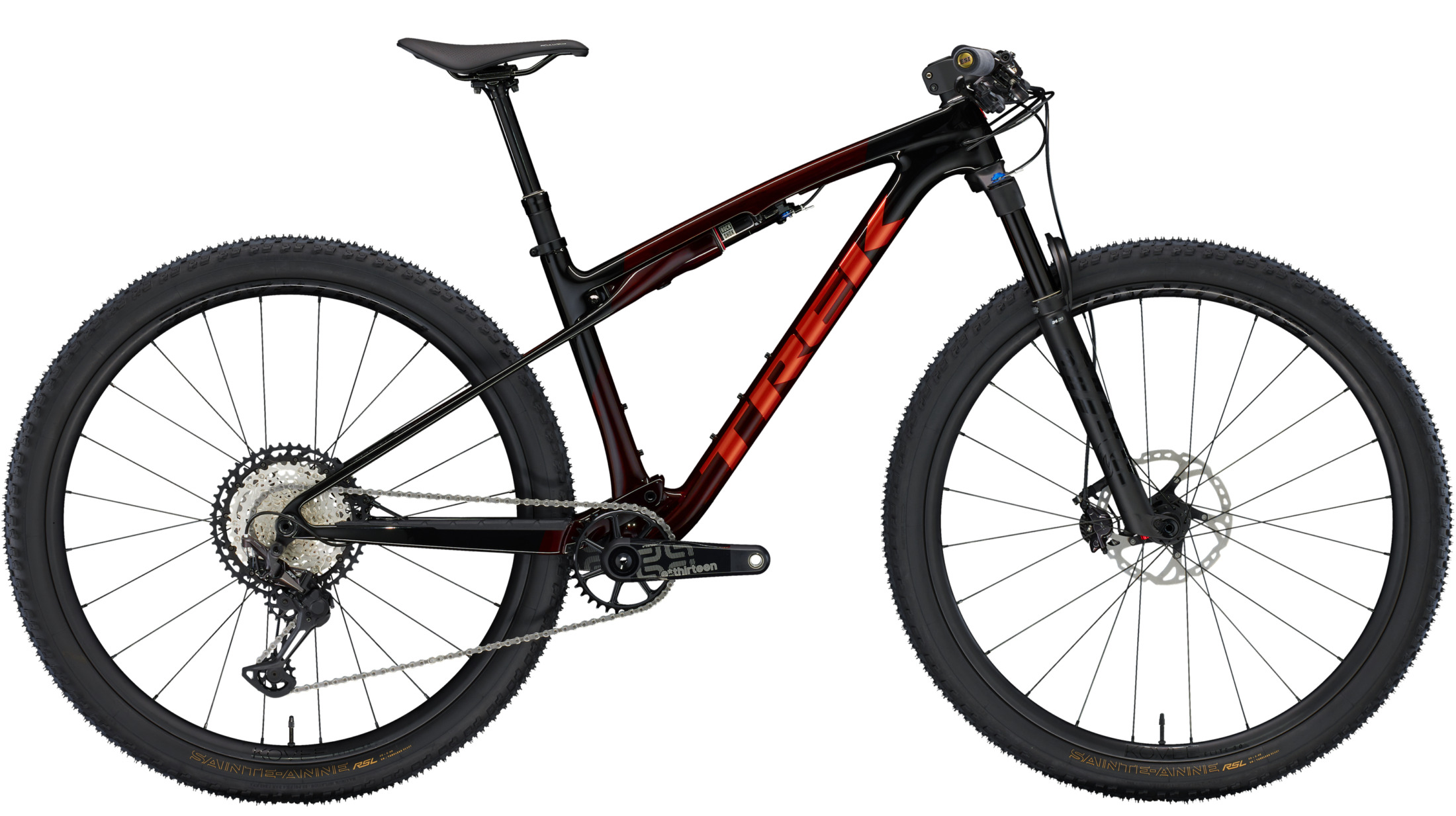
2024 Trek Supercaliber SLR 9.8 XT
- Fork | Fox 34 Step-Cast, Performance Series, GRIP Damper w/Lockout, 44mm Offset, 110mm Travel
- Wheels | Bontrager Kovee Elite 30, Carbon Rims, 29mm Inner Width
- Drivetrain | Shimano XT 1×12 w/34T e*13 TRS Race Carbon Crankset & 10-51T Cassette
- Brakes | Shimano XT 2-Piston w/180mm Front & 160mm Rear Rotors
- Claimed Weight | 10.95kg
- RRP | $11,599 AUD
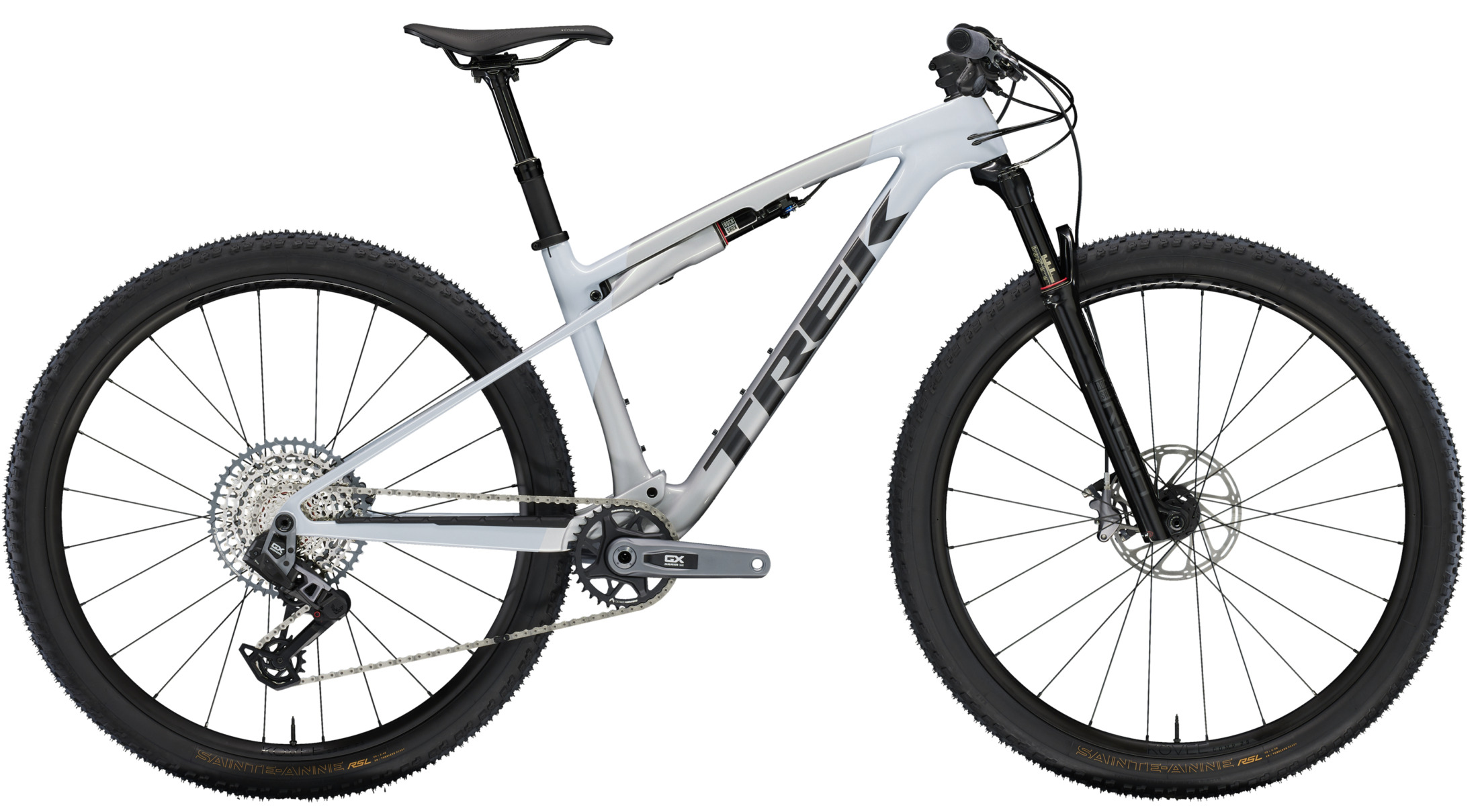
2024 Trek Supercaliber SL 9.7 AXS
- Frame | SL OCLV Mountain Carbon, IsoStrut Suspension Design, 80mm Travel
- Fork | RockShox Reba RL, Motion Control Damper w/Lockout, 42mm Offset, 110mm Travel
- Wheels | Bontrager Kovee Comp 25, Alloy Rims, 25mm Inner Width
- Handlebar | Bontrager Line Pro, OCLV Carbon, 750mm Width
- Stem | Bontrager Elite, 35mm Diameter Clamp
- Saddle | Bontrager Verse Elite, Austentite Rails
- Claimed Weight | 11.8kg
- RRP | $8,999 AUD
- Submit for Review
- Terms & Conditions
Enjoy reading this?
Get similar articles delivered directly to your inbox

- Mountain Bikes
- Gravel Bikes
- Hybrid Bikes
- Electric Bikes
- Commuter Bikes
- Exercise Bikes
- Women’s Bikes
- Kids’ Bikes
- All Best Bike Brands
- Mountain Bike Brands
- Electric Bike Brands
- Bike Rack Brands
- Brand Review: Rad Power Bikes
- Brand Review: Ride1UP Bikes
Disclaimer: Bikexchange is reader-supported . We may earn an affiliate commission when you buy through the links on our site.
Trek Supercaliber Review — Podium-Winning XC Race Bike
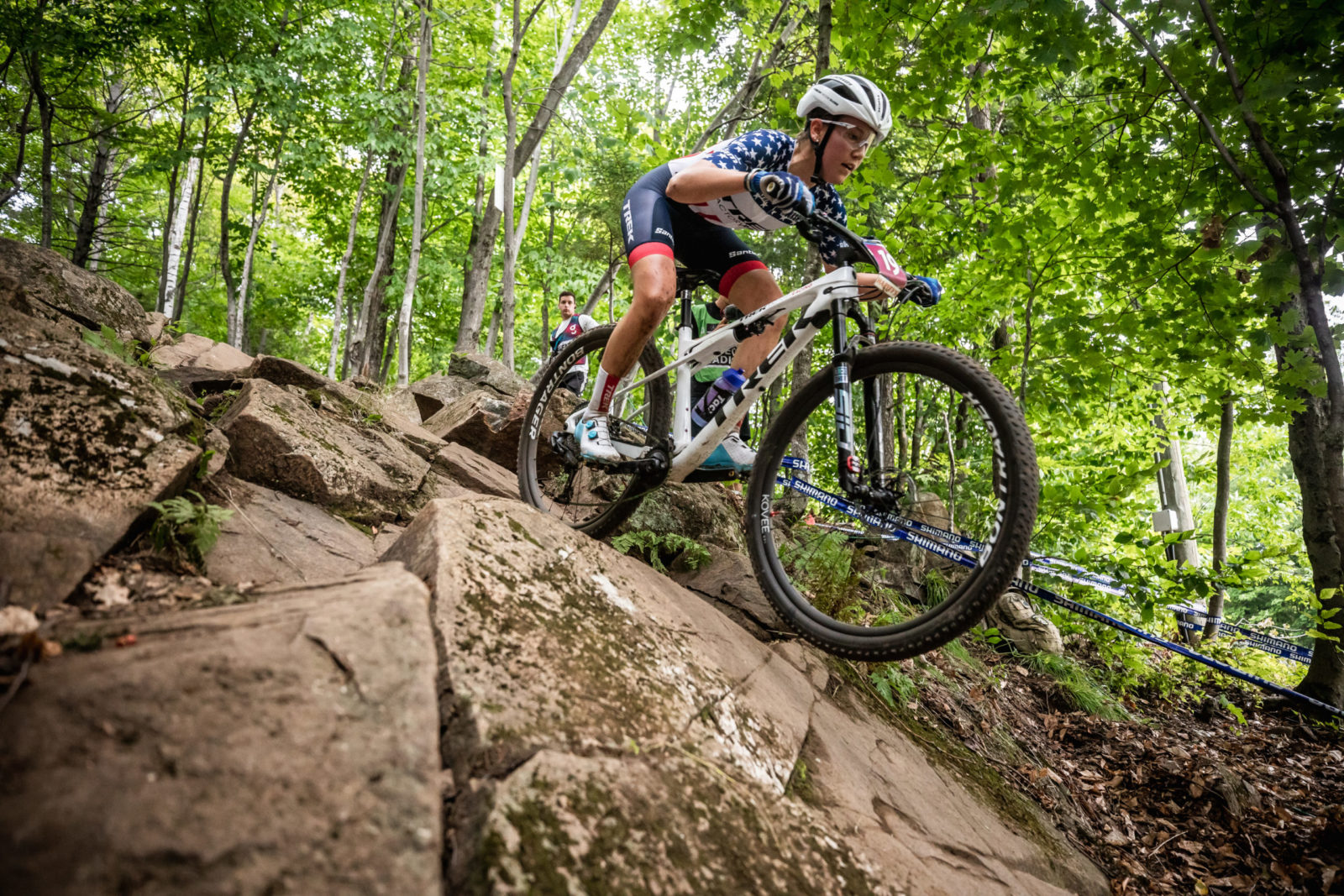
Maddie Munro showing off her skills on a Trek Supercaliber.
The Trek Supercaliber is an XC race bike designed to bridge the gap between hardtails and full-suspension MTBs.
The Supercaliber utilizes innovative Trek Bikes’ IsoStrut suspension technology and industry-leading components to maximize performance and gain an advantage over the competition.
Snappy XC geometry, fast-rolling tires, premium carbon fiber, and low-travel suspension make this bike lightning fast and efficient.
With seven builds in the series, XC riders with big ambitions can choose the Supercaliber that fits their needs and budget.
This Trek Supercaliber review will outline the series’ standout characteristics, discuss each model in detail, and finish with our verdict on who should choose this bike.
A race-ready cross-country mountain bike designed for speed and efficiency.
- Exceptionally efficient
- Agile and snappy handling
- Ultra-lightweight for a full-suspension bike
- Plenty of small bump sensitivity
- No dropper post
- Narrow handlebars
Main Trek Supercaliber Specs
- Frame: Carbon OCLV
- Wheel size: 29″
- Tires: 2.2″
- Front travel: 100mm (120mm compatibility)
- Rear travel: 60mm
- Drivetrain: 12-speed
- Brake rotors: 180mm (f), 160mm (r)
- Weight: 21.6 – 27lbs
Trek Supercaliber Overview
The Trek Supercaliber is a specialist cross-country bike for riders who want to maximize speed and climbing efficiency. This bike will help you break all your personal bests on your local XC trail but won’t provide much comfort on rough terrain with its narrow tires, rigid seatpost, and 60mm of rear suspension.
Carbon OCLV Frame
Trek’s frames are renowned for their innovative design features and world-class ride characteristics fit for champions. Each Supercaliber uses the same patented OCLV Mountain carbon frame.
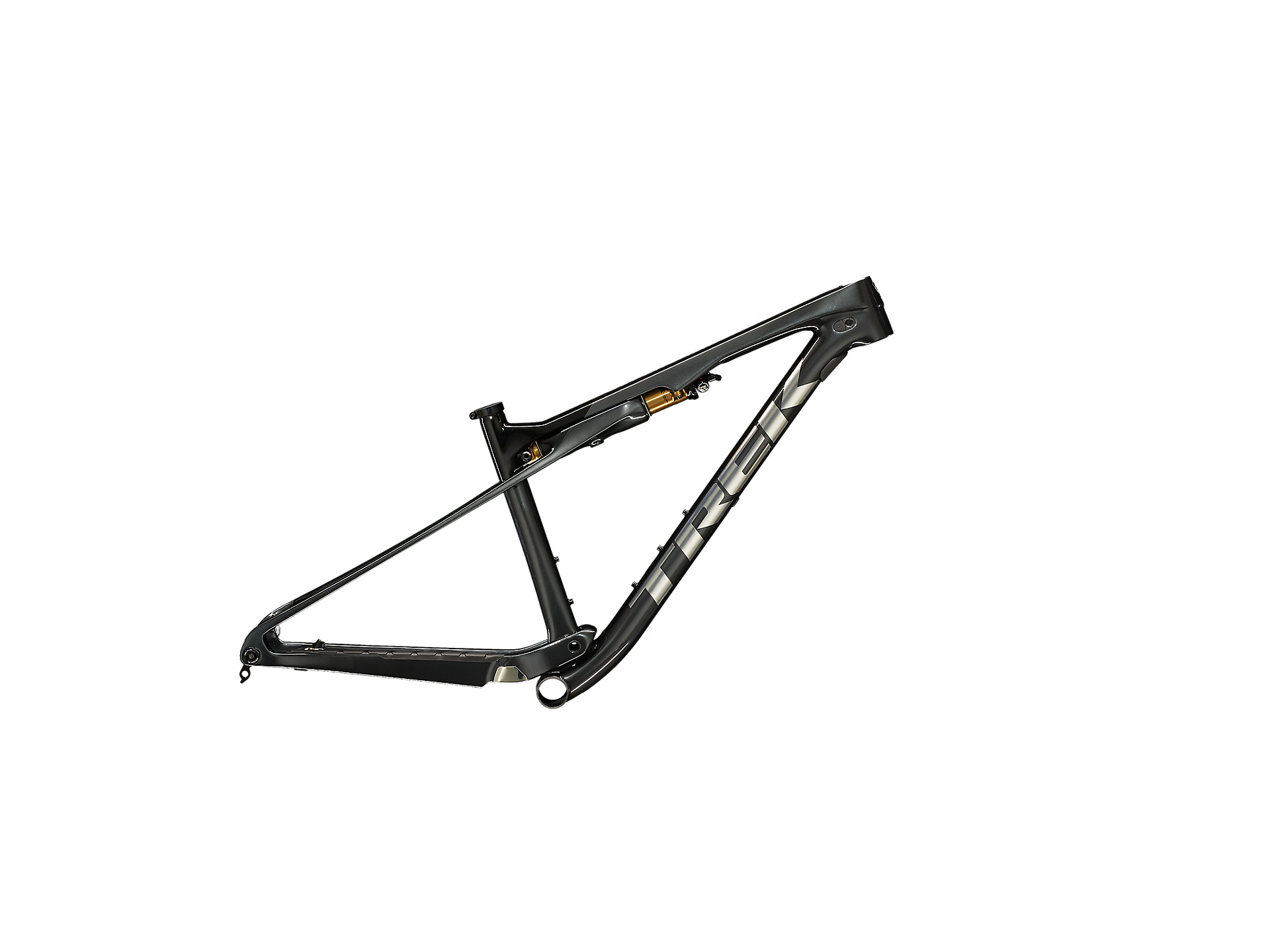
Trek utilizes techniques borrowed from the aerospace industry to deliver one of the world’s strongest and most durable carbon bike frames , even after impact.
The Supercaliber has a Straight Shot down tube to enhance the responsiveness of the frame and reduce weight. Another unique feature is the Knock Block headset design that prevents the fork crown and handlebars from spinning too far in a fall, which often damages the frame.
Trek also designed the Supercaliber frame with enough space to carry two water bottles, a non-negotiable for demanding XC racing. Finally, Trek backs each frame with a limited lifetime warranty.
XC Geometry
The Trek Supercaliber geometry plays a big role in its ride characteristics. Its straightforward, compact design delivers a sharp and efficient ride quality .
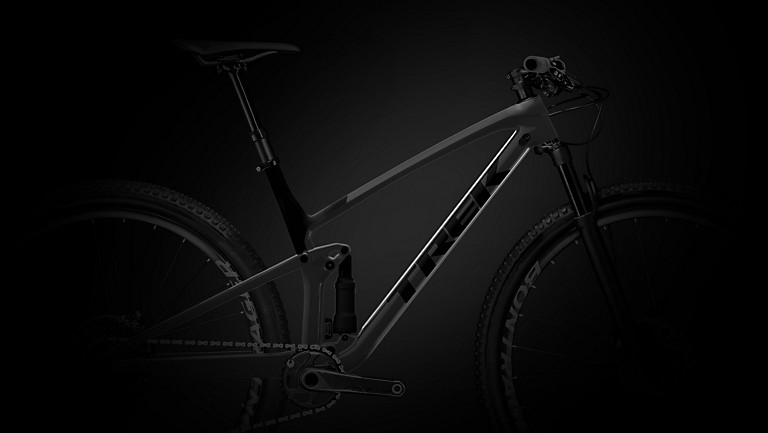
Trek Supercaliber has a straightforward, modern and compact geometry with a Straight Shot downtube that reduces weight and improves handling.
It has a steep 69-degree head angle and a relatively slack seat angle of 74 degrees. A short stem (70mm), a tight rear center of 430mm, and a compact wheelbase of 1079 to 1172mm keep the Supercaliber as agile as possible.
This geometry means the Supercaliber can change direction quickly and with minimal effort, allowing easy navigation of tight switchbacks and picking the fastest line. The low bottom bracket drop of 53mm also helps balance the sharp steering with extra stability.
Trek IsoStrut Suspension
Trek’s IsoStrut frame-integrated rear suspension is a bespoke system designed in partnership with Fox. The Supercaliber comes with a Float Factory or Float Performance shock integrated into the IsoStrut, depending on the build.
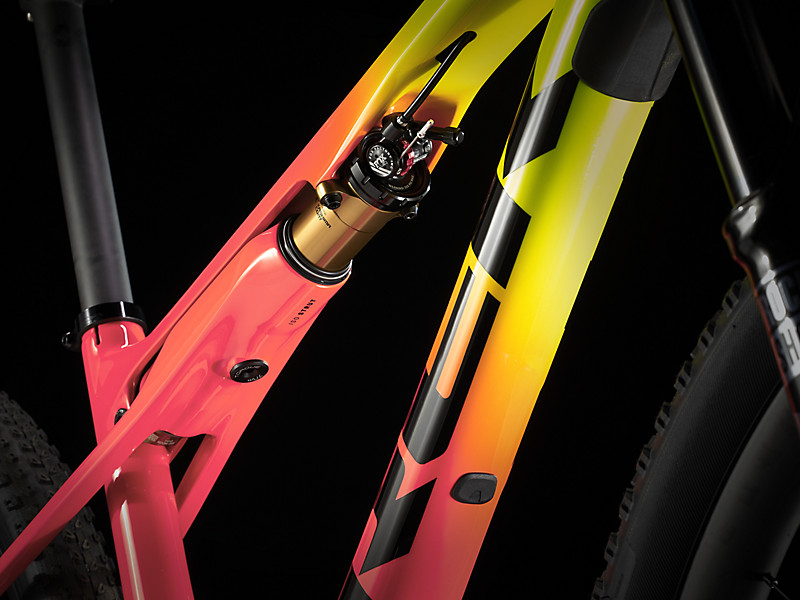
Trek’s IsoStrut technology provides the Supercaliber with firm and precise suspension that help the bike thrive on XC race tracks.
Each Supercaliber has just 60mm of rear travel, which aligns with Trek’s minimalist thinking. The IsoStrut is a structural element of the bike , eliminating the need for extra parts and unnecessary weight. The shock is enclosed in a stanchion that protects it from damage and reduces lateral frame flex.
The IsoStrut contributes to a more efficient, durable, and sleek bike. In addition, by utilizing the remote lockout, you essentially turn the Supercaliber into a hardtail.
You can tune the spring rate and adjust the rebound as you would on a standard shock. The only downside is that it requires more effort to maintain as you must disassemble the bike to service it.
Trek Supercaliber Builds
There are four models available in 2023. The new 9.6 and 9.7 Trek Supercaliber 2023 builds and the 2023 versions of the 9.9 and 9.8.
All four models have a carbon fiber frame and components from leading manufacturers like Shimano, SRAM, Maxxis, Fox, RockShox, and Trek’s Bontrager. The Trek Supercaliber price varies from mid-range to elite-level.
Trek Supercaliber 9.6 2023
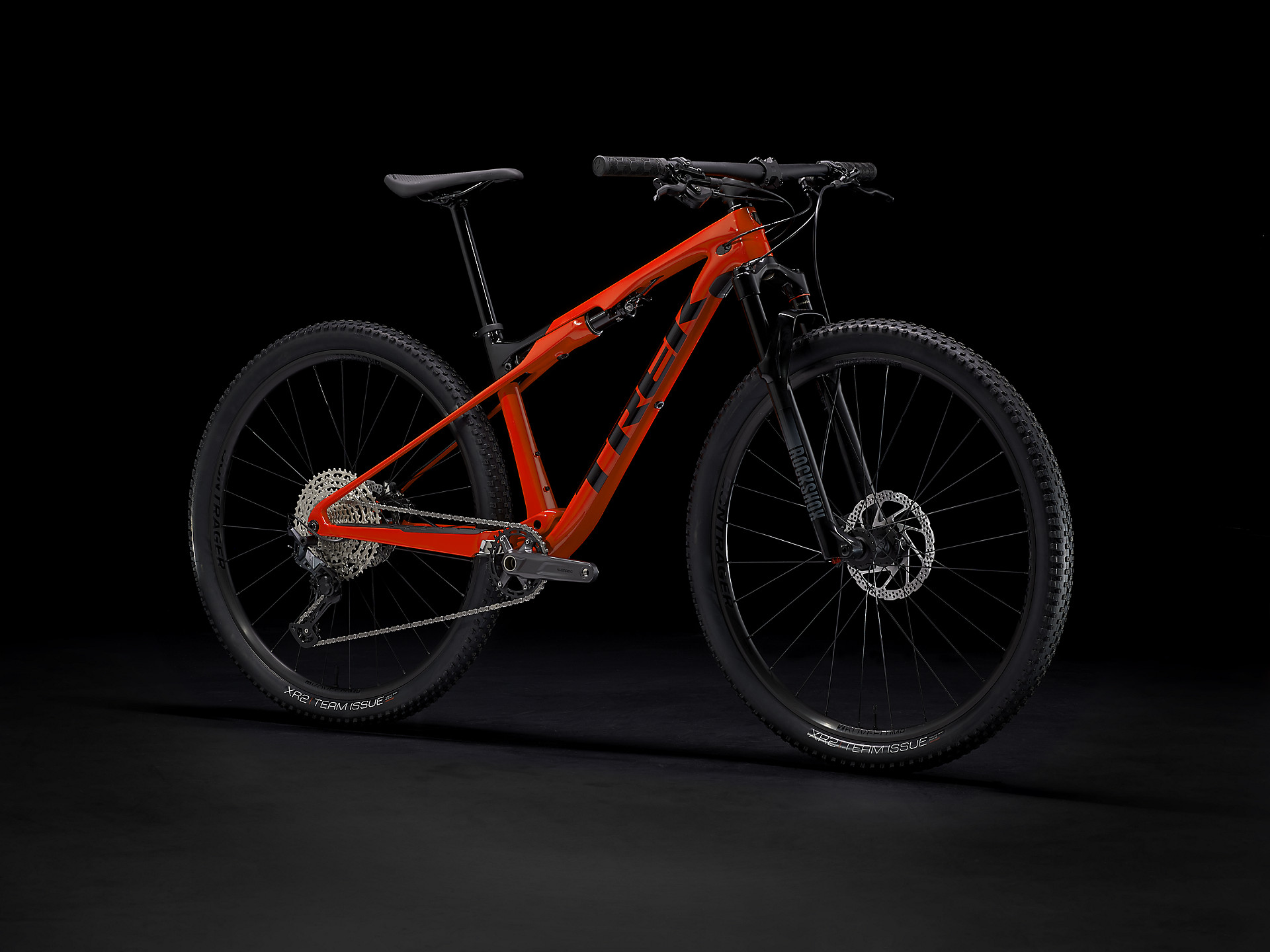
MRSP: $4,300
The Trek Supercaliber 2023 9.6 is the most affordable model. Of course, this version isn’t cheap but gives ambitious cross-country racers a more achievable price.
The 9.6 comes with the same premium OCLV Carbon frame and IsoStrut suspension as the top models. However, it has a Fox Float Performance DPS shock paired with a RockShox Recon Gold RL fork.
This version is the only one with alloy wheels; Bontrager’s Comp 23s. These come wrapped in XR2 Team Issue tires. The rest of the build kit on the Supercaliber 9.6 is aluminum alloy, excluding the steel-rail Bontrager Arvada saddle.
Finally, this build has a Shimano Deore/SLX groupset with a 10-51t cassette and MT4100 brakes.
Trek Supercaliber 9.7 2023
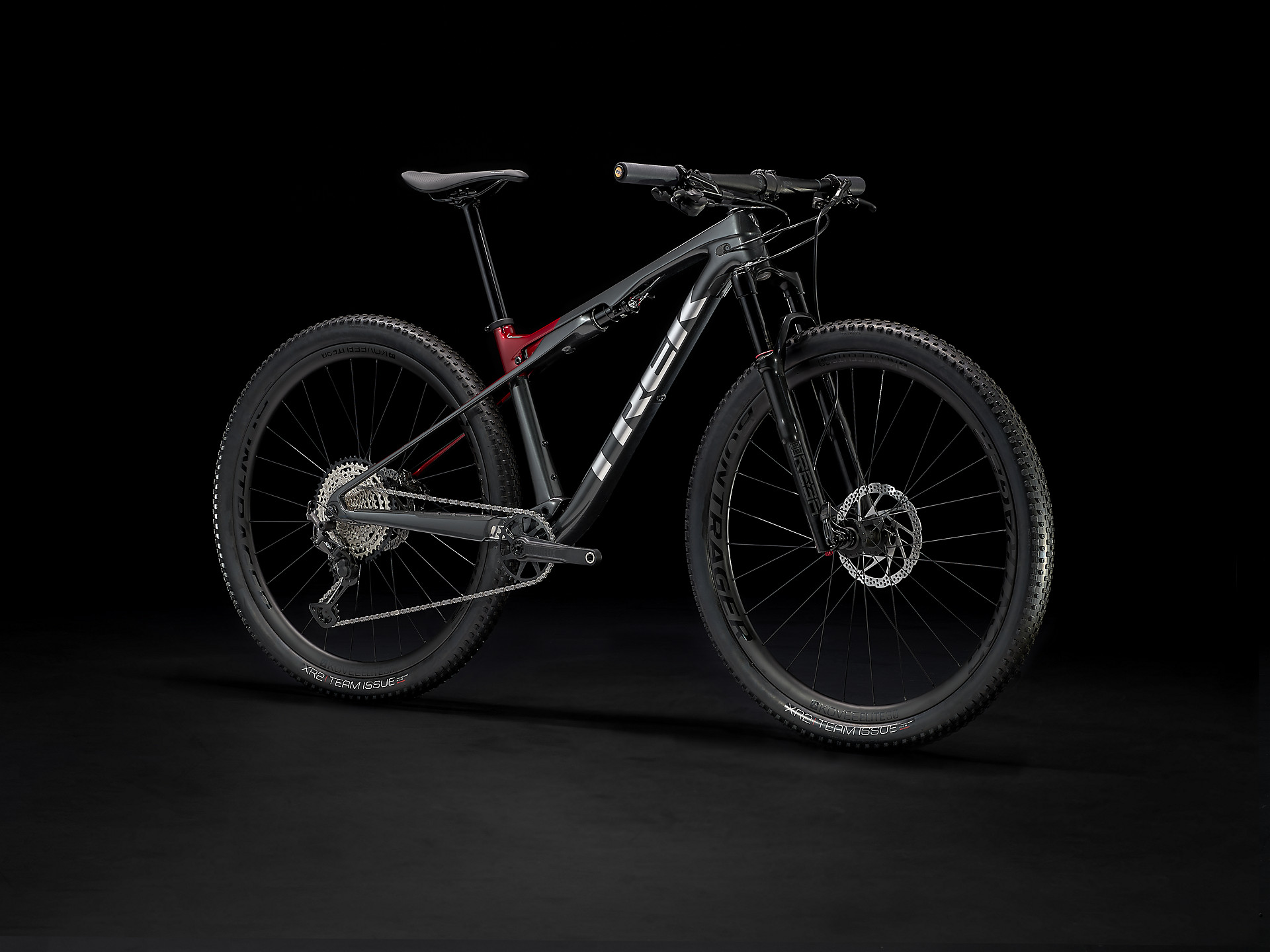
MRSP: $5,100
The Trek Supercaliber 9.7 is another 2023 edition of the bike. It’s built with mid-range components for more accessibility to the general market but gets a few notable upgrades from the entry-level 9.6.
The most significant improvement is the step up to SLX/XT drivetrain components with MT501 brakes. Additionally, the 9.7 gets Bontrager Kovee Elite 30 carbon fiber wheels.
Other notable changes include an E*thirteen alloy crankset, a Bontrager P3 Verse Elite stainless steel saddle, and vibration-absorbing ESI chunky grips. All of these changes reduce weight by 1.6lbs to 25.41lbs.
Trek Supercaliber 9.8
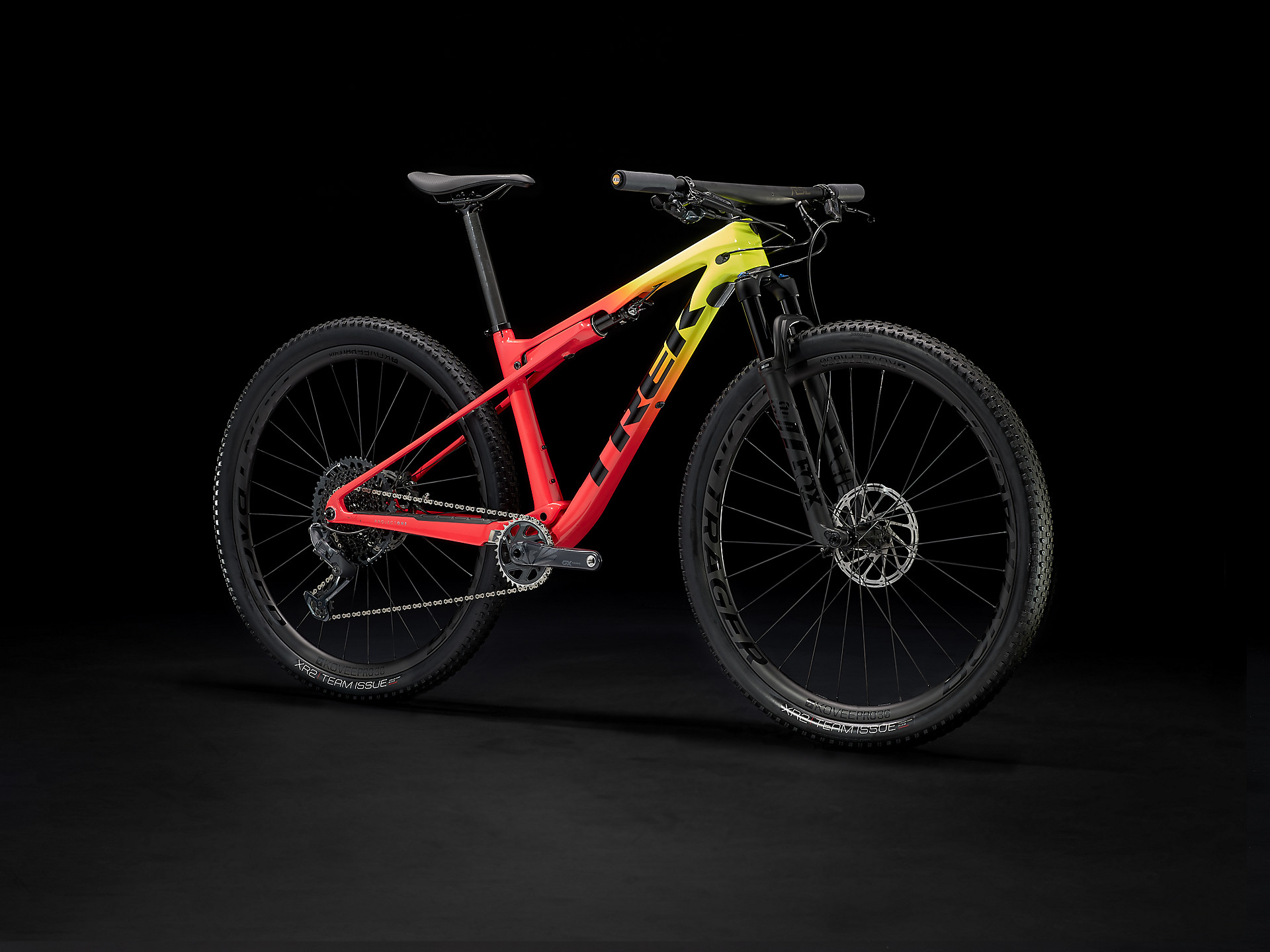
MRSP: from $6.550
The Trek Supercaliber 9.8 is the more affordable of the two pro-level models. The 9.8 is available in three builds , SRAM GX, GX AXS, and Shimano XT, with $1,000 separating them.
The 9.8 gets several upgrades on the 9.7, including Kovee Pro 30 wheels and a carbon seatpost, stem, and handlebars. Additionally, the fork steps up to a Fox Performance 32 Step-Cast or a RockShox SID SL on the electronic SRAM build.
The other major change is the improved groupset. Each 9.8 has a carbon crankset, and the SRAM models come with 10-52t cassettes. The 9.8 models are roughly 2.5lbs lighter than the 9.7.
Trek Supercaliber 9.9
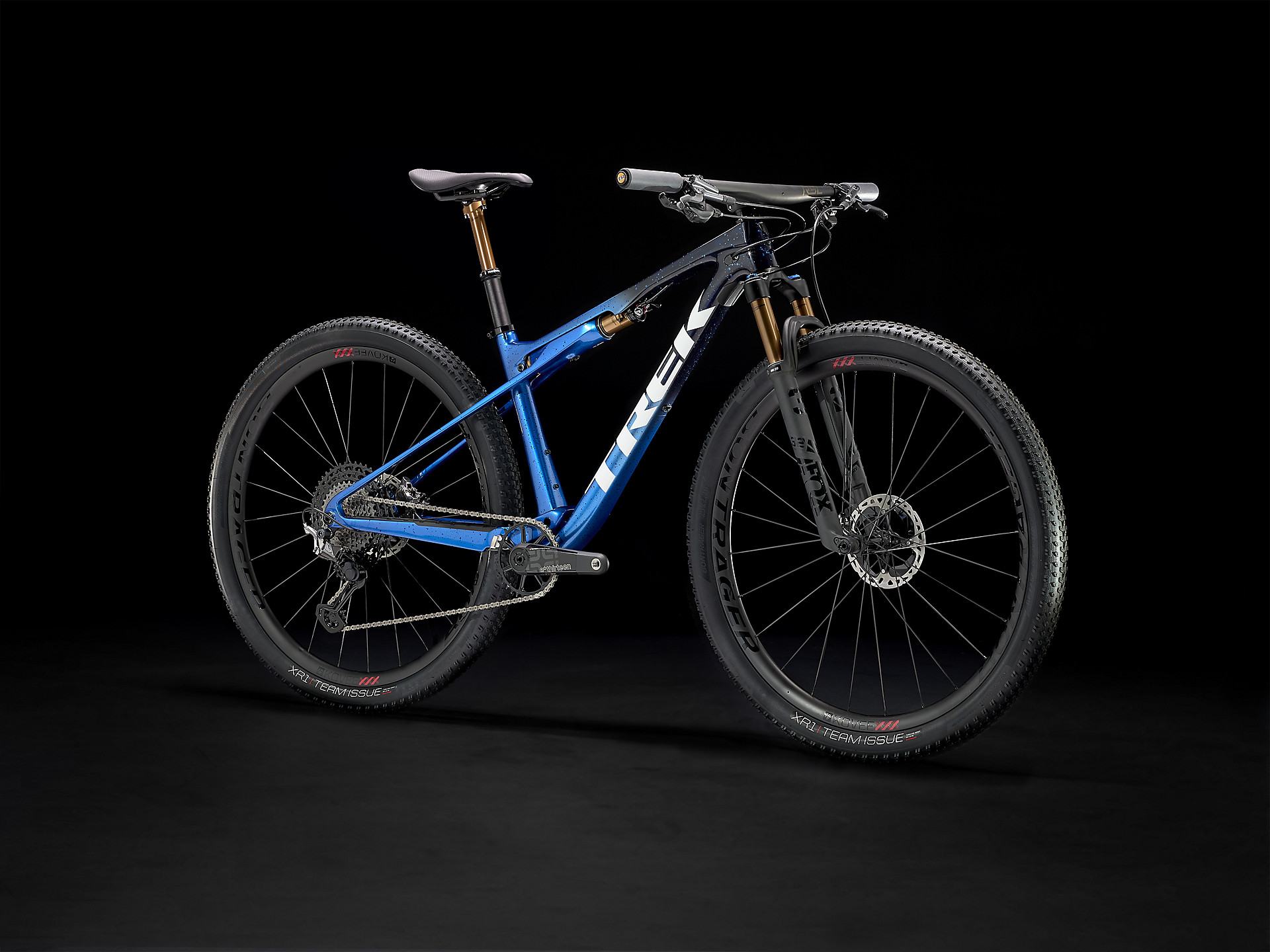
MRSP: $9,550 – $11,500
The Trek Supercaliber 9.9 is the most advanced model and comes from their latest lineup. It comes in two builds, SRAM XX1 AXS and Shimano XTR, with almost $2,000 separating them.
Both Supercaliber 9.9s get Fox Float Factory shocks. In addition, the XTR has a Factory 32 Step-Cast Float fork, and the top model gets a RockShox SID SL Ultimate.
The wheels are Bontrager’s highest grade Kovee XXX carbon wrapped in XR1 Team Issue tires. Unusually, the XTR is the only version with a dropper post, a Fox Transfer SL 100mm.
Finally, the Trek Supercaliber 9.8 XX1 AXS has SRAM Level Ultimate brakes. Both weigh approximately 21.5lbs.
How Does the Trek Supercaliber Perform on the Trails?
The Trek Supercaliber is a high-performance machine built for speed. So it’s no surprise that this bike is used by world-class cross-country athletes , including Jolanda Neff, in her 2021 Olympic XCO win.
Where Does the Trek Supercaliber Thrive?
Trek Supercaliber weight and pedaling efficiency are its two standout characteristics. With an unusually light build for one of the best full-suspension bikes , you will have a distinct advantage over your competitors in a race environment.
This efficiency comes from the stiff and lightweight OCLV carbon fiber frame with IsoStrut suspension. IsoStrut ensures you get maximum power from each pedal stroke for an incredibly snappy feel when you put the power down.
This bike is so efficient that the remote suspension lockout is only really beneficial for sprint efforts. The racey geometry of the Supercaliber means it is agile and responsive for cross-country-style trails, allowing you to maneuver tight situations and pick the smoothest line.
Although it doesn’t ride like traditional 100mm XC bikes , it’s not far off. The 60mm travel in the rear provides just enough extra traction and comfort when you need it.
To get the best out of this bike, it helps to ride aggressively, attacking chunkier sections to avoid getting hung up.
What Can Be Better?
There’s not much we would change about this bike. For the casual rider, the 60mm rear travel means this bike will quickly bottom out on big hits, meaning you’ve got to be more conservative on chunkier terrain. That said, this isn’t a bike for your typical rider.
The one component that may be worth changing for some riders is the narrow 720mm handlebars. In addition, we’d like to see a dropper post to improve the bike’s overall capability.
Trek Supercaliber Sizing
The Trek Supercaliber frameset is available in six sizes, S to XXL, with a rider height range from 5′ to 6’8″.
- S – 5′ to 5’6″
- M – 5’3″ to 5’8″
- M/L – 5’5″ to 5’10”
- L – 5’10” to 6’2″
- XL – 6′ 1″ to 6’5″
- XXL – 6’5″ to 6’8″
This bike is a significant investment, so you’ll want to ensure it fits perfectly. If you fall between two frame sizes , visit a Trek dealer near you to test-ride the two models that might work. Alternatively, you can compare the Trek Supercaliber size chart and geometry to an XC bike you’ve ridden before.
Bottom Line: Should You Buy a Trek Supercaliber
As we’ve seen, the Trek Supercaliber is a highly-specialized XC mountain bike, limiting its appeal to the broader market.
Incredibly efficient suspension, a stiff, lightweight frame, agile geometry, and industry-leading components give this bike its ability on cross-country trails.
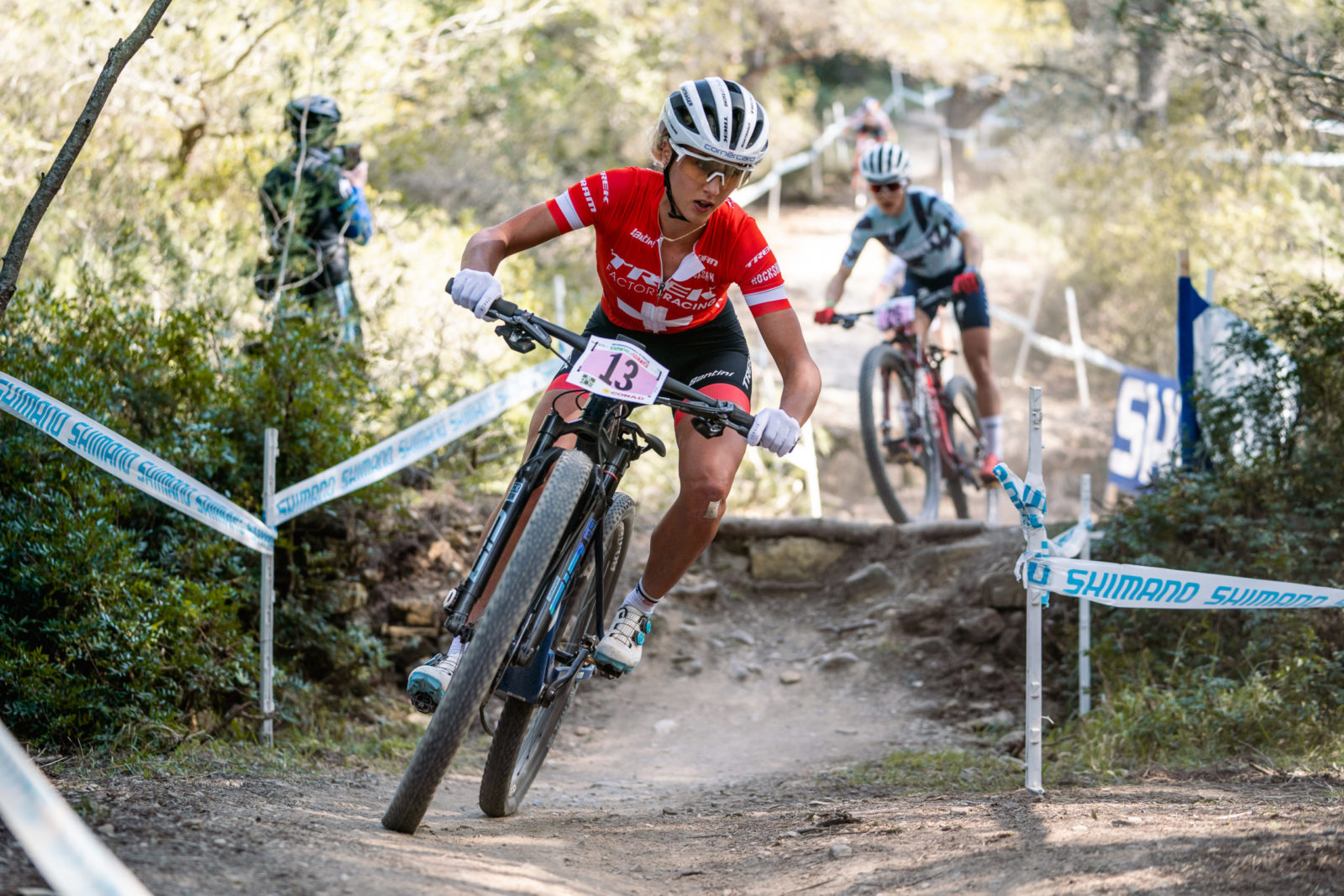
Jolanda Neff riding her Trek Supercaliber XC race bike to Olimpic victory.
This ability makes the Supercaliber an excellent choice for ambitious XC riders who want a bike to help them smash their PRs and win races. However, if you’re not obsessed with speed and just want a bike to handle a variety of trails and climb well, the Supercaliber mightn’t be for you.
Add this premium race bike to your shortlist if you want pro-level performance and have the budget to match.
Shop on TrekBikes.com
Share this on:
About the Author

Jordan Grimes
10 thoughts on “ trek supercaliber review — podium-winning xc race bike ”.
Thanks so much for your assistance in my purchasing decision. Great article by the way!
You’re welcome, Edward! Have fun riding!
Thanks. Which SLR 2024 Supercaliber model would you recommend for an enthusiast who might race only once a year?
The lowest-priced SLR 9.8 XT Gen 2 should be plenty good!
I have a 2021 Trek Procaliber and love it. How would a 2024 Supercaliber compare to my Procaliber in shock absorption, handling, weight, etc.?
Hi Edward! To be honest, the two would feel very similar to ride, though the shock absorption and handling would be better on the 2024 model considering it has 10mm more travel and the carbon fiber technology is getting better and better in terms of weight and compliance. Other than that, they don’t differ all too much.
Thanks for your response. What would be a great alternative to the 2024 Supercaliber? How about the Specialized cross country bike? Or others?
Specialized Epic is a great alternative. At the moment, Specialized is running a massive discount, so you can get the full suspension Epic EVO for just $2,400 (down from $4,000), which is a pretty good deal (though stocks might be low). You could also consider the Specialized Chisel (Hardtail) or Canyon Lux, both are excellent choices.
Does the 2024 model now appeal to a broader base of non racers? Thanks.
I wouldn’t say so, Edward. The 2024 Trek Supercaliber is still an XC race bike—the cheapest model has a carbon frame and costs $4,300. Non-racers can get it, but it’s a commitment.
Leave a Reply Cancel reply
Your email address will not be published. Required fields are marked *

- Pinkbike.com
- Register New User
- First Looks
- Friday Fails
- Community Blogs
- Fantasy League DH
- Places Directory
Field Test: 2020 Trek Supercaliber - Short On Travel, Not on Traction
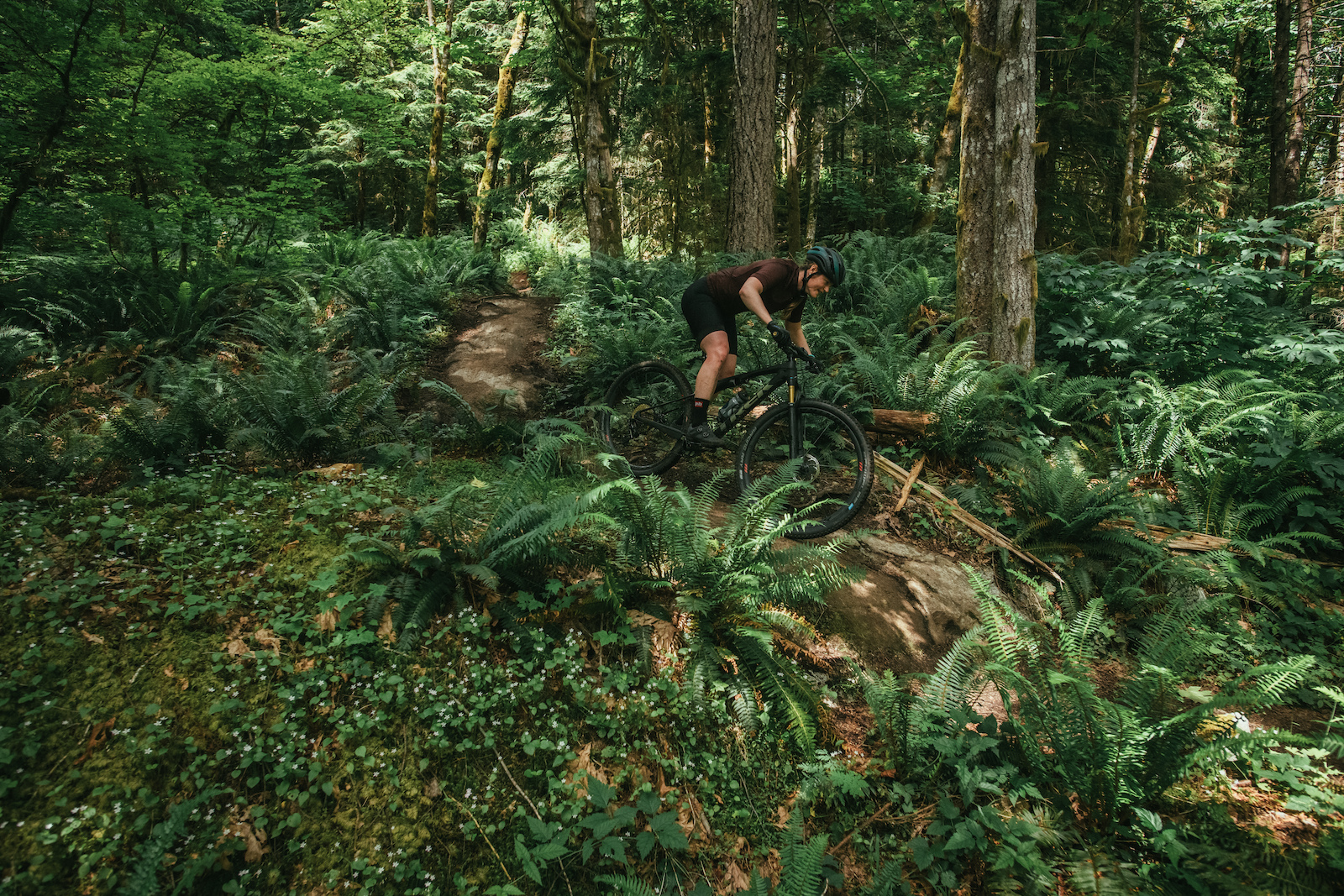
Cool Features
Trek Supercaliber SLR Gen 2 9.9 XX AXS – highly efficient, super taut XC racer
Trek’s dedicated, xc racer has had a complete overhaul so just how super is the supercaliber now.
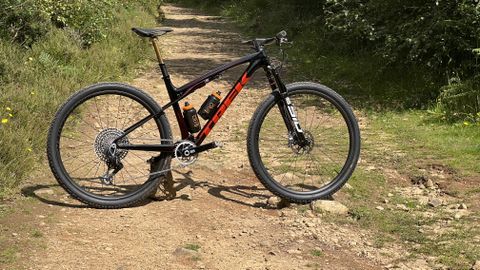
BikePerfect Verdict
Trek’s new Supercaliber rides exactly how you’d want for super efficient XC speed but it’s not as versatile or smooth as longer travel XC bikes and it’s heavier than some too.
Super efficient pedaling
Firmly fast ride feel
Balanced XC handling
200g lighter than before
Dropper post on every bike
Smart race and servicing details
Heavier than some longer travel bikes
Multi cable chaos
Skinny tires on the XX AXS
Why trust BikePerfect Our cycling experts have decades of testing experience. We'll always share our unbiased opinions on bikes and gear. Find out more about how we test.
Trek’s Supercaliber has been a super successful racer with both Olympic and World Championship wins to its name. They haven’t disturbed the hidden shock silhouette that makes Trek's best XC mountain bike instantly recognizable either but everything else about the G2 bike - including the unique IsoStrut suspension - has been evolved for an even faster result.
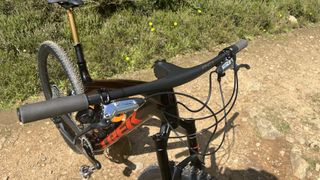
Design and geometry
I’ve already covered a lot of the construction changes and development story of the new G2 in Trek Supercaliber news article , but here’s a quick recap. The OCLV carbon frame looks the same but all the tube shapes have been revised and higher-quality composites used in several sections. The Knock Block steering limiter has gone as Trek’s pro racers generally removed it to get the stem lower anyway and the lightest SLR frame loses the internal cable trunking. That means around a 200g weight saving over the previous Supercaliber frame depending on size.
The super-wide PressFit 92 bottom bracket stays to allow similarly wide seat tube, down tube, and main pivot dimensions to maximize stiffness so the new bike is as rigid as the old one under power. While the PF BB isn’t popular in terms of longevity or quietness Trek’s decision to stick with conventional internal control routing rather than headset-based hiding gets a servicing thumbs up. There are two bottle cages included too although the seat tube mount will only take a standard 600ml bottle even on a large frame.
Geometry is balanced between adding stability and familiarity for the hyper-sensitive biometrics of pro racers or time-served traditionalists. That equates to a 67.5-degree head angle that’s 1.5 degrees slacker than before and slightly longer chainstays, but an only slightly longer reach at 460mm on the large and a middling 74.5-degree seat angle. The bottom bracket height goes up slightly to reflect the increase in travel from 60mm to 80mm and the main pivot also comes up 10mm in the frame.

Components and build
The new Supercaliber SLR comes in five complete 9.9 / 9.8 builds - XX, XO, and GX from SRAM plus XTR and XT from Shimano. Then there are SRAM (9.7) and Shimano (9.6) builds on the heavier SL bikes. All bikes get the same ‘IsoStrut’ suspension though which uses a sealed shock tube built into the top of the flex seat stays to ‘milk’ the 38mm shaft bolted into the top tube. For the G2 this is made in collaboration with RockShox using a mixture of SIDLuxe style internals and ZEB fork bushings and seals. The fork is the latest SID SL from RockShox in the maximum 110mm travel option and both fork and shock have lockout settings controlled via a TwistLock grip on the left-hand side of the bar. Stop and go gear is top drawer SRAM with Level Stealth Ultimate four pot brakes and carbon-rich, AXS wireless controlled XX SL T-Type gearing with a 34 tooth chainring.
Trek’s component brand Bontrager provides the -13 degree one-piece carbon cockpit, carbon-railed Aeolus saddle, superlight 1245g Kovee RSL wheels, and new St Anne RSL cross-country tires . The SID SL spec means the XX bike has to use ‘2.2in’ wide (actually 54mm or 2.1in) rubber, while all other bikes get 2.2in (actually 59mm or 2.3in wide) versions of the tire.
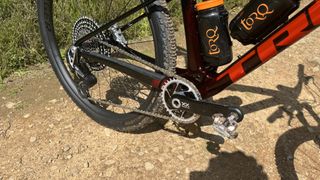
Ride, handling and performance
First things first, let me make it clear that the Supercaliber is a serious race/speed bike. Trek officially allows 100mm and 120mm fork options on either side of the 110mm default to slightly adjust the geometry. Design lead Alex Martin said they’d also ridden the bike with a 130mm fork and chunkier tires for fun. They’ve deliberately not followed the current XC/fast trail trend of creating two bikes out of one by offering a 100mm fork and short shock option and a 120mm fork and longer shock option on the same frame platform.
Even with a 20mm increase in travel, the unique IsoStrut shaft shock is a race damper though. Leverage has been slightly increased, boosting sensitivity and progression in the process, but It’s still a very low pressure (I ran 100-110 psi with a 72 kg loaded rider weight) set-up. Low-pressure shocks always feel ‘sticky’ and that’s compounded by the notoriously tight Zeb bushings on the IsoStrut. Even though Trek individually size the bushings and strut on each bike to find optimal tolerances you need to be patient for them to ease up a bit. Inevitably the more you ride the bike the smoother you think it is as the body adjusts too, but switching back to longer travel conventional XC bikes immediately underlines that this is a skimmer, not a smoother. Even running 30 percent sag to get full travel regularly, you normally only realize that’s happened when you check the travel ring when you stop riding. There’s certainly no sense of sag or wallow from the back end when you’re getting back on the power, coming out of rough sections or lumping through the pockets between roots and rocks and/or when low pedal revs are doing their jerky, janky thing.

That’s totally fine when you’re on the power, with that extra anti-squat tightening the suspension further so you skip across the top of roots and rocks with just enough movement to stop you from getting choked like a hardtail. It lands decent-sized drops with a lot more control and calm than a hardtail too. The new longer travel, stiffer crown SID SL can handle more hammer than you’d probably expect too. It feels awesome under power-up climbs too where the structural stiffness of the IsoStrut and broad BB frame gives it a real edge against more 3D flexible conventional shock and linkage bikes. Overall sharpness feeds the dilated pupil, hunter vibe that I think a truly dedicated race bike should have, creating an unspoken agreement that you’re both going to go full gas for as long as it takes, even if that’s a lot longer and harder than is comfortable.
The inevitable flip side of this is compromised comfort and traction compared to a more flowing bike. That’s particularly true with the stock 2.2 tires fitted which pretty much eradicates any chance of inserting a save between “Everything is OK - damn that hurts’ moments. Even with 2.4 versions of the St Anne tires fitted to screen out some of the chatter and slither the high Anti Squat scatters gravel and shaves sideways off roots and rocks under power more than a neutral set-up. On the flip side, you’ve got a ton of feedback to know exactly where to apply that power for your own traction control/torque judgments and I’d have that over-depressing, watt muffling mush. It’s a credit to how efficient the bike pedals that I rarely twisted the shock into lock mode and comparing it to the new SID set up ‘Open’ on the Supercaliber feels like ‘Pedal’ on the 3P damper.
The excellent ‘skip across a section at full throttle’ moments of velocity affirmation when you’re fresh or just feeling ferocious are also balanced by the hookups and chokes when you don’t quite hit/maintain ‘skip across’ speed and there’s no extra smoothness or travel to keep you afloat. Even set up soft with the bigger tires there’s no pillowy plush for reducing the shoulder, wrist, leg, and back fatiguing beating that epic rides or longer/rougher descents dish out either.

Trek Supercaliber versus Specialized Epic World Cup
Questions on how the new Supercaliber compares to the superficially similar Specialized Epic World Cup started as soon as I posted pictures of the bike on social media, so here's my take. Unsurprisingly it all revolves around the shock and suspension kinematics. That’s because while the 66.5-degree head angle and 73.5-degree effective seat angle of the Epic are a degree slacker on paper, once you’ve added the sag effect of the Trek against the minimal sag Specialized they’re basically the same shape on the trail. There’s only a 5mm difference in the suspension travel too, but how it’s delivered is very different.
Basically, the World Cup uses a unique WCID version of the RockShox SIDLuxe shock where you get to set the negative chamber inflation volume and therefore sag yourself. Even in the ‘Full Gulp’ setting, that’s a minimal amount of sag so the shock feels ‘topped out’ a lot of the time. Add the inertia valve of the BRAIN fork used on every model and that often means an uncomfortable feel when cruising. Specialized have given the bike surprisingly low anti-squat figures though so powerful pedal strokes can still compress the shock enough to cause a noticeable ‘bob’ even in ‘Zero Gulp’ mode. Low anti-squat means once the shock is moving the bike feels very mobile and open. That’s great for smoothness and traction, but it feels surprisingly mushy under power despite the frame feeling structurally taut. As the shock set-up is based on completely deflating the shock there’s no way to change how it feels while riding either.
In contrast, the Trek just feels like an efficiency/stiffness-optimized version of a conventional bike, staying taut under power and moving just enough when needed without ever undermining that muscular, zero-watts-wasted feel. Interestingly while the claimed frame weights are 150g in Specialized’s favor and the complete S-Works has a rigid carbon post, not a dropper, the BRAIN fork means actual complete bikes are within a few grams of each other on the scales, and the Supercaliber doesn’t have a power meter (60g extra).
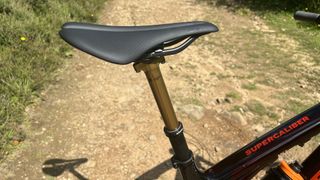
So just how super is the Supercaliber? Flick up to the ‘downers’ section at the start and you’ll see me complaining about the busy cable routing, the creak potential of the PF92 BB and the fact that the frame/shock is significantly (for XC heads at least) heavier than more versatile, longer travel ‘conventional’ XC options.
If you’re looking for a bike that is focused on delivering race track speed rather than having one eye on trail saleability though the Supercaliber is a blisteringly fast, pedaling-optimized weapon even by contemporary XC standards. Judging by how well the previous bike sold and how many comments I’ve had asking “I just want to know if it’s a proper race bike?” This lighter, faster, and more aggressive G2 version will be an even bigger success. Running softer with bigger tires should be on the short list of a lot of marathon/epic riders too and I’ve certainly had a serious amount of type 2 fun on it during testing.

Test conditions
- Surface: Gravel, road, roots, rocks, peat, mud, sand, rock gardens, sketchy steps
- Trails: Blue and red grade trail centre, natural singletrack in the local tech woods and mixed sheep track/double track out in the middle of the moors.
- Weather: Dry to drizzle. 15 - 24 degrees
Tech spec: Trek Supercaliber SLR Gen 2 9.9 XX AXS
- Discipline: XC Race
- Price: $11,699 / £10, 800 / €11,499
- Head angle: 67.5 degrees
- Frame material: OCLV SLR carbon fibre
- Fork: RockShox SID SL Ultimate 110mm travel
- Shock: RockShox/Trek IsoStrut SIDLuxe 80mm travel
- Size: S, M, M/L, L (tested), XL
- Weight: 9.75kg
- Wheel size: 29in
- Chainset: SRAM XX SL 34T, 170mm chainset with DUB PF92 bottom bracket.
- Rear mech: SRAM XX SL Eagle AXS, T-Type
- Shifter: SRAM XX SL Eagle AXS
- Cassette: SRAM Eagle XS-1299, T-Type 12-speed 10-52T
- Brakes: SRAM Level Ultimate 4-piston disc brakes with 160mm rotors.
- Tires: Bontrager Sainte-Anne RSL XR 29x2.2in rear tires
- Wheels: Bontrager Kovee RSL, OCLV Mountain Carbon
- Bars: Bontrager RSL Integrated OCLV Carbon 750mm handlebar and 85mm stem
- Grips: RockShox TwistLoc Ultimate remote with foam grips
- Seat post: Fox Transfer Factory SL 125mm dropper
- Saddle: Bontrager Aeolus RSL, carbon rails

Guy has been working on Bike Perfect since we launched in 2019. Hatched in Yorkshire he's been hardened by riding round it in all weathers since he was a kid. He spent a few years working in bike shops and warehouses before starting writing and testing for bike mags in 1996. Since then he’s written several million words about several thousand test bikes and a ridiculous amount of riding gear. To make sure he rarely sleeps and to fund his custom tandem habit, he’s also penned a handful of bike-related books and talks to a GoPro for YouTube, too.
Current rides: Cervelo ZFS-5, Forbidden Druid V2, Specialized Chisel, custom Nicolai enduro tandem, Landescape/Swallow custom gravel tandem
Height: 180cm
Weight: 69kg
Canyon unveil its lightest electric mountain bike ever – the Neuron:ONfly
Canyon Strive:ON CFR review – a UCI EDR-E championship-winning, carbon, full-fat enduro e-bike
Cervelo’s new Aspero gravel bike still hauls ass, but doesn’t kick your ass as much in the process
Most Popular
Gear-obsessed editors choose every product we review. We may earn commission if you buy from a link. How we test gear.
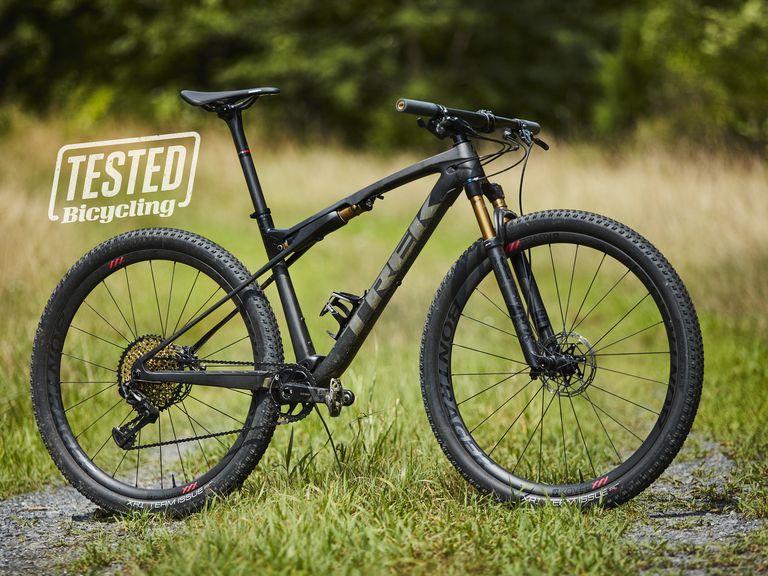
The Trek Supercaliber Is the New XC Race Benchmark
After two months of testing Trek’s top-secret, UCI World Cup race bike, we can confirm this about the Supercaliber: It’s fast as hell.
The Takeaway: Sharp and lightweight, the brand new Trek Supercaliber is a dedicated XC race machine.
- IsoStrut rear suspension is integrated into the frame and provides 60mm of rear travel
- There’s a 100mm Fox Factory 32 Step-Cast fork and remote lockout for the fork and strut
- This 21-pound bike absolute screams
Price: $9,499 Weight: 21.2 lb. (L) Tire clearance: 29 x 2.2 in.
The Trek Supercaliber is the worst-kept secret in mountain biking this year: It’s been rumored, spy-shot, and raced throughout the UCI Mountain Bike World Cup by high-profile Trek pro riders Jolanda Neff and Ellen Noble, with its top-secret rear suspension shielded by a fabric sleeve. That Trek designed a custom sleeve just to disguise the Supercaliber’s rear end tells you something about the black magic at the back.
Now, the secret’s out, and its name is IsoStrut. The Supercaliber is an unapologetic, uncompromising XC-race machine, and IsoStrut is what separates it from any other bike you can buy today. The structurally integrated system uses a main pivot and a custom-designed Fox shock that lives within a Kashima-coated strut. There’s no pivot at the rear axle; the thin seatstays are designed to flex. The shock provides about 55mm of rear travel, with the flexing stays adding 3 to 5mm of deflection for a total rear travel figure of 60mm.
Trek Supercaliber

The Supercaliber aims to bridge the gap between fast-pedaling hardtails and more capable full-suspension race rigs. On XC-oriented singletrack, with rocks and roots but no obstacles larger than you’d find on a World Cup course, the ride is sublime. The 21-pound bike pedals extremely well: There’s almost no apparent bob under hard acceleration, yet the suspension becomes active over rock gardens and descents. Even on trickier terrain, the 60mm of rear travel never felt like a limiting factor—leave that to the sharp 69-degree head angle. With quick steering and 1,290-gram Bontrager Kovee XXX 30 wheels (on our Supercaliber 9.9), the bike corners fast and feels snappy and direct as you load and unload the suspension into the trail.
The Supercaliber will come in four different builds, starting with the SRAM NX Eagle-equipped Supercaliber 9.7 at $4,799 and ending with the SRAM Eagle AXS bike at $10,999. Trek tells us the models will be in U.S. dealers by early November, so you’ll have time to move some money around before next year’s XC season.
XC-Optimized Frame
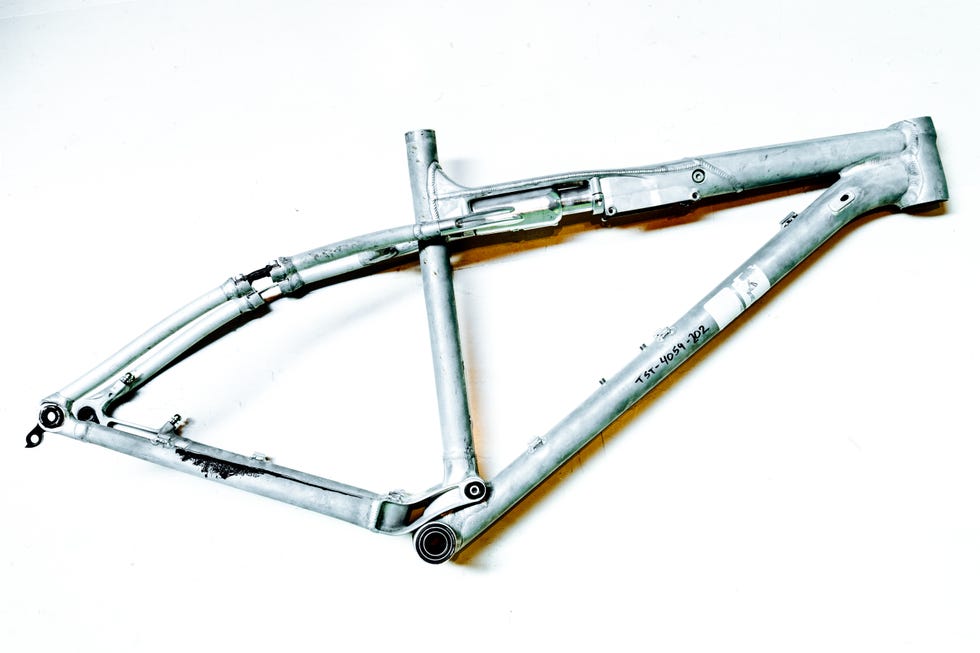
The Supercaliber has been in development for three years as Trek grappled with the essential XC race-day question: Do you spring for an efficient-pedaling hardtail or a fast-descending full-suspension model? Prior to this season, Trek pro riders could pick the Procaliber—a 100mm hardtail with a rear decoupler that provides 11mm of undamped travel—or the 120/115mm Top Fuel, a full-suspension bike that’s become slacker and less race-focused over its lifespan.
The company observed that its racers tended to pick the Procaliber if they thought they could get away with riding a hardtail, reserving the Top Fuel for the most challenging courses, says Trek MTB brand manager Travis Ott. That defines the rationale for the Supercaliber: a short-travel full-suspension rig with the lightness and responsiveness of a hardtail.

The ground-up race focus is apparent. The size medium frame weighs 1,933 grams—23 grams less than a medium Procaliber—a weight made possible by eliminating the swing link and second pivot at the rear axle and instead using thin, low-modulus carbon fiber seatstays to handle the IsoStrut’s travel. The flexing stays also add 3 to 5mm of additional travel. Trek uses three sizes of rear triangle to tune the frame for different rider sizes and maintain low standover heights across the size range. All frame sizes carry two bottles, and the top three models come with dual remote lockout.
.css-1hhr1pq{text-align:center;font-size:1.1875rem;line-height:1.6;font-family:Charter,Charter-roboto,Charter-local,Georgia,Times,Serif;}.css-1hhr1pq em{font-style:italic;font-family:Charter,Charter-styleitalic-roboto,Charter-styleitalic-local,Georgia,Times,Serif;}.css-1hhr1pq strong{font-family:Charter,Charter-weightbold-roboto,Charter-weightbold-local,Georgia,Times,Serif;font-weight:bold;} 5 Things We Love About the Trek Supercaliber
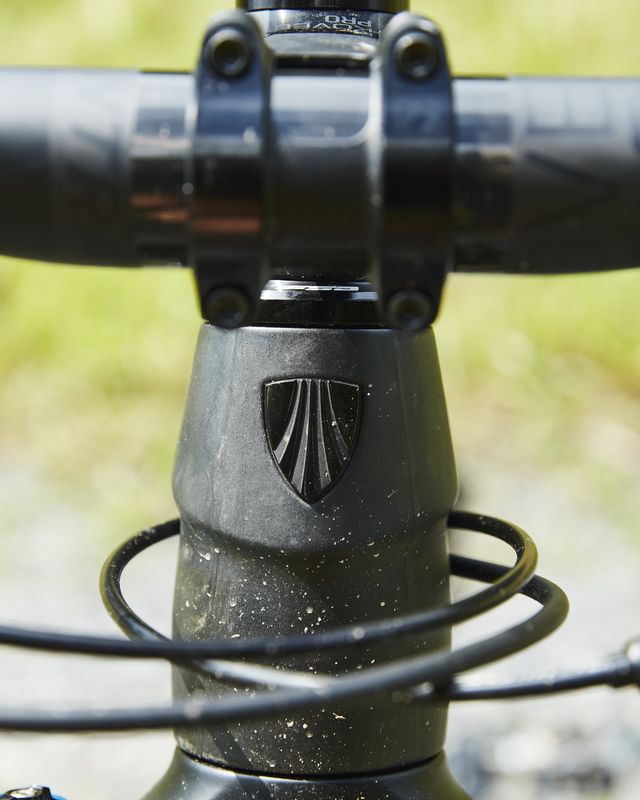
OCLV Carbon
The frame somehow weighs less than Trek’s hardtail XC race bike, the Procaliber.
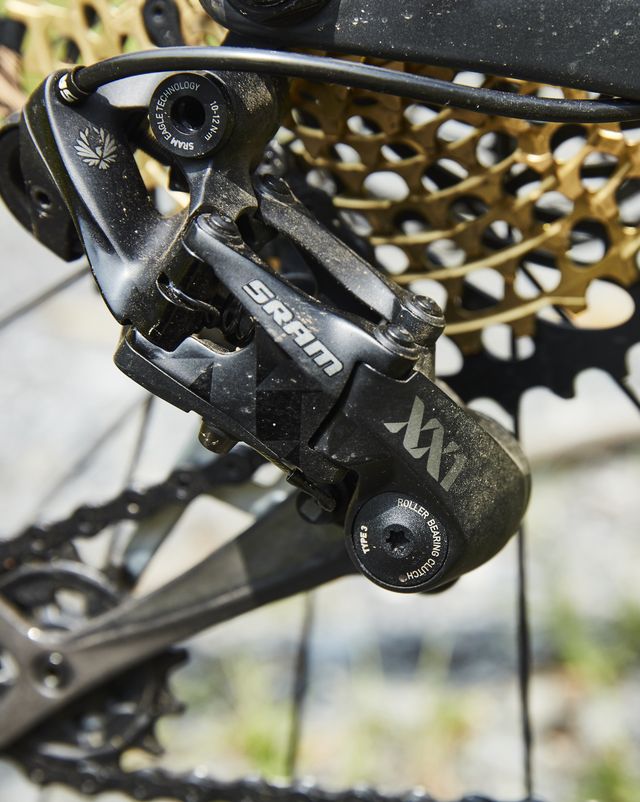
Crisp, reliable mechanical shifting with a 500 percent gear range.

Remote Lockout
Press the lockout lever for ultra-powerful pedaling on the flats.
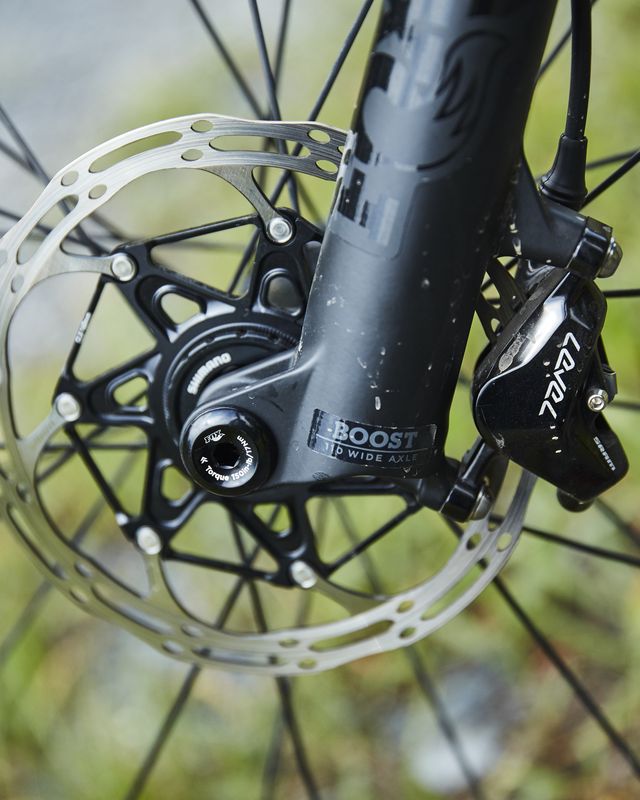
SRAM Level Discs
The SRAM Level Ultimate hydraulic discs give you controllable stopping power.
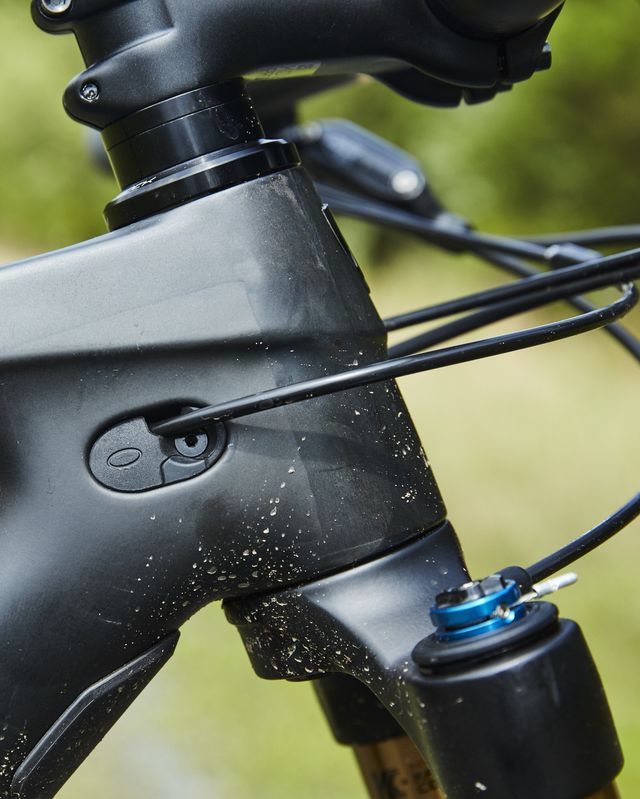
Internal Routing
Keeps the cables out of the way and lends a slicker aesthetic.
The first thing to know about IsoStrut is that it’s part of the Supercaliber’s frame, with front and rear mounts that connect the front and rear triangles beneath the top tube. The Fox shock mounts within the front of the strut, with an anti-rotational pin inserting into the shock’s stanchion mount to prevent twisting within the strut.
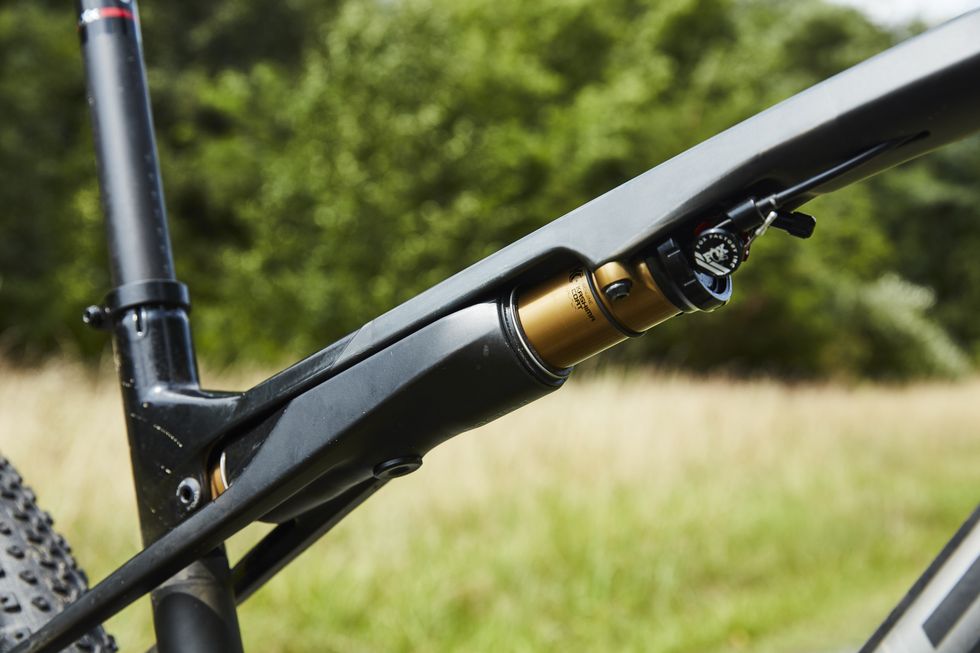
A carbon fiber carriage connects the Kashima-coated strut to the rear triangle, with fork-style bushings and wiper seals to maintain a smooth stroke. When the shock compresses, the carriage moves forward along the strut. And because the carriage is part of the rear triangle, the seatstays flex as the shock and carriage move. Press into the suspension and you’ll feel the rear end unload with a snap, a possible byproduct of the stays returning to their original shape.
Inside the IsoStrut
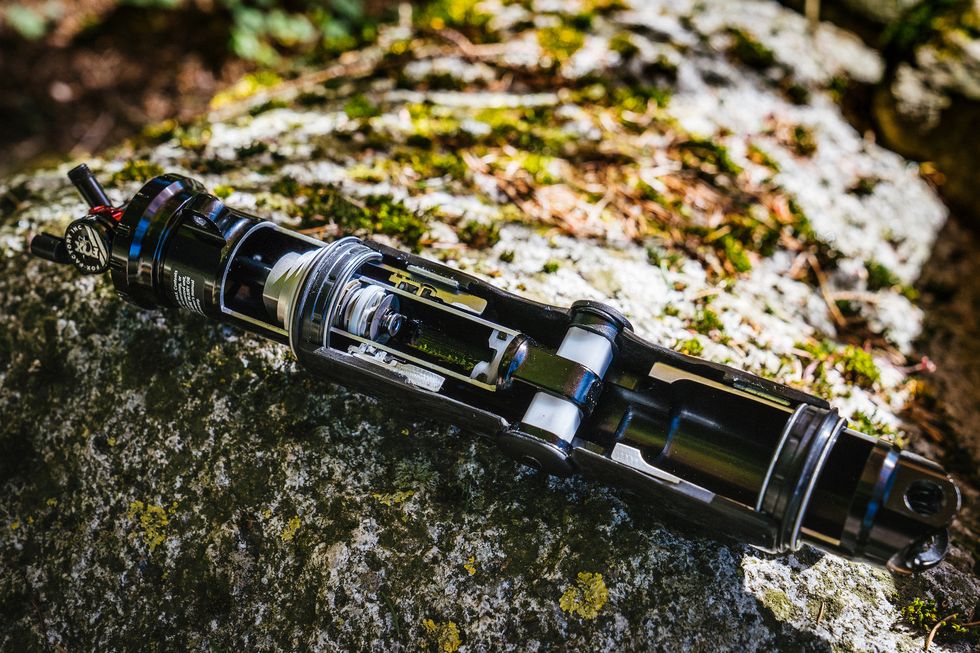
Trek includes two sizes of volume reducers to provide additional progression and bottom-out support. At 170 pounds, I ran the bike without any reducers, as the IsoStrut felt plenty progressive for my weight. Despite the combined 60mm of rear travel, I never felt the bike bottom out, even though the strut’s o-ring indicated that I’d used all of the travel—the soft stays and low (1.7–1.8) leverage ratio might explain why I never felt myself hit the end of the travel.

Uncompromising Componentry

The only expenses spared on the Supercaliber 9.9 are the fork and drivetrain (the Supercaliber 9.9 AXS upgrades you to electronic shifting and a RockShox SID Ultimate fork). The rest of the 9.9 is top-shelf, starting with the ultralight Bontrager Kovee XXX 30 carbon wheels and Bontrager XR1 Team Issue tires. It’s a fast-rolling combination, although they’re not the tires I’d choose for wet rocks and roots.
That shiny, gold XX1 Eagle 10-50t cassette gives you a 500 percent gear range that keeps you pedaling on any incline, and the XX1 Eagle drivetrain itself shifted quickly and reliably during testing. The SRAM Level Ultimate hydraulic disc brakes modulate well, not giving you full power until you’re really pulling the levers, which helps you control your stopping when you rocket into a late apex and grab the brakes with a bit of force. The saddle is Bontrager’s firm-yet-comfortable Montrose Pro, the cockpit is all Bontrager Kovee Pro and XXX carbon bits, and at the end of the bar you’ll find lovely, soft ESI silicone grips.
Trek Supercaliber 9.9 Details
Frame Carbon Travel 60mm Shock Fox Factory DPS Fork Fox Factory 32 Step-Cast, Float EVOL air spring Drivetrain SRAM XX1 Eagle Cassette 10-50t Tires Bontrager XR1 Team Issue, 29 x 2.2 in. Rims Bontrager Kovee XXX 30 carbon Brakes SRAM Level Ultimate (160mm rotors front and rear) Crankset SRAM XX1 Eagle DUB, 34t Stem Bontrager Kovee Pro Handlebar Bontrager Kovee XXX Saddle Bontrager Montrose Pro Seatpost Bontrager XXX
The Supercaliber Family
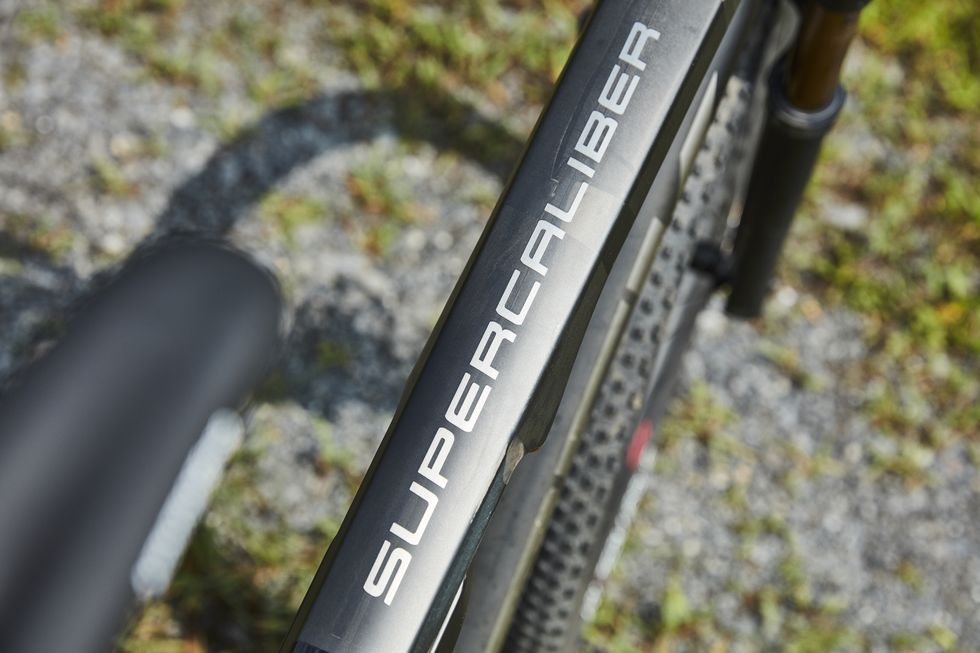
The base Supercaliber 9.7 gives you the same OCLV carbon fiber frame, IsoStrut, Boost 148mm spacing and internal routing as the rest of the line. To keep the price at $4,800, it comes with a SRAM NX Eagle 1x12 drivetrain, a RockShox Reba RL fork, a Fox Performance shock, and Bontrager Kovee Elite 23 carbon wheels.
The next step up is the $5,900 Supercaliber 9.8, which adds dual remote lockout, SRAM GX Eagle, and a Fox Performance 32 Step-Cast fork. The $9,500 Supercaliber 9.9, our test bike, upgrades you to a Fox Factory 32 Step-Cast Fork and a Fox Factory shock, SRAM Level Ultimate hydraulic discs on 160mm rotors, and Bontrager Kovee XXX 30 wheels. The top-end bike is the $11,000 Supercaliber 9.9 AXS, with SRAM’s Eagle AXS electronic shifting and a RockShox SID Ultimate fork.
Ride Impressions
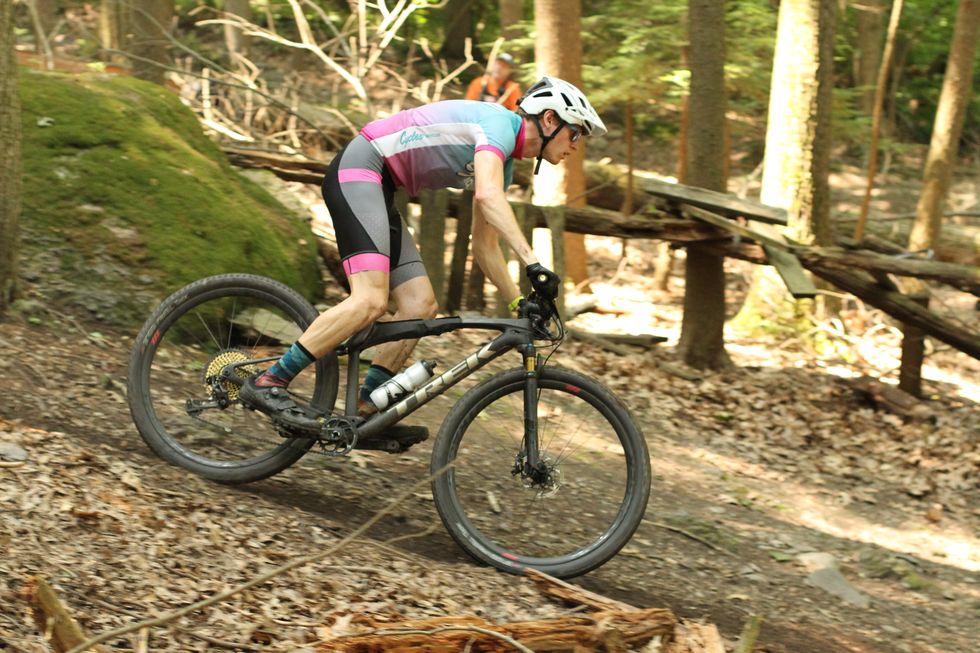
I raced the Supercaliber at two Mid-Atlantic Super Series races and a couple local short-track events during my two-month testing period. It’s effing fast: On XC-designed courses, it annihilates full-suspension bikes through sections with hard pedaling and doesn’t give up anything on the descents. The bike picks up speed so quickly that the trail just comes at you faster than usual—I quickly realized that I was the limiting factor.
The feeling of IsoStrut is uncanny. There’s an ever-so-slight pedal bob on flat sections of trail, but it’s shallower than on a 100mm full-suspension XC bike—I’m using the Canyon Lux CF SL 8.0 that I rode earlier this year as a comparison point. The Supercaliber feels more like a soft tail than a full-suspension bike under pedaling, but the IsoStrut becomes active when you start rolling over rocks and logs and roots.
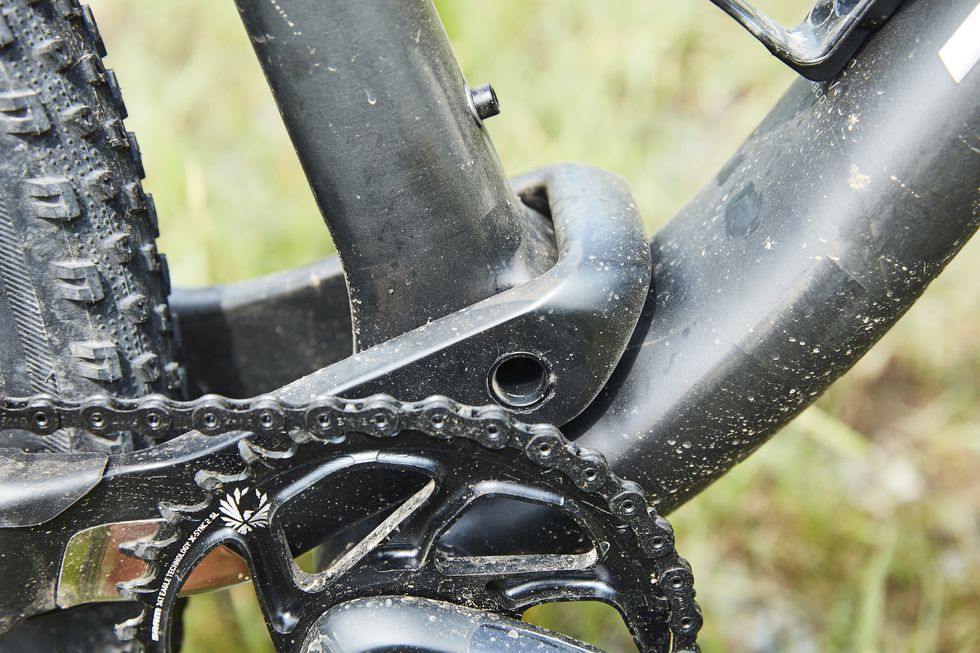
As a 170-pound rider, I experimented with shock pressures between 110 and 140 psi (the latter pressure is what Trek recommends for my weight). Lower pressures give the bike the small-bump compliance you’d expect from a full 100mm of rear travel, but sacrificed the IsoStrut’s snappiness, so I settled at 140 psi and 25 percent sag. That setup popped me off the saddle if I hit unexpected rocks while seated, but it pedaled a lot more efficiently and prevented me from blowing through the travel during descents.
Ride enough trail bikes with long, low, and slack geometry, and you might forget what’s it’s like to really control a bike. The Supercaliber reminds you fast: On more technical, definitely not-XC terrain, it’s a bike you have to ride very deliberately. There’s no slack head-tube angle, dropper post, or long-travel fork to save you if you get your line wrong. You certainly can find a rhythm on technical, root-filled trails, you just have to be a better bike handler than I am. The only thing I will blame on the bike is the tires: The team-issue Bontrager XR1s roll fast and grip well enough on dirt and mud, but they slide straight off the wet boulders and roots that line Eastern Pennsylvania’s rocky singletrack.
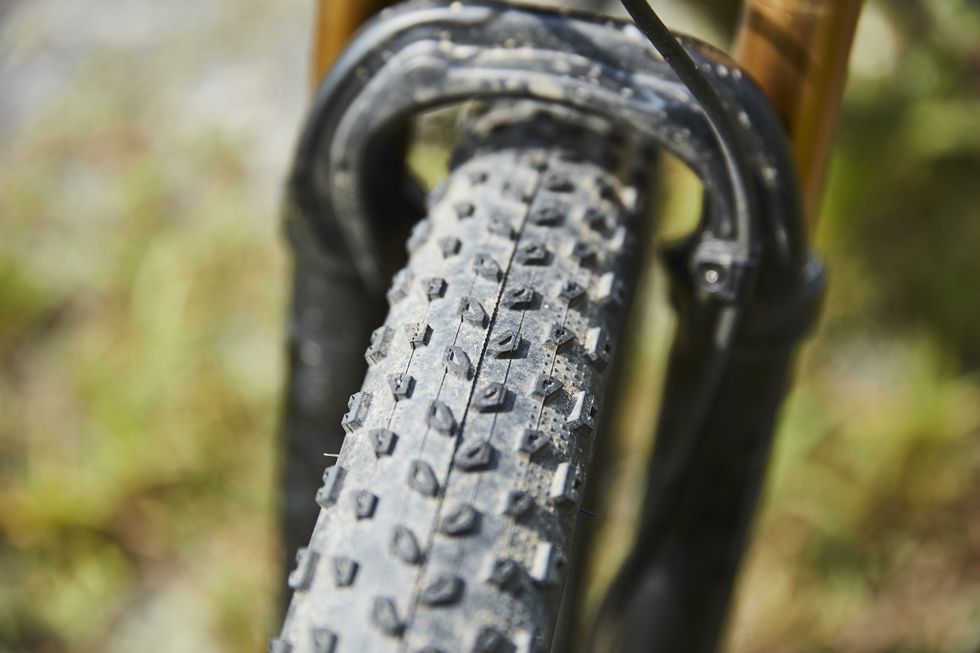
In its element, however, the Supercaliber is superb. The remote lockout is a full lockout, so you get razor-sharp pedaling response when you don’t need the suspension. The steering feels sharp and as a 29er, the bike maintains momentum with ease. It’s simply everything you want from an XC race bike. If someone riding a Supercaliber beats you next season, take solace in the fact that their bike is faster than yours.

A former Division 1 runner, Dan grew up riding fixies and mountain bikes and now reviews everything from performance running shoes to road and cross bikes, to the latest tech for runners and cyclists at Bicycling and Runner’s World.

.css-1t6om3g:before{width:1.75rem;height:1.75rem;margin:0 0.625rem -0.125rem 0;content:'';display:inline-block;-webkit-background-size:1.25rem;background-size:1.25rem;background-color:#F8D811;color:#000;background-repeat:no-repeat;-webkit-background-position:center;background-position:center;}.loaded .css-1t6om3g:before{background-image:url(/_assets/design-tokens/bicycling/static/images/chevron-design-element.c42d609.svg);} Bikes & Gear
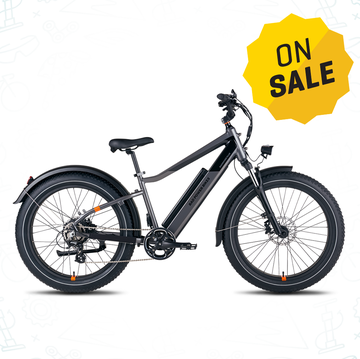
Road Tubeless Wheel System Guidelines and Tips

Fresh New Mountain Bikes and Gear for Spring
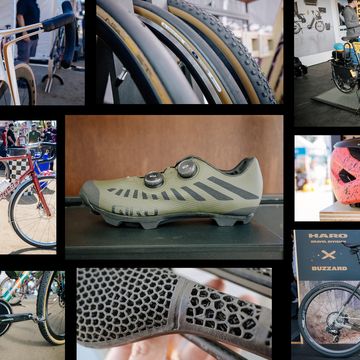
The Hottest Road and Gravel Bikes for Spring
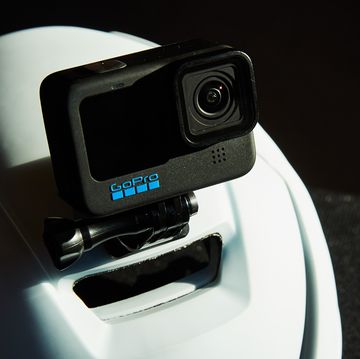
The Best Helmet Cameras for Fun and for Safety

Organic vs Metallic Disc Brake Pads—Which to Use?
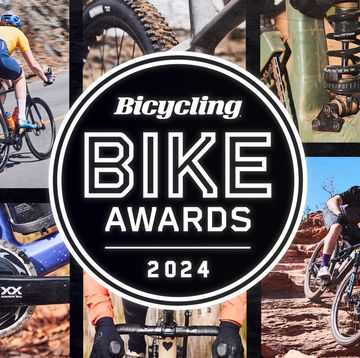
2024’s Best and Most Exciting Bikes!
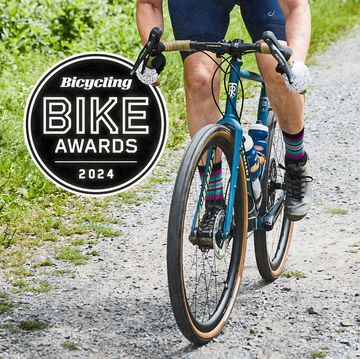
2024’s Best Gravel Bikes
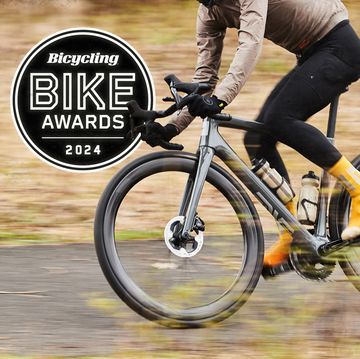
2024’s Best Road Bikes
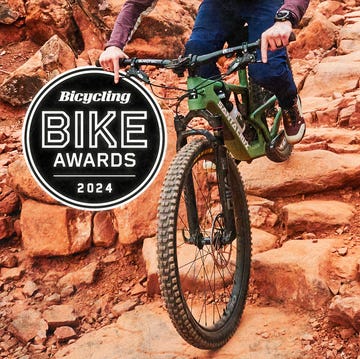
2024‘s Best Mountain Bikes

2024‘s Best Commuter and Urban Bikes
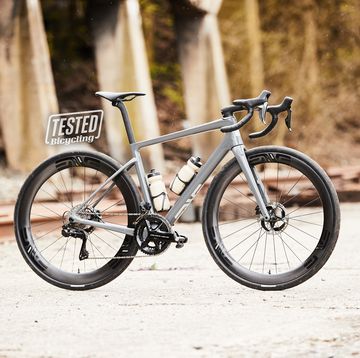
Enve’s Fray Is an All-Road Race Bike

2023 Trek Supercaliber 9.6 Review
The 2023 Trek Supercaliber 9.6 is a top-of the range full suspension cross country bike from Trek, the world leader in bicycle technology. But is it worth the high price tag?
Cross country cycling has grown significantly in popularity over the last few years, with more and more riders using dedicated bikes for their off-road adventures.
With so many options available on the market, it can be difficult to decide which one to buy.

The 2023 Trek Supercaliber 9.6 may just be the answer to your portable biking prayers. In this review, we will break down every element of this full suspension 29er and provide our insights into whether or not it’s worth your hard-earned money.
If you’re looking for a lightweight full suspension bike that packs a punch, then the Trek Supercaliber 9.6 is worth checking out.
Featuring a fast and efficient sole-ride IsoStrut Shock rear suspension system and state of the art geometry, this bike is perfect for tackling anything from trails to enduro racing.

In this review, we’ll be taking a look at the Supercaliber’s features and performance to help you decide if it’s the right bike for your needs.
The 2023 Trek Supercaliber 9.6 is the perfect bike for the trail-seeking cyclist looking to dominate everyday routes.
This full suspension ride offers an all mountain experience with the power to conquer climbs and tackle descents.

It features a lightweight OCLV Mountain Carbon frame, Shimano 1×12 drivetrain, and Fox Rear shock. Additionally, Shimano hydraulic disc brakes give you maximum control on your ride.
Whether you’re tackling a technical climb or navigating a tricky descent, the 2023 Trek Supercaliber 9.6 is there to help you tackle it!

– OCLV Mountain Carbon frame for lightweight yet strong performance
– Shimano 1×12 drivetrain for precision and reliability
– Fox Performance rear shock 235mm X 32.5mm absorb terrain impacts
– RockShox Recon Gold RL front shock with Motion Control damper, remote lockout, and 100mm of travel
– Shimano hydraulic disc brakes for consistently smooth braking experience
– Bontrager XR2 Team Issue, Tubeless Ready 29×2.2 inch tires offer grip and traction on dirt trails

Frame Design
The Trek Supercaliber 9.6 makes use of a tried-and-true OCLV carbon fiber frame design, which combines lightweight material with rigidity and vibration damping for comfort during those long rides.
This frame is also amenable to lighter trail components that keep the overall weight down while maintaining exceptional performance characteristics.
The frame also features trek’s signature IsoStrut rear shock system that provides tunable, damped suspension for a smooth and efficient ride.

Suspension System
The standout feature of the Supercaliber 9.6 has to be its IsoStrut rear suspension system with one pivot located near both ends of the swingarm linkages.
What this means in practical terms is that when you hit something hard like an impactful root section or steep drop off, there won’t be any unnecessary extension on the rear shock due to pedaling or braking forces due to inertia – instead you get an incredibly plush feel and maximum traction over rough terrain relying heavily on responsiveness rather than compression force thumping feeling usually associated with other full suspension mountain bikes.

The Trek Supercaliber 9.6 comes equipped with Shimano 1×12 SLX and Deore group set as standard as well as 10-51T cassette meaning no matter what your intended use you always have plenty of grunt at either end of your ride meaning climbing tech sections will present no issues in normal conditions.
The other important factor that stands out about this drivetrain choice is how light it keeps overall weight considering all expectations usually come out fairly high but due its advanced technology it manages to function really well without being overly heavy which can make all the difference.

Wheels & Tires
The wheels the Supercaliber 9.6 are equipped with are Bontrager Kovee Comp 23 and wrapped in Bontrager XR2 Team Issue 29×2.20” tires. The set are tubeless ready and will provide you with plenty of strength and grip for some of the most challenging terrain.
The Trek Supercaliber 9.6 truly shines in terms of climbing ability and speed – its fast acceleration creates an exhilarating experience on any terrain allowing racers and pleasure riders alike remarkable capability over everything they encounter!
Addictive playfulness make sure whether pedaling along smooth trails or slashing through roughest conditions you always have some pushing power behind assuring good times are had cracking limit every turn!
Order online and have it shipped to your local dealer for final assembly!!
Related Posts

All-City Space Horse microShift Review

2024 Kona Dew Deluxe Review

Trek FX 2 Disc Review

Velotric Packer 1 eBike Review


Trek Supercaliber 9.8 GX mountain bike in review – the better gravel bike?

Gravel bikes are fast and off-road capable. Can the Trek Supercaliber 9.8 GX keep up in terms of versatility or even emerge as the test winner from our bike concept comparison of gravel and mountain bikes? That’s exactly what we found out for you. You can find all the details and our riding impressions here.
Get an overview of the grouptest here: Gravel vs. mountain bike – 6 models on test

Born for the cross-country race track, tested in direct comparison to the most versatile bike concepts between gravel and mountain bikes. The Trek Supercaliber 9.8 GX weighs in at 10.6 kg in size L, which is very light for a full suspension XC bike, but a tad heavy for a full suspension gravel bike. Can it shine even more with other values?
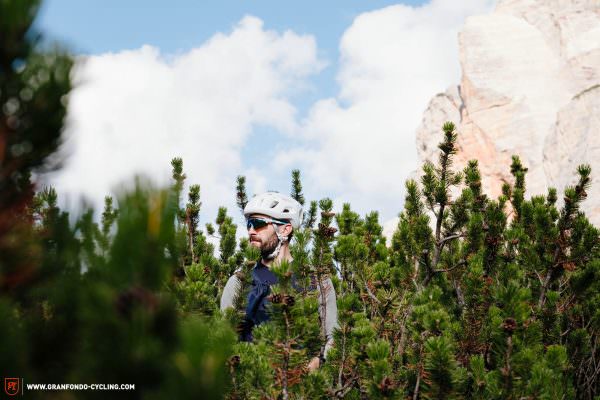
Trek Supercaliber 9.8 GX in detail
While the Supercaliber is the second full suspension concept in the test field alongside the BMC URS LT, it is the only bike that can be adjusted to the rider’s individual needs and preferences in terms of damping and spring stiffness at both the front and rear. The IsoStrut shock and the pivotless rear triangle is a unique system with 6 cm of travel. With a conventional rear suspension, the shock is a separate unit that is actuated via a linkage. With the Supercaliber, the shock body is integrated into the frame, allowing considerable weight savings. The shock and FOX Performance 32 Step-Cast suspension fork with 100 mm travel can be locked out at the touch of a button via the handlebar remote. Bitter aftertaste: with 5 cables sprouting from it, the Supercaliber has by far the most cluttered cockpit in the test field.
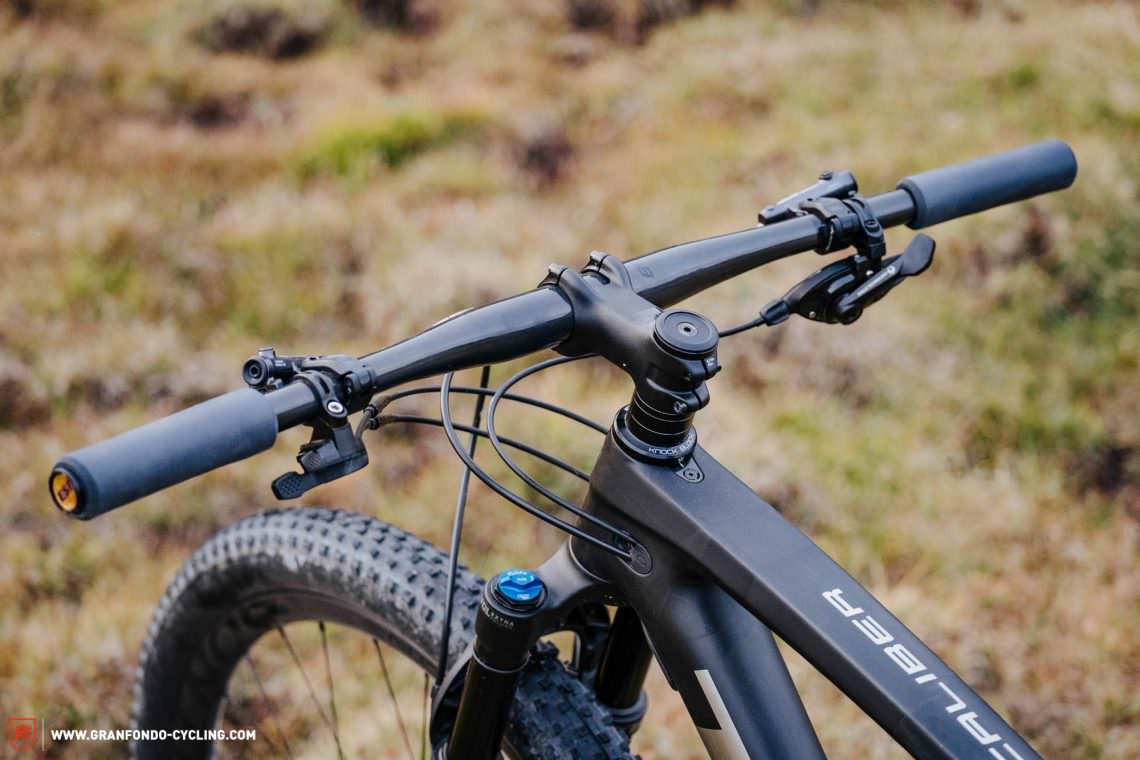
Trek Supercaliber 9.8 GX
Specifications
Fork FOX Performance 32 Step-Cast 100 mm Seatpost Bontrager Pro Brakes Shimano DEORE XT BR-M8100 180/160 mm Drivetrain SRAM GX Eagle 1x12 Stem Bontrager Kovee Pro 90 mm Handlebar Bontrager Kovee Pro 720 mm Wheelset Bontrager Kovee Pro 30 Tires Bontrager XR2 Team Issue 29" x 2.20"
Technical Data
Size S M M/L L XL XXL Weight 10.6 kg
Specific Features
IsoStrut shock with 60 mm travel integrated into the top tube space for 2 large bottles in the roomy main triangle fork and shock can be completely locked out via the bar remote Knock Block steering limiter protects the frame from damage

In terms of ergonomics and damping, the ESI Grips Silicone Grips deserve a mention, as does the pleasant level of compliance of the 720 mm Bontrager Kovee Pro handlebar. Our testers also like the Knock Block handlebar stop, as it protects the top tube from being hit by the handlebar in the event of a crash, without impinging on your riding at all. The geometry is absolutely race-oriented. The Trek has the shortest head tube in the history of mankind which allows for a very low front end, as is often preferred by XC racers. On steep uphills, it effectively helps prevent the front from lifting and generally puts a lot of pressure on the front wheel and thus increases itstraction. Our € 5,499 test bike does away with a dropper, instead speccing the 31.6 mm Bontrager Pro carbon seat post. However, Trek also offers the Supercaliber as a build with a dropper post.
If you’re not a fan of underbiking and prefer to be prepared for anything, go gravel riding with the Trek and you’ll be just as fast in the real world.
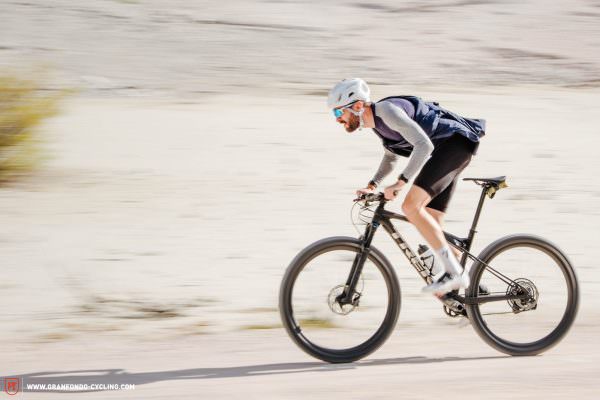
The Trek mountain bike on test: our riding impressions
When it comes to acceleration, the Trek charges ahead. Its direct and willing acceleration is, surprisingly, nippier and faster than the BMC Twostroke and sits only just behind the Canyon Grizl. When climbing, there’s no bobbing on the road or hardpack thanks to the lockout – instead, the bike marches light-footed and willingly uphill. On rough gravel, you should open the lockout when climbing. This allows the Trek to maintain maximum traction without diving away beneath you. The handling is also intuitive, predictable and stable on the uphills and at a slower pace. This makes it easy to navigate tight turns at low speeds. Like its electronic and wireless AXS counterparts on the BMC bikes, the SRAM GX Eagle mechanical groupset has a huge 520% range. However, in direct comparison to the electronic options, it needs higher operating forces and a bit more time for shifting. Compared to the other mechanical groupset, like Shimano GRX RX800 fitted to the Fustle Causeway TRAIL Lite and Canyon, it is, however, significantly crisper. Thanks to the generous gear range and its good traction, the Trek becomes an absolute off-road speed all-rounder. Alongside the suspension and frame compliance, the 29 x 2.20″ Bontrager XR2 Team Issue tires mounted on the in-house Bontrager Kovee Pro 30 wheels also have their share in this. Compared to the Vittoria tires on the Twostroke, they offer more immediate propulsion and less rolling resistance on hard surfaces. Compared to a gravel bike, the Trek rolls on a very competitive wheel and tire system and is even faster than the Fustle. So, all in all, a combination that absolutely works!
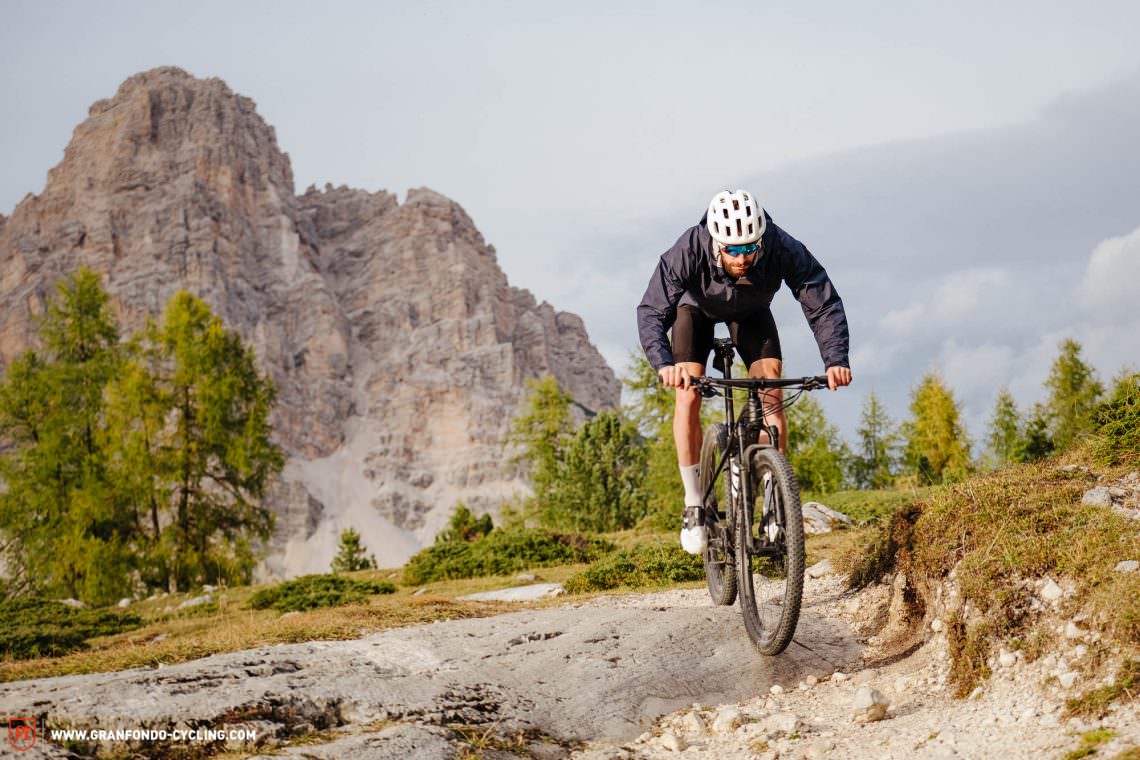
On the trail, the Supercaliber plays to its strengths compared to the test field and delivers a lot of safety and traction. The lack of a dropper post is less annoying on the Trek than on the BMC Twostroke. The reason for this is the slacker seat tube angle, which puts the saddle a little further back and leaves it less in the way. On very steep downhill sections, a dropper post would still be an advantage, though you’ll have to take the weight penalty into account. When exploring roots and gravel, the Trek shines with a very high level of comfort, even on rough surfaces. At the same time, it proves to be very efficient, as obstacles are easily rolled over and swallowed up by the suspension. On gravel highways, the bike feels almost bored. Here it’s a case of putting your head down, pushing on the pedals and pressing fast forward. Fortunately, this isn’t a problem at all, as you can push the Trek over the flats at 35 km/h for a while – assuming some requisite fitness. However, after some time, the lack of options to change position on the bars and your upper body acting as a brake in the wind becomes annoying.

Tuning tip: dropper post for more trail performance (of course, bar ends for more grip positions are barred by the style police).
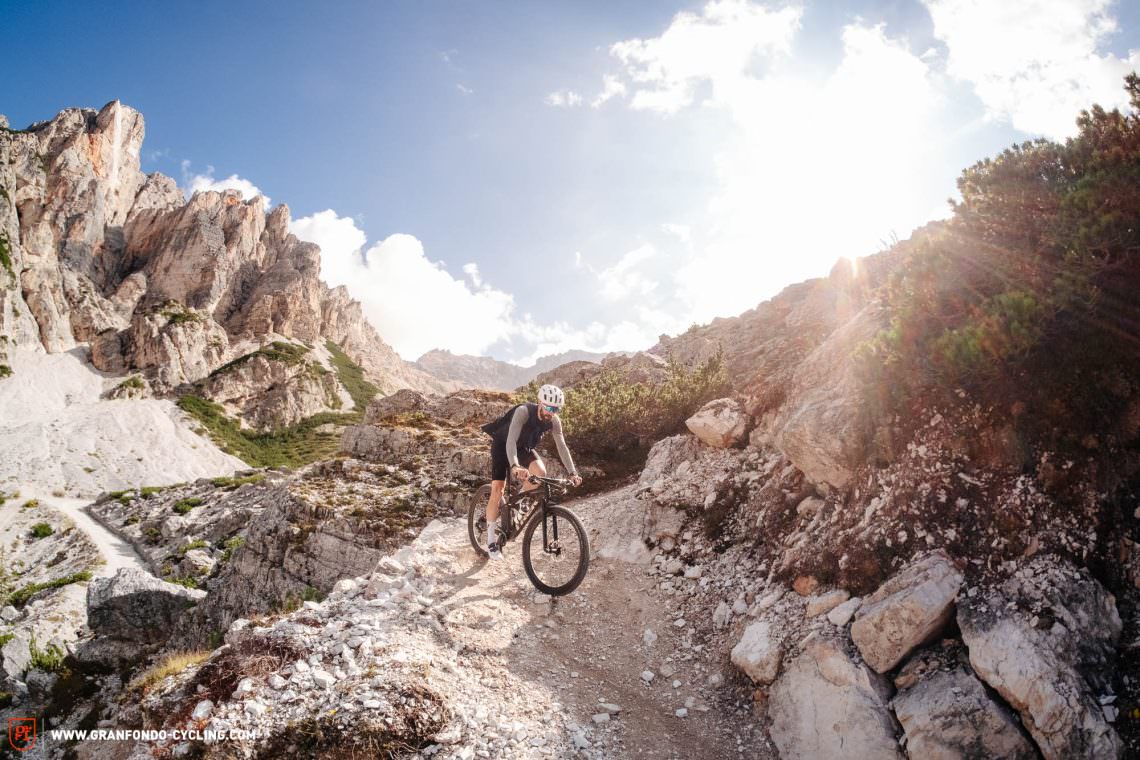
The perfect application for the Supercaliber 9.8 GX
With a surprisingly wide range of applications, the Trek more than surprised our testers. Its range of use is as wide as with the Lauf, but is oriented quite a bit further towards off-road riding. While it loses some trail performance with its missing dropper post, it still scores with maximum traction, riding fun and the best trail performance in the test field for all skill levels. However, for touring or bikepacking, you have to come to terms with the limited bar positions. If you mainly want to get from A to B quickly off-road, there is no better concept in this group test.
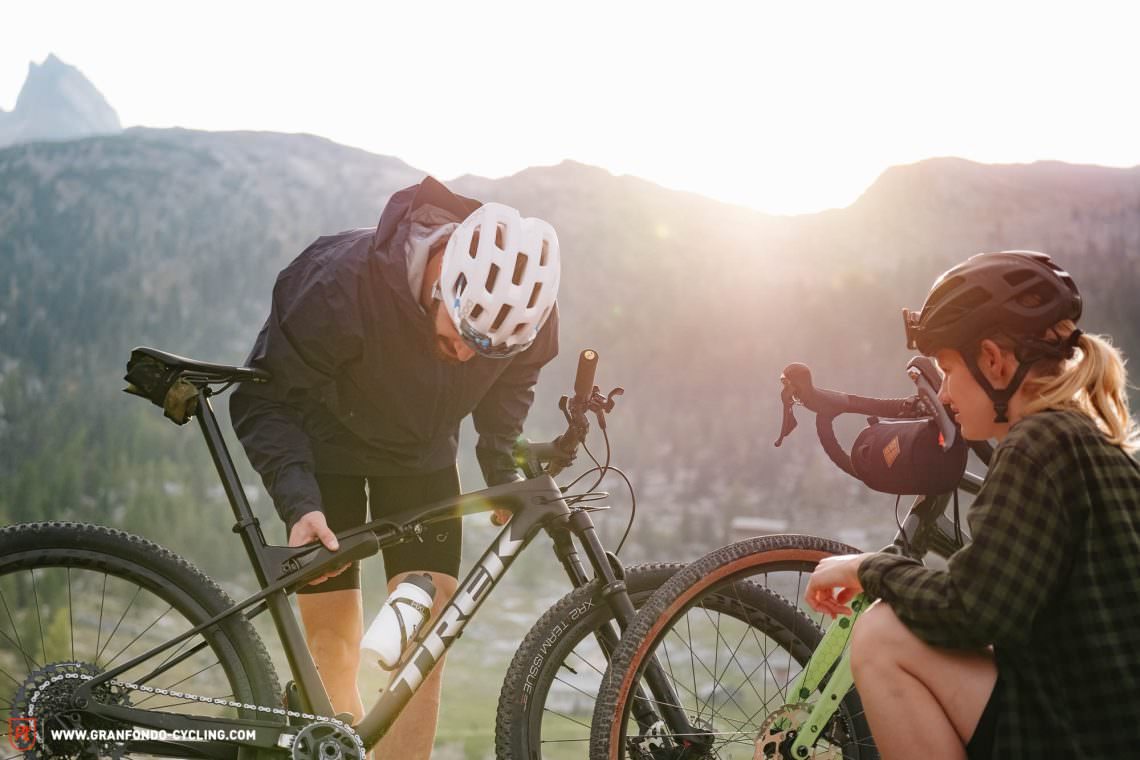
Size: S M M/L L XL XXL Weight: 10.6 kg Price: € 5,499
Indended Use
Trek supercaliber 9.8 gx conclusion.
The Trek Supercaliber is the definition of an off-road speed all-rounder and readily generates speed everywhere thanks to its enormous traction and low weight. Those who mostly avoid the road and can cope with the mountain bike position will find the better concept here compared to a gravel bike. However, in terms of versatility, the Trek ultimately has to admit defeat to the Lauf concept by a narrow margin. A very strong 2nd place!
- innovative full suspension system
- extremely wide range of applications
- conveys a lot of confidence and safety in many situations
- off-road speed all-rounder
- cable chaos on the cockpit
- missing dropper post limits the range of use unnecessarily

You can find out more about at trekbikes.com
The test field
All bikes in test: BMC Twostroke 01 ONE (Click for review) | BMC URS LT ONE (Click for review) | Canyon Grizl CF SL 8 1by (Click for review) | Fustle Causeway TRAIL Lite (Click for review) | Lauf True Grit SRAM XPLR Edition (Click for review) | Trek Supercaliber 9.8 GX
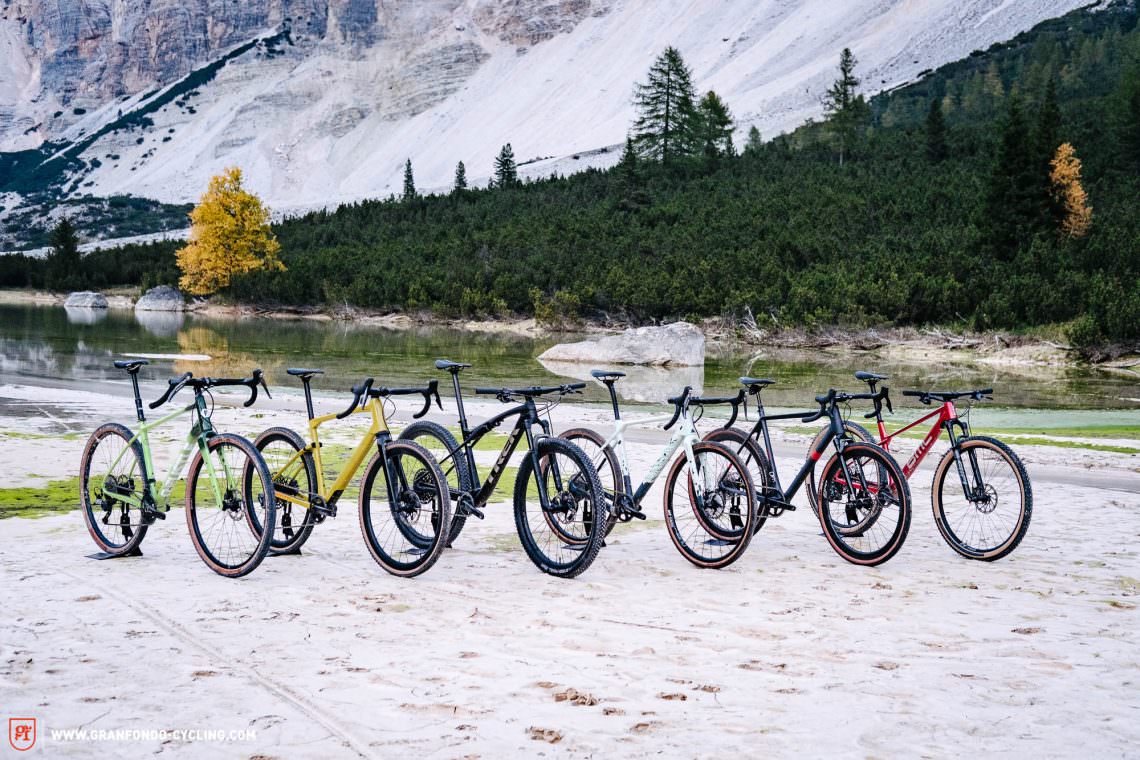
No, it’s not about perfect race tracks, it’s about efficiency. Fast, fleet-footed and efficient – those who want to speed along high-speed passages need a defined and spritely bike that accelerates with ease and efficiency. Nevertheless, reliable components are important too. We interpret “Smooth tarmac” bikes as follows: Hard efforts at high speeds with a maximum efficient bike on a consistently well-paved road. Effort-joy ratio: 80:30 (not everything has to be 100%!) ↩
… also known as bike riding. Broken-up roads in the hinterland, deadlocked gravel roads, loose surfaces – sometimes muddy, sometimes bone-dry. For this, it takes bikes with super all-round, handling and wearing qualities uphill and downhill. Effort-joy ratio: 50:50 ↩
Did you enjoy this article? If so, we would be stoked if you decide to support us with a monthly contribution. By becoming a supporter of GRAN FONDO, you will help secure a sustainable future for high-quality cycling journalism. Click here to learn more .
Words: Photos: Peter Walker, Benjamin Topf
You may also like
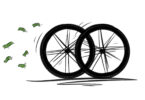
The perfect wheel and tire combo – Why it’s not just the rim depth that matters

The perfect fit? Bike fitting put to the test

FOCUS PARALANE 8.9 – Back to the roots yet up to date?

2024 GIANT Defy Advanced SL – More than just a pretty face?

Canyon Endurace CF SLX 8 AXS Aero – All in the name of speed and distance?

Specialized S-Works Roubaix SL8 – A gravel wolf in all-road clothing?

- Buyers Guide

- Technical Details

- Supercaliber
Trek Supercaliber 9.7 Review
- Innovative rear construction concept
- 25 years warranty
OVERALL BIKE CHECK
The most importanten ratings of the Supercaliber 9.7 ⬤ in comparison to the competitor bikes of following categorie: (Racefully up to 6000 €) ⬤ .
VALUE for MONEY CHECK
If you are keen on value for money, this is your chart. It shows you at a glance how many bike you get for 4799 €.
Expirience with the Trek Supercaliber 9.7

best alternatives

mostly compare
Trek supercaliber 9.7 vs trek supercaliber 9.8 gx.

Je steiler der Winkel des Sitzrohrs ist, desto effizienter können Sie in die Pedale treten.
- Frame Supercaliper
- Frame Material Carbon
- Fork RockShox Reba RL, Solo Air spring, Motion Control damper, remote lockout, tapered steerer, 42mm offset, Boost110, 15mm Maxle Stealth, 100mm travel
- Spring Unit air
- Remote-Lockout yes
- Damper Trek IsoStrut, Fox Performance shock, air spring, DPS 2-position remote damper, 235mm x 32.5mm
- Gearrange 510%
- Drivetrain 1x12
- Gear Lever Shimano SLX M7100, 12 speed
- Rear Derailleur Shimano XT M8100, long cage
- Crank Size: S, M, E*thirteen Helix, 32T alloy ring, 52mm chainline, 170mm length; Size: M/L, L, XL, E*thirteen Helix, 32T alloy ring, 52mm chainline, 175mm length
- Cassette Shimano SLX M7100, 10-51, 12 speed
- Chain Shimano SLX M7100, 12 speed
- Brake Set Shimano hydraulic disc, MT501 lever, MT500 caliper
- Brake Rotors 180/160
- Wheel Set Bontrager Kovee Elite 30, OCLV Mountain Carbon, Tubeless Ready, 6-bolt, Boost 110, 15mm thru axle
- Front Hub Bontrager alloy, sealed bearing, alloy axle, 6-bolt, Boost110, 15mm thru axle
- Tires Front Bontrager XR2 Team Issue, Tubeless Ready, Inner Strength sidewall, aramid bead, 120 tpi, 29x2.20''
- Tires Rear Bontrager XR2 Team Issue, Tubeless Ready, Inner Strength sidewall, aramid bead, 120 tpi, 29x2.20''
- Saddle Bontrager P3 Verse Elite, stainless steel rails, 145mm width
- Seat Post Size: S, Bontrager Comp, 6061 alloy, 31.6mm, 8mm offset, 330mm length; Size: M, M/L, L, XL, Bontrager Comp, 6061 alloy, 31.6mm, 8mm offset, 400mm length
- Stem Size: S, Bontrager Elite, 35mm clamp, 13 degree, 60mm length; Size: M, M/L, Bontrager Elite, 35mm clamp, 13 degree, 70mm length; Size: L, XL, Bontrager Elite, 35mm clamp, 13 degree, 80mm length
- Handle Bar Size: S, M, M/L, Bontrager Kovee Elite, alloy, 35mm, 5mm rise, 720mm width; Size: L, XL, Bontrager Line, alloy, 35mm, 15mm rise, 750mm width
- Handle Bar Width 750
- Head Set Knock Block Integrated, 62-degree radius, cartridge bearing, 1-1/8'' top, 1.5'' bottom

Which bike suits me and my needs?
Which bike suits me and my needs? Spoiled for choice: Should it be a trail bike, an end...

Fox is working on a new 34er fork

The Mondraker F-Podium Carbon DC in review

Is the new Specialized Epic 2023 still a full suspension bike?
Ride better bikes newsletter, privacy preferences.
Product license not for production use! ( Learn more )
We use cookies and similar technologies on our website and process your personal data (e.g. IP address), for example, to personalize content and ads, to integrate media from third-party providers or to analyze traffic on our website. Data processing may also happen as a result of cookies being set. We share this data with third parties that we name in the privacy settings. The data processing may take place with your consent or on the basis of a legitimate interest, which you can object to in the privacy settings. You have the right not to consent and to change or revoke your consent at a later time. For more information on the use of your data, please visit our privacy policy.
You are under 16 years old? Then you cannot consent to optional services. Ask your parents or legal guardians to agree to these services with you.
- Email: [email protected]
- Contact form: https://bike-test.com/en/
- Privacy Policy: https://bike-test.com/en/privacy-policy/
- Legal notice: https://bike-test.com/en/imprint/
- Type: HTTP Cookie
- Host: .bike-test.com
- Duration: 365 days
- Host: bike-test.com
- Contact form: https://bike-test.com/
- Privacy Policy: https://bike-test.com/datenschutzerklaerung-dsgvo/
- Legal notice: https://bike-test.com/impressum/
- Duration: 1 day
- Type: IndexedDB
- Duration: No expiration
- Duration: Session
- Type: Local Storage
- Duration: 2 days
- Provider: Google Ireland Limited
- Privacy Policy: https://policies.google.com/privacy
- Host: .youtube.com
- Duration: 1 year
- Duration: 2 years
- Duration: 1 month
- Duration: 6 months
- Duration: 18 years
- Duration: 6 month
- Duration: 8 months
- Host: .google.com
- Duration: 1 years
- Duration: 1 months
- Host: www.google.com
- Duration: 1 Minute
- Duration: 90 days
- Duration: 1 minute
- Duration: 13 months
- Duration: 30 minutes
- Duration: 30 days
- Duration: 9 months
- Duration: 1 hour
- Host: .doubleclick.net
- Duration: 14 days
Trek Supercaliber SLR Vs Specialized Epic World Cup: Which is the ultimate cross-country speed machine?
- Guy Kesteven
- November 27, 2023
Specialized and Trek have both debuted new short travel suspension XC race rigs this year. And given that the Trek Supercaliber and Specialized Epic World Cup look extremely similar in design, we figured they would make the perfect XC head-to-head test.

Trek Vs Specialized Credit: Mick Kirkman
Trek and Specialized are giants in the mountain bike world, and both of these new XC bikes weigh in under 10kg and have five figure price tags. And that’s not all they have in common. Dynamic geometry and component choice of the Trek Supercaliber SLR 9.9 XX AXS Gen 2 and Specialized S-Works Epic World Cup are closely matched too. They feel surprisingly different on the trail though. So what are the details that affect the dynamic performance, and which one – if either – should you pick for ultimate cross-country speed? That’s the question this head-to-head test will answer.
- Read the full review of the Specialized S-Works Epic World Cup
- Read the full review of the Trek Supercaliber SLR 9.9 XX AXS Gen 2
Now, if you’ve not been following World Cup XC racing recently, you will have missed out on some excellent competition from insanely skilled and fit athletes. You also won’t know that most courses now feature sections that you’d assume were designed for 16kg, sticky tyre enduro bikes, not sub 10kg, semi-slick tyre-shod whippets. It’s why the best XC race bikes now look like lightened versions of trail bikes, with conventional linkage-driven shocks giving 100-120mm of travel. And both Trek (Top Fuel) and Specialized (Epic Evo) have bikes in that category too.
Suspension and frame layout

Trek and Specialized both used integrated shock designs to boost stiffness and give a hardtail look
That’s not what we’re looking at here, however. Both the Supercaliber SLR 9.9 XX AXS Gen 2 (£10,800) and Specialized S-Works Epic World Cup ($11,000) use a proprietary top tube embedded shock giving 80mm and 75mm of travel respectively. This gives them a traditional hardtail-style frame layout, rather than a distinctly separate front triangle and swingarm. Where the increased triangulation and more firmly anchored shocks open up potential for greater stiffness without adding extra weight. Both brands trade on that too, claiming hardtail-style power delivery, but with suspension when you need it. And it’s true, both the Trek and Specialized feel stiffer than conventional XC full-suspension bikes. But for different reasons. On the Trek Supercaliber it’s a structural thing, while the Specialized Epic WC creates the illusion of stiffness with its suspension set up.

Specialized’s Brain equipped RockShox SID fork is marginally heavier than the stock SID
Thankfully things are a lot simpler up front, where the latest RockShox SID SL Ultralight 110mm travel fork is hardwired to the same TwistLoc two position remote as the rear shock on the Trek. Specialized has transferred its long running Brain inertia valve to the latest 110mm travel SID SL fork. This reactive lockout has preset ‘Brian fade’ sensitivity, using a preloaded spring on the inertia valve. There’s no handlebar remote, but you can reach down and move the ‘fade’ lever on-the-fly with your hand if the trail is smooth enough. The latest version has had the spike valve removed for a more open feel, and even when ‘locked out’ you still get 15mm of cushion for traction. All-in, the Brian system adds 183g over the standard SID fork.

Left: Trek has a twist grip remote for the fork and Shock. Right: Specialized relies on smart suspension tech
On the scales
Claimed frame weights are different for both bikes. Specialized suggests a near 250g advantage over the Trek, but the sub 10kg build weights for each bike are very close when we checked them in the workshop. The Trek weighs 9.72kg (21.43lb), the Specialized a smidge heavier at 9.75kg (21.5lb). And that’s because the Epic WC has a heavier Brain version of RockShox’s SID SL fork and a power meter chainset too. That said, both add less to the overall weight of the Specialized than the Fox Transfer SL dropper does on the Trek. Yup that’s right, Specialized fits a rigid post. All of which suggests that the claimed weights are a little off.
Geometry side-by-side
If you take a quick glance at the geometry chart, the head angle on the Specialized is a lot slacker than the Trek. But the static geometry does not tell the whole story. The Specialized is designed to run very little shock sag, so the dynamic head angle with the rider on board is actually very close to the Trek. And it’s a similar story with the BB heights. The Trek appears to be a lot higher, but once you factor in the increased shock sag, it’s pretty close to the Specialized. On the trail then, the dynamic geometry of both bikes is much closer than it appears in the chart below (using our own measurements, not the manufacturers claimed figures).

Trek’s top end Supercaliber has Level Ultimate 4-piston brakes, a XX AXS drivetrain and a one-piece Bontrager cockpit
As the model name suggests, there’s a full SRAM XX AXS drivetrain on the Trek, complete with carbon rear derailleur cage and hollow carbon crankarms. While the new XX transmission isn’t as fast to shift as older AXS systems, you don’t have to ease up on effort while changing, so everything is literally geared towards going faster. Unlike the Specialized Epic WC, there’s no power meter chainset here though. Bontrager’s top Race Series Limited kit provides the one piece bar/stem (750/80mm equivalent) and the carbon rail saddle. The ultralight (but lifetime warrantied) carbon Kovee wheels have a 108 point engagement rear hub, which joins in the fast and furious fun with near immediate reaction to pedal inputs.

Specialized’s Epic WC gets less powerful 2-piston brakes
It’s a similar blend of parts on the Specialized. The t ransmission is SRAM’s top line XX SL AXS wireless kit including a full Quarq power meter on the narrow stance 168mm Q-Factor chainset. Specialized’s partner-brand Roval provides the Control SL Integrated cockpit, which mimics a 760mm bar in a 70mm stem, and the superlight Control SL wheels. Our only gripe with the build is that the two-piston SRAM Level Ultimate brakes are both less powerful and 10g heavier than the four-piston versions. Lever feel is great though, and you get a 180mm front rotor for power compensation.
Performance

We struggled to get to grips with the suspension on the Specialized Epic WC
We literally spent months setting and re-setting sag levels, tweaking the compression and rebound damping on the Specialized Epic World Cup, and riding it in as many different situations as possible. In the process we figured out that there are some things the Epic WC does very well. The ‘take no prisoners’ vibe is a psychological gift for flat-out attacks. The split personality suspension works very well in firmer modes when powering from smooth surfaces to stutter bumps (or vice versa). Fixed seat post aside, the spec is pretty much perfect premium race gear, and its clean looks were universally praised.

For an XC bike, the Specialized Epic WC isn’t as firm under foot as we expected
Now for the negatives. The topped out, sat ‘on’ not ‘connected to’ the trail suspension response undermines control and traction significantly on descents, and you get tired really quickly on technical trails. The (relatively) soggy pedalling action also saps energy and morale, and being unable to change that feeling when riding inevitably means compromise, rather than customised, performance for each section of track too.

Once the shock bushing loosened up, the Trek Supercaliber took off like a rocket
Contrast that with the Trek Supercaliber. Sure it took a couple of rides for the ZEB bushing on the IsoStrut shock to free up, and the skinny Bontrager tyres needed switching out too, but the Supercaliber just felt ‘right’ from the start, especially from a race point of view. The combination of the structural stiffness and the very positive pedalling feel from the higher-than-average anti-squat, and extra low speed compression damping, gives a noticeably different character to most conventional XC bikes. And even though the suspension response is firm, the fact it’s progressive makes it more predictable than the reversed stiff-to-soft action of the Specialized.

The Gen 2 Trek Supercaliber is born for speed
There’s none of the harsh, hammering topped-out staccato of the Epic World Cup either, and the standard SID SL fork is a lot less spikey than Specialized’s Brain equipped unit. As a result, fatigue levels were dramatically reduced, even on rougher descents when testing the bikes back-to-back. In fact, the only time the Trek felt at a disadvantage to the Epic World Cup was on smooth climbs, where the increased sag felt less efficient than the topped out Epic. That’s immediately remedied with a twist of the lockout though, and overall the Trek Supercaliber just felt a lot more sorted, connected and intuitive for racing and flat out XC/Trail riding.

And the clear winner here is the Trek Supercaliber SLR 9.9 XX AXS Gen 2
Having said that, neither bike is as fast on descents/technical sections as most longer-travel XC bikes, and therefore they aren’t as versatile either. They don’t offer any weight advantage either, and with a remote multi-mode suspension, rather than binary lockouts, most 120mm bikes are faster on a lot of climbs and more tuneable for different sections of track.
So if there’s no real weight advantage, and both bikes have less travel for bigger hits and the extra complications of proprietary shocks, why would you want to consider either of them over a conventional full-suspension race bike? The answer potentially lies in their very different ride vibes. You can read the full test of the Trek Supercaliber SLR 9.9 XX AXS Gen 2 here and the Specialized S-Works Epic World Cup here .
Also we’re already seeing both the Supercaliber and Specialized’s Epic Evo using RockShox Flight Attendant electronic suspension adjustment on the World Cup race circuit too. That makes investing £10k in a proprietary suspension system and frame potentially less appetising when Ai might be end up doing a better job on a more versatile frame in the not-too-distant future.
Test Winner’s Stablemates – alternatives for different budgets

SRAM or Shimano? You get to choose as Trek also has the Supercaliber SLR 9.9 XTR Gen 2
Trek Supercaliber SLR 9.9 XTR Gen 2 £10,350
Sit squarely in the blue Shimano camp but want all the benefits of the Gen 2 Supercaliber SLR 9.9 frame? Well Trek also has a full Shimano XTR equipped bike. It gets a Fox 34 Step-Cast fork with 110mm travel paired with the IsoStrut, RockShox SIDLuxe shock and a twin lock out remote. You also get higher volume 2.4in tyres for more traction and control. Bonus.

Trek’s Supercaliber SL 9.6 Gen 2 has all the latest XC tech, without the sky-high pricing
Trek Supercaliber SL 9.6 Gen 2 £3,780
XC race full suspension bikes are usually prohibitively expensive, not the Supercaliber SL 9.6 Gen 2. It shares the same frame layout and suspension tech as our test winner, but uses a heavier OCLV carbon lay-up and a RockShox Recon Gold RL fork to reduce costs and achieve a more competitive price point. You also get a 12-speed Shimano SLX drivetrain and a dropper post, so it’s ready to rock and roll.
How the Supercaliber Gen 2 is our most race-ready bike ever Geek out with Trek Performance Research Engineers as they explore the Supercaliber’s performance gains in an unprecedented set of industry-first tests that prove just how much better the ride can get. With extensive lab and trail testing, they deliver the science to back up big claims, showing that in its second generation, the Supercaliber is not only more comfortable and efficient than its predecessor – but even more efficient than a hardtail.
For the Supercaliber Gen 2, Trek MTB engineers took their unique IsoStrut design to the next level, giving riders significant improvements in efficiency, control and comfort. At a glance, it's easy to spot that Supercaliber's 33% increase in travel allows for greater overall axle movement. This includes both compression and extension from the sag position, allowing for more room to compress upward on impacts and more room to extend downwards into blown-out ruts and the backside of bumps. In addition, the Supercaliber Gen 2 also delivers an 18% higher leverage ratio, making the shock more responsive as it overcomes seal friction with greater ease. Finally, Trek and RockShox engineers worked closely to tune the compression damping for a race-ready balance of pedalling efficiency and terrain response, while the increased travel delivers faster rebound tuning to keep the wheel glued to the trail. For the rider, this all adds up to less effort to go fast (more efficiency), better traction (more control) and a smoother ride (more comfort). To illustrate these performance benefits, Trek Performance Research engineers conducted an unprecedented set of tests both in the lab and on the trail.
Any cross-country racer knows that pedalling efficiency over roots and rocks is paramount. Suspension plays a critical role in preserving forward momentum, keeping the tyre planted on the ground, and reducing uncomfortable and disruptive chassis motion. In short, a great suspension will simultaneously improve efficiency, control and comfort. Lab meets trail The Supercaliber’s efficiency while pedalling through rough terrain was tested on the Trek Performance Research Lab treadmill , where we can avoid line choice and handling variability while precisely controlling temperature, speed and terrain profile. To create the terrain profile, we first rode the Trek Trails with a shock sensor to measure suspension activity over a rooty section of trail. Using this data, we tuned the treadmill profile to match the trail’s suspension activity.
Efficiency Measured by metabolic mask After correlating our treadmill surface to the trail, we used a VO2 Master metabolic mask to measure overall rider and bike system efficiency for the Supercaliber Gen 2, Supercaliber Gen 1 and a hardtail. This mask measures the rider’s oxygen consumption, which is a metric for the total energy that the rider exerts. Why not rely on a power meter alone for efficiency comparisons? Power meters only account for the energy utilised to propel the bike, neglecting the rider’s effort to absorb repeated impacts and control the bike over rough terrain. Measuring oxygen consumption is therefore the definitive way to determine which bike is the fastest.
To achieve a consistent and valid oxygen consumption metric, we conducted 5-minute, 16 km/h (10 mph) trials at 60% of the rider’s functional threshold power – which equates to a significant but sustainable effort. By digging into the data with a fine-tooth comb, we ensured the stability of our primary metric (oxygen consumed) and secondary variables (like heart rate and crank power), allowing us to verify that fatigue was not setting in. For additional consistency, the shocks were set up to the same 29% sag and adjusted to factory-recommended settings from the Trek Suspension Calculator.
- Trek Suspension Calculator
Enough about protocols – show the result already
From our testing under these conditions, the Supercaliber Gen 2 measured as 6% more efficient than Supercaliber Gen 1 and 23% more efficient than a hardtail for the same pedalling task.
Comfort Measured with 3D motion capture Supercaliber Gen 2 measured in as the most efficient bike largely because its updated IsoStrut suspension provides the smoothest ride. On rough terrain, that means absorbing bumps (shock spring) and dissipating that energy (shock damping) so minimal motion is transferred to the bike touchpoints (handlebars, pedals and saddle). This bump absorption reduces the rider’s tendency to use energy from their muscles to absorb the impacts and maintain control. Of course, the smoothest bike is also the most comfortable to ride. To explore these effects, an array of twelve 3D cameras precisely tracked the motion of markers placed all over the bike and body, capturing data at a rate of 360 times per second. Each bike was recorded for 60 laps of the treadmill, and inconsistencies between laps were minimised by averaging the data down into a single average lap.
We first focused in on the bottom bracket area, where the legs have the first shot at absorbing vertical motion and preserving an efficient pedal stroke. As we see in the upper plot, the Supercaliber Gen 2 significantly reduced the vertical motion of the chassis at the bottom bracket by 15%, meaning the rider takes less of a beating through their feet and can put more energy into pedalling rather than stabilising their body. Second, we looked at the relative motion between the saddle and the rider’s pelvis (sacrum). This metric should ideally be zero, apart from the pedal stroke’s cyclical effect. More variability in this saddle-to-pelvis distance suggests the bike is propelling the rider up from the saddle or the rider is using their legs to hover and let the saddle move around. Either condition leads to less efficient pedalling. As we see in the lower plot, Supercaliber Gen 2 had 22% less relative saddle-to-pelvis motion than its predecessor.
Control Measured with a high-speed camera You can only ride as fast as you can control the bike. A primary role of suspension is to keep the tyre glued to the undulating ground, thus improving traction and control. Plus, more traction also means more efficient power transfer for propelling the bike forwards. In this video, we see a comparison between the axle motion of the Supercaliber Gen 2 (blue) and Supercaliber Gen 1 (orange). When the axle markers are overlaid, we see that Gen 2 maintained faster, more composed control over the rear wheel and regained traction more quickly after impacts.
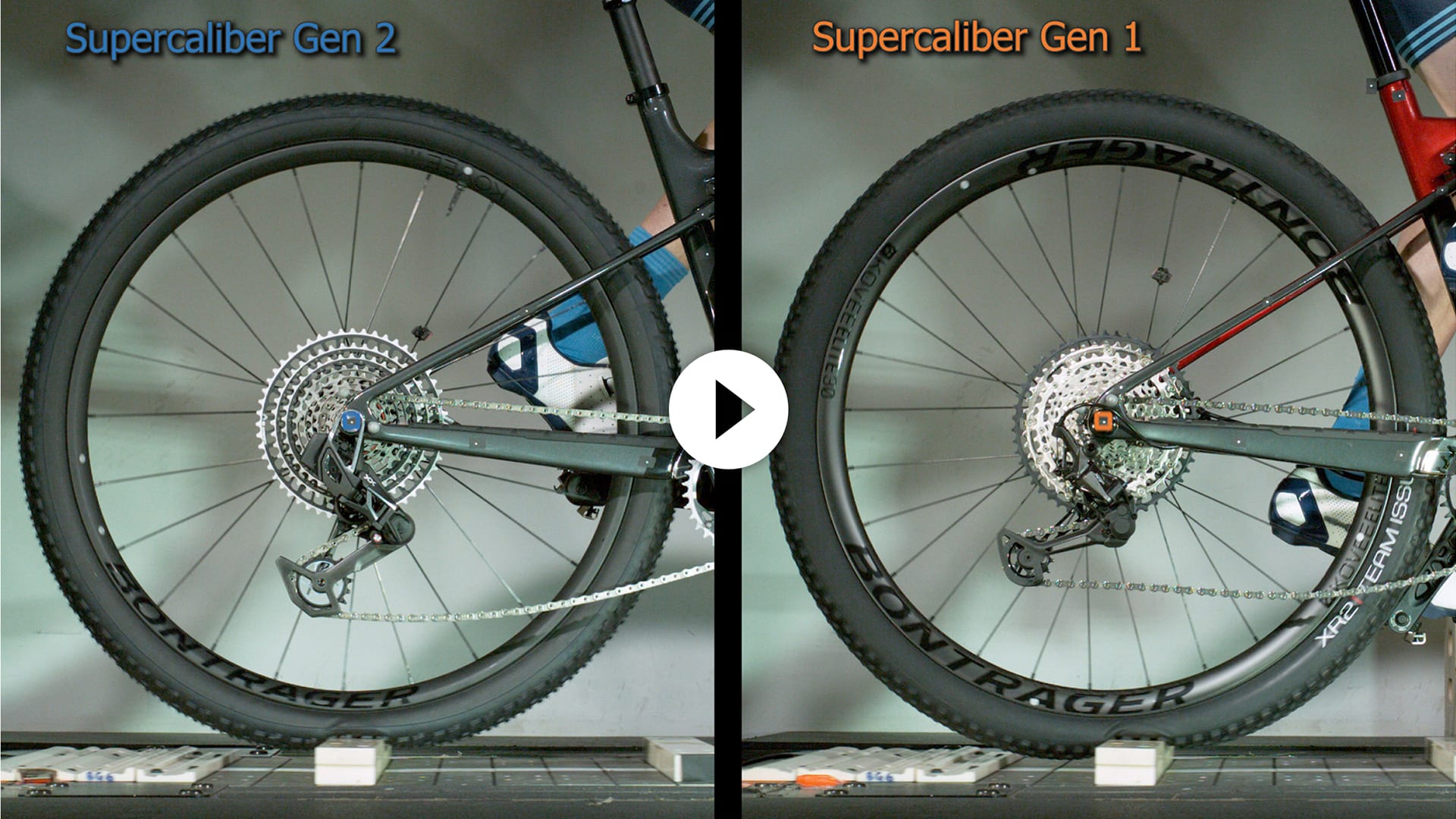
Suspension activity Measured with a shock sensor To understand how the Supercaliber Gen 2 achieved better efficiency, control and comfort, we equipped its IsoStrut with a linear potentiometer to measure shock displacement at a rate of 5,000 samples/second. After a bit of calculus, we arrived at this plot of the 'suspension usage envelope' at the rear axle, which gives us a full picture of how the shock’s spring and damper worked to allow wheel movement during these identical riding conditions. In this overlay, we see that Supercaliber Gen 2’s new IsoStrut design resulted in a significantly more active suspension in this riding scenario, allowing the rear wheel to move over a 68% further range and 71% faster. This includes more compression and extension relative to the sag position, which is key for both absorbing impacts and tracking the terrain (traction).
So far, our testing investigated performance while pedalling through rough terrain – certainly a key factor in cross-country racing. But modern cross-country courses increasingly reward bikes that also have the prowess to confidently charge through technical features and rocky descents. To investigate how Supercaliber Gen 2 would perform in this type of terrain, we ditched the lab coats, grabbed our portable pocket protectors and headed back to the woods. Heading back to the trail Out on the Trek HQ mountain bike trails, we identified a rocky descent and started by precisely mapping its topology using a high-resolution 3D laser scanner. This stretch of rocks measured about 8 m (25 ft) long, on a 15% downslope, and included multiple bumps and drops up to 180 mm (7 in) tall.
Comfort and efficiency Measured with 3D motion capture With the help of huge tripods, customised tree mounts and hundreds of feet of cable, we recreated our lab’s array of twelve 3D motion capture cameras out in the woods. This groundbreaking test technique allowed us to precisely reconstruct the bike's motion and position on the trail.
Since the trail is a less controlled environment than the lab, we made every effort to control variable factors, such as entry speed and line choice. Thanks to 3D tracking of the bike over multiple runs, we made valid comparisons by measuring these factors and grouping similar runs together. In the end, we analysed five runs on each bike with an average entry speed of 21 km/h +/- 0.7 (std) (13 mph+/-0.5 (std)). With the help of markers on both the bike and the trail itself, we calculated each bike's lateral entry position into the trail to be consistent within 0.10 m (3.9 in).
By tracking the bike’s moving parts individually, we looked for differences in the Supercaliber Gen 2 in all dimensions – lateral bucking, suspension usage, forward progression, ride smoothness, ground tracking – you name it. In the following video, we illustrate how the rear axle was tracked in relation to the laser-scanned trail surface and then show the axle paths from all runs overlaid for comparison.
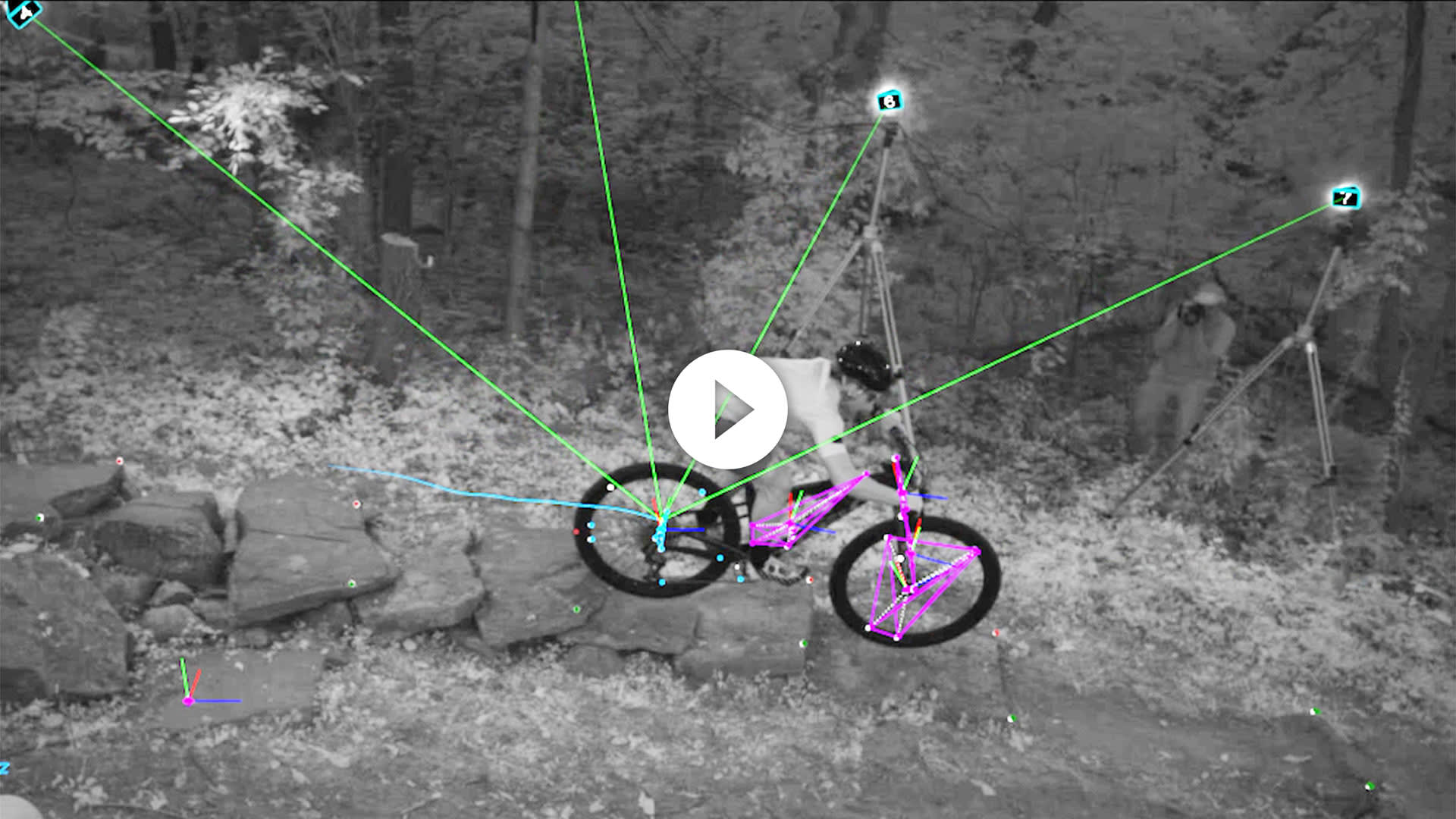
Rear axle and chassis tracking gave us the bike’s precise position and speed in space. Subtle variability in run lines and fewer repetitions compared to the treadmill made it difficult to repeat the same analysis we used on the treadmill, but other approaches to the data supported the same trends. Again, it was apparent how Supercaliber Gen 2 did a superb job smoothing the ride, leaving more energy for the rider to hammer on the pedals later down the line. The Supercaliber Gen 2 also maintained more momentum over obstacles, as was easily observed on an isolated rock towards the end of the run. If we look at the bikes travelling over this rock, Gen 2’s superior suspension helped soften the impact without losing speed. We saw minimal variation in speed over the same distance and less speed lost overall from entry to exit when compared to Supercaliber Gen 1 and the hardtail.
Control Measured with a high-speed camera Using a high-speed camera, we can precisely track axle motion and measure traction as the tyre disconnects and reconnects with the trail. A slider rail system, combined with a nimble engineer and plenty of outtakes, gave us a close-up, moving view of IsoStrut in action, while a static tripod low to the ground provided calibrated 2D motion tracking.
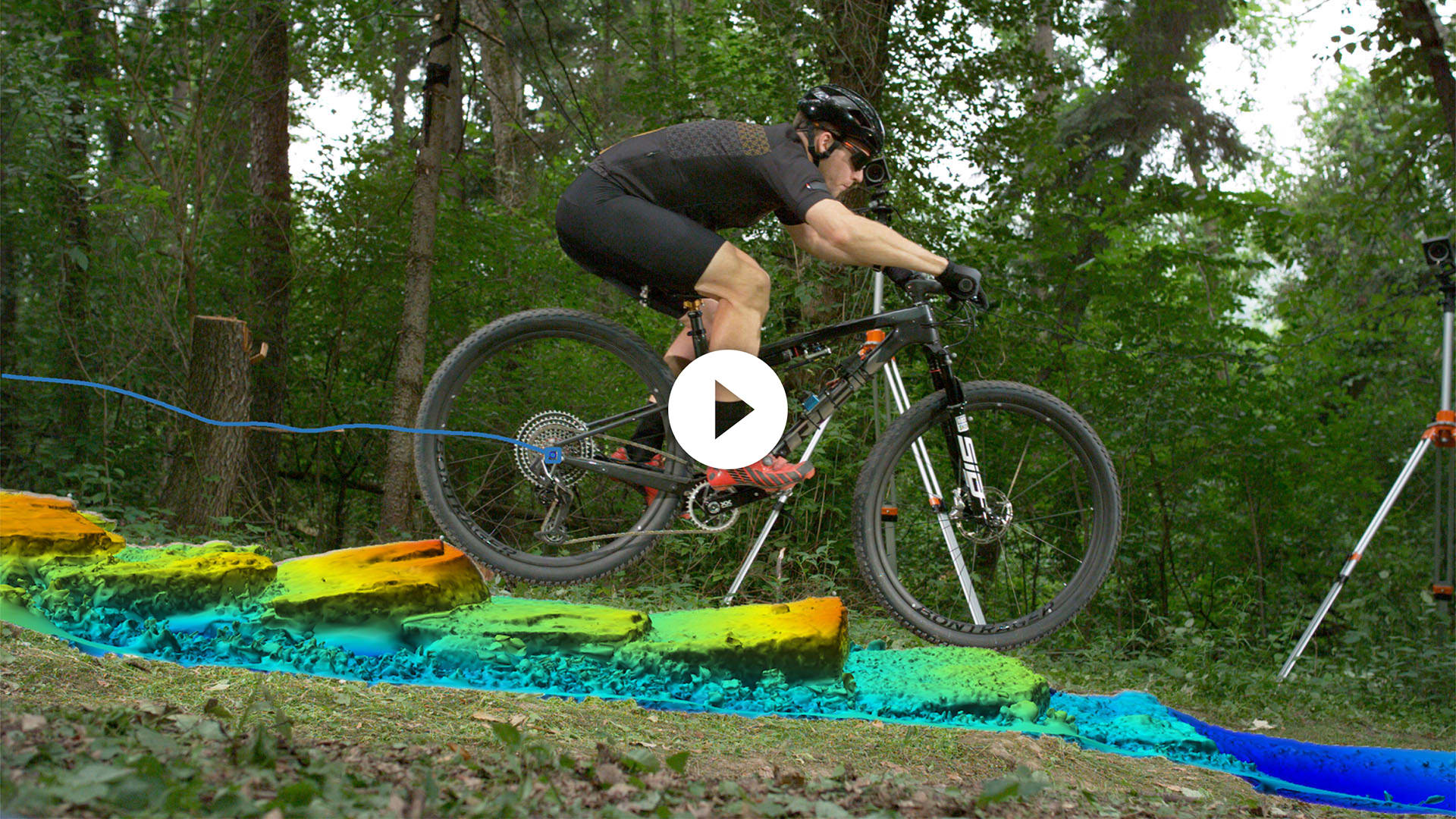
As we saw in the video, the Supercaliber Gen 2’s wheel tracked the terrain more closely and regained traction faster after large drops and impacts. In the case of the two largest drops in the video frame, the Supercaliber Gen 2 regained traction 14-50% sooner than the other test bikes. Better connection to the trail means more control for braking and steering. Suspension activity Measured with a shock sensor The source of these performance gains is the new IsoStrut suspension, which we again instrumented with a linear sensor. Just like in the lab, we measured the shock motion as suspension usage envelopes and saw that Supercaliber Gen 2 was more active while descending on the trail, displacing 40% further and 31% faster than Gen 1. Importantly, there was a greater range of motion both above and below the dynamic sag point, indicating a significant increase in both impact capability and ground-following traction, respectively. In fact, the Supercaliber Gen 2 compressed beyond Gen 1's max travel (bottom-out) point and still had room to spare for even bigger impacts and landings.
About the authors Paul Harder is a Principal R&D Engineer at Trek Bicycle. Since earning an MS in Mechanical Engineering from the University of Wisconsin – Madison in 2007, he has dedicated his career to making your ride better through science and innovation. Wendy Ochs, PhD is a Biomechanics Research Engineer at Trek Bicycle. She holds a doctorate in Biomedical Engineering from the University of Wisconsin – Madison. Kyle Russ, Lead Biomechanical Engineer, has been studying the rider-bicycle interaction for Trek Bicycle since 2011. His passion for understanding human movement and physiology of cyclists started while pursuing his master’s from Ohio State University.
Palo Alto, California
Stanford Shopping Center
On Friday through Sunday, April 22-24 at the Stanford Shopping Center in Palo Alto you can experience a whole new type of bicycle riding at the Electric Bike Expo event!
Imagine taking the hills out of your ride and adding fun to your excursions, whether commuting to work or school, or making quick runs to the store!
Test Ride More Than 100 Different Models
Come test ride more than 100 different models of the latest electric assist bikes from brands such as A2B, BESV, BULLS, Easy Motion, Felt Electric, Focus, Gazelle, Haibike, IZIP, Kalkhoff, Raleigh, Stromer, Tempo, Trek, Vintage, Xtracycle, Yuba with the latest electric drive systems from Bosch, Yamaha, Shimano, and more!
There will be a wide range of bicycles ranging from beach cruisers to street commuters, to mountain bikes and cargo bikes to try. Many of the models are brand new to the US and here to be tested by you for the very first time!
Meet Manufacturers and Dealers
Meet all the manufacturers and learn everything you need to know about this new, low-cost, and fun transportation alternative. Best of all, it's FREE!
Tempo Bicycles will be raffling off one of their Carmel or Santa Barbara hybrid electric bicycles worth $4,000 to a lucky winner and the raffle proceeds will go to the following local charities: Quakes Community Fund, Branham Hills, Silicon Valley Humane Society, and the California Bicycle Coalition. The raffle tickets will be $5 each and there will be multiple charities to buy the raffle tickets from to increase your chances to win a Tempo hybrid electric bicycle!
Easy Motion will be giving away a 350W EVO Jet electric bike worth $2,800 to one lucky person who test rides any of their bikes!
Stromer will be giving away one of their ST1 LTD electric bikes worth $5,000 to one lucky person who test rides any of their bikes! Plus Stromer will be launching their new ST2s in the U.S. at this Expo. The ST2s has nearly a 1,000 Wh battery pack with a claimed range of more than 100 miles, plus it has electronic shifting!
Raleigh and IZIP are offering significant discounts, ~15% off retail, AND a $100 gift card rebate direct from IZIP or Raleigh.
Yuba will be offering a 10% coupon for their Spicy Curry e-cargo bike redeemable at one of their local dealers.
BESV will be offering a 10% coupon on all of their award winning e-bikes redeemable at their local dealers.
Focus will be offering $200 discount coupons for attendees that ride their e-bikes at Expo events.
Kalkhoff will be offering $200 discount coupons for attendees that ride their e-bikes at Expo events.
Gazelle will be offering $200 discount coupons for attendees that ride their e-bikes at Expo events.
Felt Electric will be offering $100 discount coupons for attendees that ride their e-bikes at Expo events.
Local Bay Area dealers that will be at the Expo are: Motostrano, Winchester Electric Bikes, ELV Motors, and more.
E-Bike Adventures
In addition to checking out and riding the latest electric bikes, you can also meet 2 electric bike celebrities!
Susanne Bruesch from Pedelec Adventures is riding 2,200 miles from California to Colorado on her Haibike e-bike! Her tour is called Sand to Snow and she will be riding through a lot of western highlights like Yosemite, Death Valley, the Colorado Plateau in Arizona and Utah, the Rocky Mountains and then finishing at the Denver Electric Bike Expo.
Mike Minnick and his dog Bixby will be at the Palo Alto Expo as they are also kicking off a major electric bike tour. Mike and Bixby will be touring on a Yuba electric cargo bike to encourage pet adoption and beat the current world record for longest electric bike ride with more than 10,000 miles of riding!
Some Details
Helmets will be supplied to you at the entrance to the Expo.
Restrooms will be available.
Parking is free. Bicycles can be locked to the track railing near the registration desk.
Plan to stop by the Stanford Shopping Center in Palo Alto!
Friday April 22
Expo opens: 3:00 PM How California is Leading the U.S. in Promoting eBikes: 4:00-4:30 PM Expo Closes: 7:00 PM
Saturday April 23
Expo opens: 9:00 AM Pedelec Adventures: Adventures on Electric Bikes: 12:00-12:30PM Electric Mountain Bike and Trail Behavior: 1:00 - 1:30PM How California is Leading the U.S. in Promoting eBikes: 2:00-2:30PM Expo Closes: 7:00 PM
Sunday April 24
Expo opens: 9:00 AM Pedelec Adventures: Adventures on Electric Bikes: 12:00-12:30PM Electric Mountain Bike and Trail Behavior: 1:00 - 1:30PM Expo Closes: 4:00 PM
Shop in-store for even more deals!
Shop in store for even more deals we can't advertise!
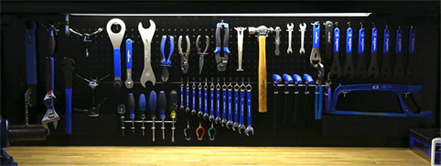
Mountain Bike Suspension Service
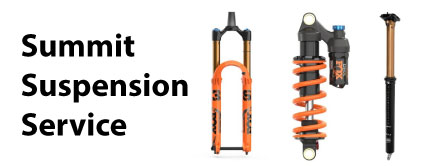
Trade In Your Bike

- Base Layers
- Mountain Bike Shorts
- Bibs, Tights + Knickers
- Mountain Bike Shoes
SAFETY GEAR
- Adult Helmets
- Youth Helmets
- Road Helmets
- Casual Wear
- Road Bike Shorts
- Bibs, Tights & Knickers
- Road Bike Shoes
- Accessories/Parts
Safety Gear
- Women's Helmets
- Road Bike Helmets
- Mountain Bike Helmets
WHEELS & TIRES
- Road Wheels
- Mountain Bike Wheels
- Mountain Bike Tires
- Wheels Accessories and Parts
- Derailleurs
- Chains & Cassettes
- Cranks and Chainrings
- Bottom Brackets
- Cables and Housing
- Power Meters
BRAKES & PEDALS
- Clipless Pedals
- Flat Pedals
- Mountain Bike Brake Sets
- Mountain Bike Brake Pads
- Road Bike Brakes and Pads
- All Brakes/Levers/Pads
Forks & Cockpit
- Grips and Bar Tape
- Rigid Forks
- Suspension Forks
Accessories
- Car Rack Accessories
- Electronics
- Front Lights
- Tail Lights
- Locks/Security
- Media/Resources
- Bicycle Mounted Racks
- Pumps/Inflation
- Tools/Maintenance
- Trailers/Strollers
- Trainers/Rollers
- Travel/Storage
- Water Bottles & Cages
Brand Guides
Bike buyer's guides, gear guides, new bike releases, summit bicycles online (855) 245-3663 [email protected] email, burlingame (650) 343-8483 [email protected] email, summit outfitters (408) 878-3252 [email protected] email, los gatos (408) 399-9142 [email protected] email, san jose (408) 264-2453 [email protected] email, palo alto (650) 304-0035 [email protected] email, summit bicycles mobile we'll come to you schedule mobile service today, (855) bike-one - for online orders and rental inquiries.
- Account Account
- Subtotal : $ 0.00 Checkout Cart
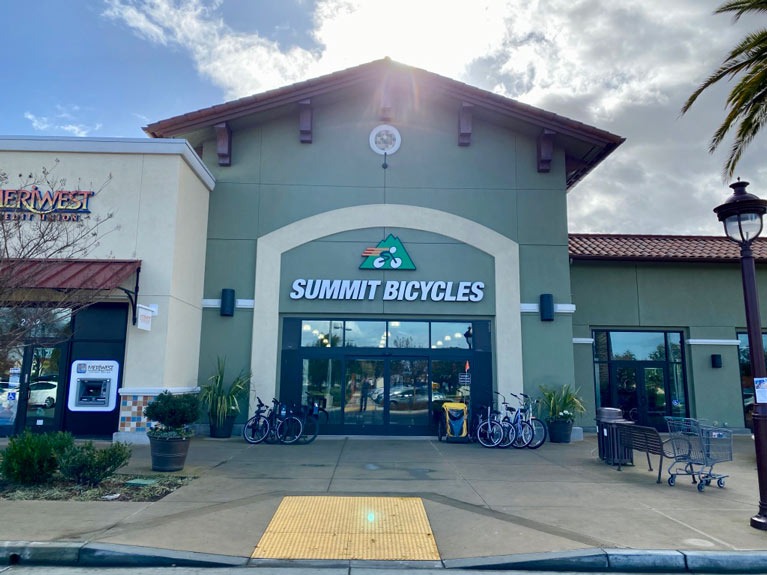
Summit Bicycles Santa Clara
Summit Bicycles is proud to offer you great service in Santa Clara, CA. You can find us at the Santa Clara Town Shopping Center in between Sprouts Farmers Marker and Meriwest Credit Union.
We specialize in helping people pick the perfect electric and hybrid bikes, and we are ready to help you with bike rentals and repairs.
Where to ride near Santa Clara
If you're looking for good trails or roads to ride near Santa Clara, check out our page on Bay Area Bike Trails & Routes.
Rental Bikes
Popular categories in santa clara.
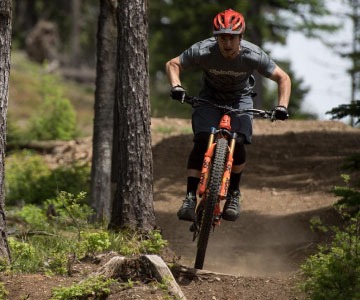
Mountain Bikes
Trail-tested and ready to rip.
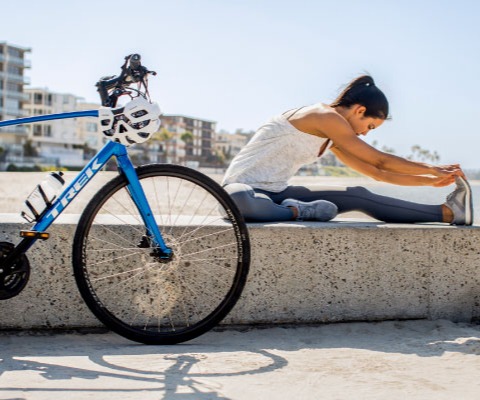
Hybrid Bikes
Comfortable and reliable for everyday rides.
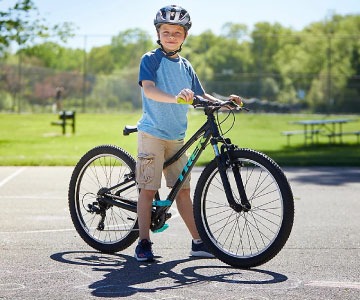
Kid's Bikes
More fun for the whole family.
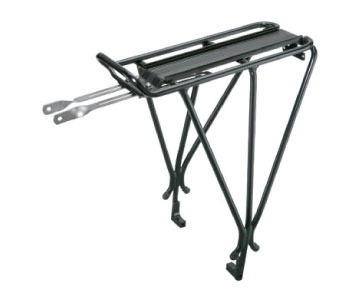
Add some versatility to your ride.
Our Specializations
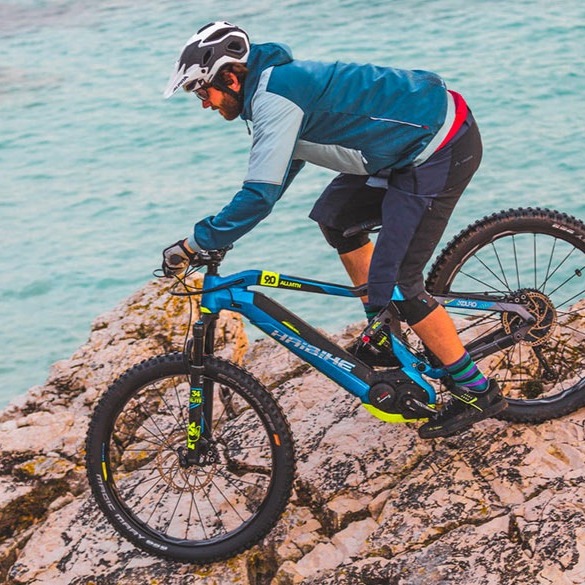
Electric Bikes
Explore our incredibly fun electric bike models. Add some boost to your trail crushing, road riding, or city commute.
Shop Electric Bikes
Electric Bikes Guide
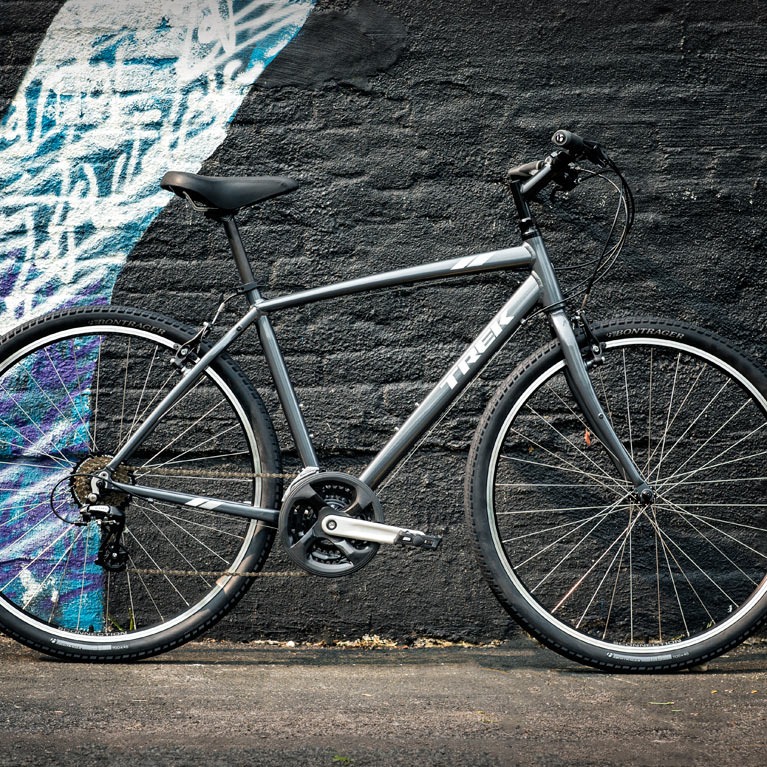
Browse our huge selection of comfortable, versatile hybrid bikes that are perfect for workouts, commuting, and exploring.
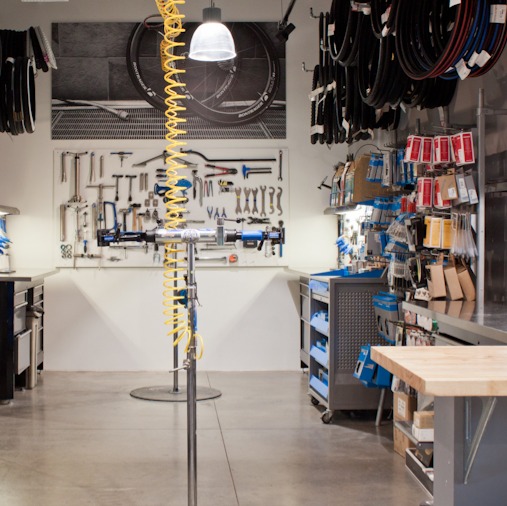
Bike Repairs
Let our expert technicians get your bike rolling smoothly again.
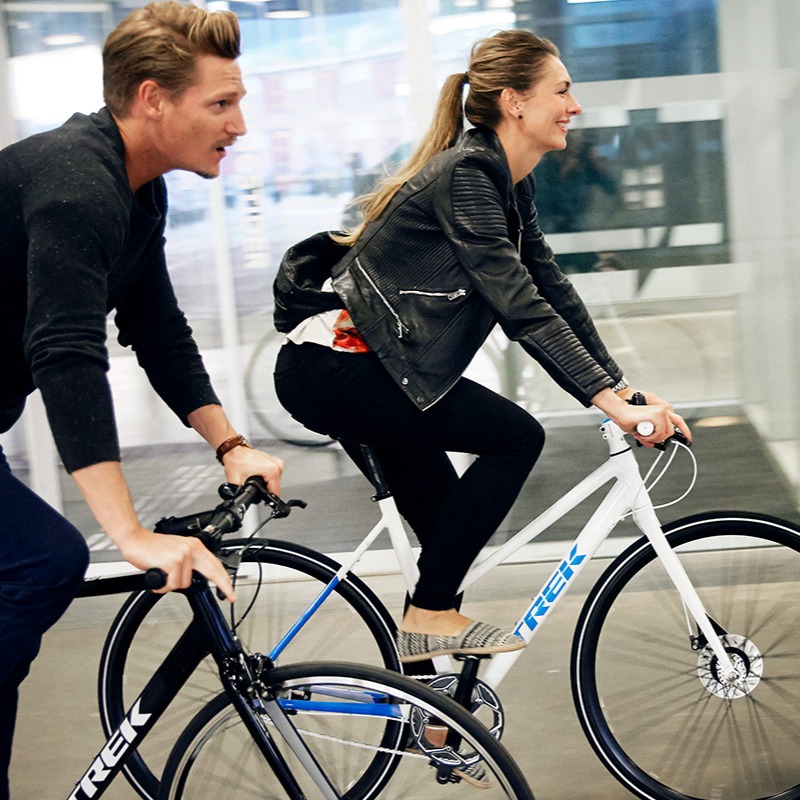
Bike Rentals
If you want to explore the area or test a new model, renting a bike is the way to go.
Our Top Brands

Our Best Selling Products
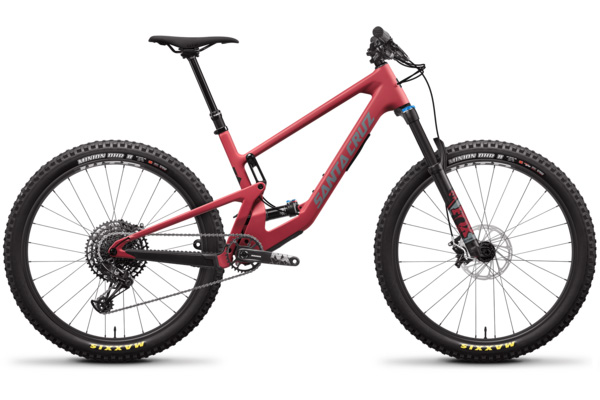
Santa Cruz 5010 C S
The Santa Cruise 5010 is about fun first and foremost. Danny MacAskill’s bike of choice, this bike will turn nature into your playground with its flexibility and power.
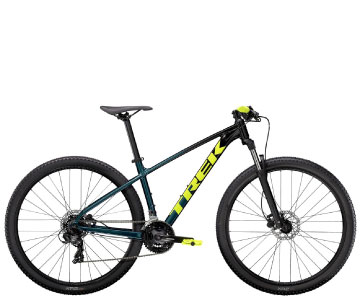
Trek Marlin 5
Want something that's trail-ready and hard as nails at the same time? The Trek Marlin is what you're looking for. Get yours today, and enjoy serious on and off-road capability.
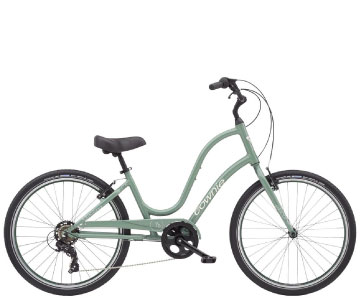
Electra Townie 7D Step-Thru
Once you ride a townie, everything else is just a bike: pick up the Electra Townie Original 7D Step-Thru today and experience the smoothest and easiest ride of your life!
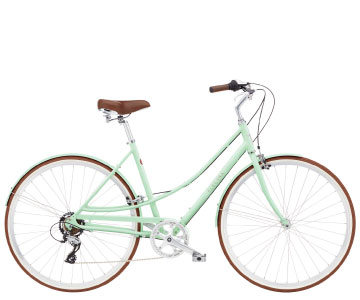
Electra Loft 7D Step-Thru
Once you ride a townie, everything else is just a bike. Pick up the Electra Loft 7D Step-Thru today and experience the smoothest and easiest ride of your life!

IMAGES
VIDEO
COMMENTS
Mr Sparkle! Trek offers the Supercaliber in five complete bike options for 2021, all of which are built around exactly the same OCLV carbon frame. Complete bike prices start at $8,699 AUD for the Supercaliber 9.8 GX. Alternatively, you can get a frameset on its own for a weirdly specific price of $4,676.04 AUD.
Our test bike is a World Cup XC-ready machine with a retail price of $11,699. Claimed weight for a size medium complete is 20.84 pounds. The base model Supercaliber Gen 2 starts at $4,199 and is a gallon of water heavier than our baller test bike. Trek offers 5 other XC weapons in the Supercaliber lineup, so let's get into what makes this Gen 2 ...
RIDE IMPRESSIONS. Trek will offer seven models of the Supercaliber starting at $4,200 and topping out at $11,700 for their highest-end build and our test model - the 9.9 SLR XX AXS. The size large hit our scales at 21.8 pounds. We passed the bike around to a few test riders each getting a couple of days on the new bike.
Our test bike is the Trek Supercaliber SLR 9.8 GX AXS, which we expect to be one of the most popular models. 2024 Trek Supercaliber SLR 9.8 GX AXS. Frame ... potentially leading to a smoother ride quality. The Trek Supercaliber SLR 9.8 GX AXS doesn't have the most drool-worthy spec for a $12K bike.
The Trek Supercaliber Gen 2 geometry has been updated with a slightly longer reach and slacker headtube angle. The Gen 1 had a 69-degree headtube with a 100mm travel fork. All of the stock Gen 2 ...
The Trek Supercaliber is an XC race bike designed to bridge the gap between hardtails and full-suspension MTBs. ... If you fall between two frame sizes, visit a Trek dealer near you to test-ride the two models that might work. Alternatively, you can compare the Trek Supercaliber size chart and geometry to an XC bike you've ridden before.
Trek was careful not to go overboard with the changes, citing that the Supercaliber is still a purpose-built cross country bike. It feels wild to think of a 67.5-degree head tube angle as somewhat ...
This is the bike that Jolanda Neff rode to victory at the Tokyo test event last year. The Supercaliber 9.9 XX1 we tested is available in five sizes, from 15.5" through to 21.5", although there is ...
The Trek Supercaliber is slacker in the head angle but that inverted stem on the cockpit shows it's still a pure racer (Image credit: GuyKesTV) Design and geometry. I've already covered a lot of the construction changes and development story of the new G2 in Trek Supercaliber news article, but here's a quick recap.The OCLV carbon frame looks the same but all the tube shapes have been ...
From our testing under these conditions, Supercaliber Gen 2 measured 6% more efficient than Supercaliber Gen 1 and 23% more efficient than a hardtail for the same pedaling task. Supercaliber Gen 2 measured in as the most efficient bike largely because its updated IsoStrut suspension provides the smoothest ride.
The 9.7 is almost exactly half the price at $4,800, and you still get Trek's OCLV carbon frame and carbon wheels, though not the modern, wide Kovee XXX wheels used on the 9.9. Frame-only will run you $3,700. The clever design of Trek's World Cup race weapon, the Supercaliber, wades into the extra-short-travel niche, gaining speed and losing ...
The $9,500 Supercaliber 9.9, our test bike, upgrades you to a Fox Factory 32 Step-Cast Fork and a Fox Factory shock, SRAM Level Ultimate hydraulic discs on 160mm rotors, and Bontrager Kovee XXX 30 ...
Supercaliber Gen 2. Races can be won or lost in the rough stuff. Supercaliber Gen 2 brings more capability for technical terrain while keeping things lightning fast. • 80/110mm rear/front travel. • 67.5° headtube angle. • 465mm reach (size large) • Two levels of OCLV Carbon, SL or SLR. Shop Supercaliber Gen 2.
The 2023 Trek Supercaliber 9.6 is the perfect bike for the trail-seeking cyclist looking to dominate everyday routes. This full suspension ride offers an all mountain experience with the power to conquer climbs and tackle descents. It features a lightweight OCLV Mountain Carbon frame, Shimano 1×12 drivetrain, and Fox Rear shock.
A pure cross-country race bike designed with Olympic cross-country in mind, the Trek Supercaliber has just 60mm of rear travel. After several weeks in the sa...
Trek Supercaliber 9.8 GX in detail. While the Supercaliber is the second full suspension concept in the test field alongside the BMC URS LT, it is the only bike that can be adjusted to the rider's individual needs and preferences in terms of damping and spring stiffness at both the front and rear.
Expirience with the Trek Supercaliber 9.7. Half fully. Half Hardtail. With its special concept, the Supercaliber 9.7 floats between two worlds. Jolanda Neff's Olympic victory, which she clinched on a Supercaliber, shows that the minimalist approach works pretty damn well. The trend towards more high speed stability geometries stops with Trek.
Trek Supercaliber SL 9.6 Gen 2 £3,780 XC race full suspension bikes are usually prohibitively expensive, not the Supercaliber SL 9.6 Gen 2. It shares the same frame layout and suspension tech as our test winner, but uses a heavier OCLV carbon lay-up and a RockShox Recon Gold RL fork to reduce costs and achieve a more competitive price point.
Locations. These locations are independent owners who volunteer to offer test rides, service, and advice to current or prospective Ride1Up buyers. However, any local bike shop has the skillset and tools needed to work on Ride1UP electric bikes. Quality, conditions, and experience may vary. To join our network:
From our testing under these conditions, the Supercaliber Gen 2 measured as 6% more efficient than Supercaliber Gen 1 and 23% more efficient than a hardtail for the same pedalling task. Comfort. Measured with 3D motion capture. Supercaliber Gen 2 measured in as the most efficient bike largely because its updated IsoStrut suspension provides the ...
From road to mountain to commuters, Trek has you covered on bikes! With models at every price point, there's a high quality Trek bike with your name on it. ... Take a look at our huge selection of Trek bikes for sale and find a new ride today. Sort by. View: 30 60. Trek Precaliber 16. $299.99. Teaching and learning to ride is a breeze with ...
Test Ride More Than 100 Different Models. Come test ride more than 100 different models of the latest electric assist bikes from brands such as A2B, BESV, BULLS, Easy Motion, Felt Electric, Focus, Gazelle, Haibike, IZIP, Kalkhoff, Raleigh, Stromer, Tempo, Trek, Vintage, Xtracycle, Yuba with the latest electric drive systems from Bosch, Yamaha ...
Summit Bicycles Santa Clara. Summit Bicycles is proud to offer you great service in Santa Clara, CA. You can find us at the Santa Clara Town Shopping Center in between Sprouts Farmers Marker and Meriwest Credit Union. We specialize in helping people pick the perfect electric and hybrid bikes, and we are ready to help you with bike rentals and ...